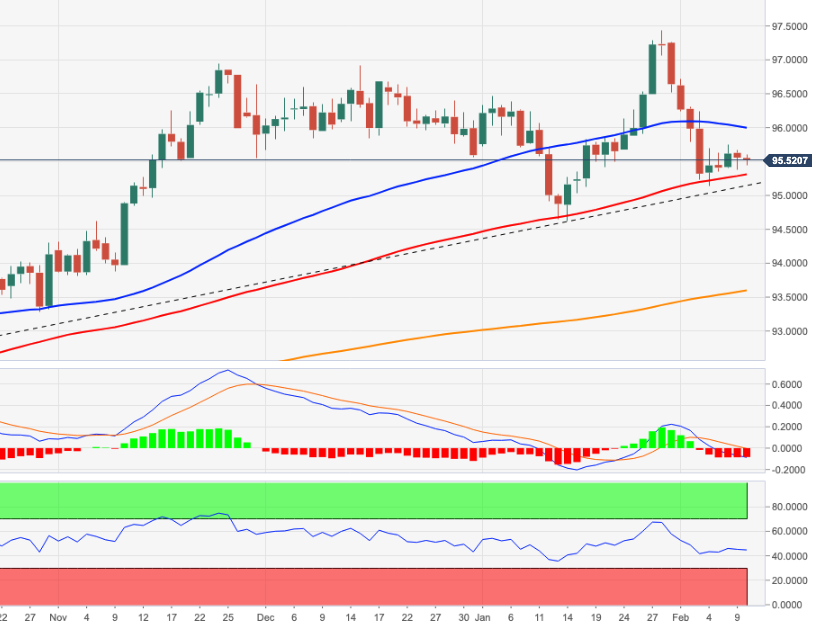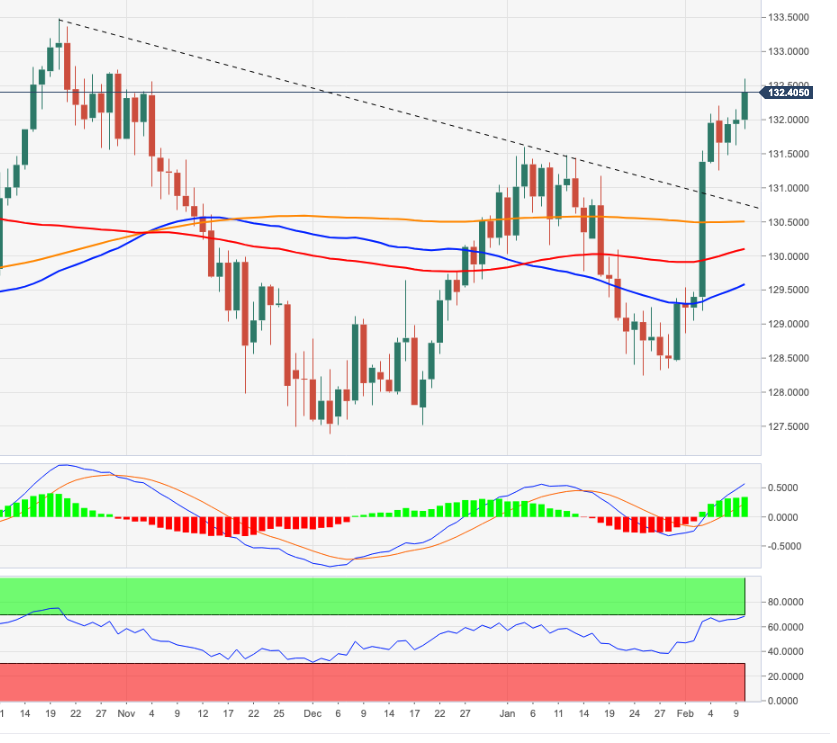- Analytics
- News and Tools
- Market News
CFD Markets News and Forecasts — 10-02-2022
- AUD/NZD bulls stay in control along with the medium term bullish trend.
- NZD inflation expectations will be a key event for Asia on Friday.
- RBA acknowledges the possibility of a need for a rate hike in 2022.
At 1.0735, AUD/NZD is flat on the session so far although it has moved between a low of 1.0719 and 1.0739 as the bulls step in to try and hold the price from sliding below the hourly structure. The pair has otherwise been gliding along an ascending trendline that had been established at the start of December 2021 as the Australian dollar finds support on central bank sentiment.
The Reserve Bank of Australia has been pushing back on the global push for rate hikes near term, but the markets expect that to change considering the prospects for higher global inflation risks. Moreover, the domestic labour market is hotting up. ''The sharp drop in preference-based underemployment underscores how tight the labour market is,'' analysts at TD Securities explained. ''Workers who would prefer and are available to work more hours is declining sharply. The risks highlighted above suggest the unemployment rate could hit 3% by the end of 2022, in line with the RBA's upside scenario.''
-
RBA Lowe: ''Plausible we could raise rates later this year''
Meanwhile, the Reserve Bank of New Zealand’s inflation expectations survey will be a key event for Asia today and it could post a 30-year high, analysts at Westpac explained. ''That could motivate markets to price even more into rates and the NZD, even though pricing is already quite full.''
''Multi-month, though, we continue to expect the USD to benefit from the Fed’s looming tightening cycle until around mid-2022. That should at least slow any NZD rallies, and could even cause a final dip to below 0.6500. The latter scenario could be a medium-term buying opportunity.''
AUD/NZD technical analysis
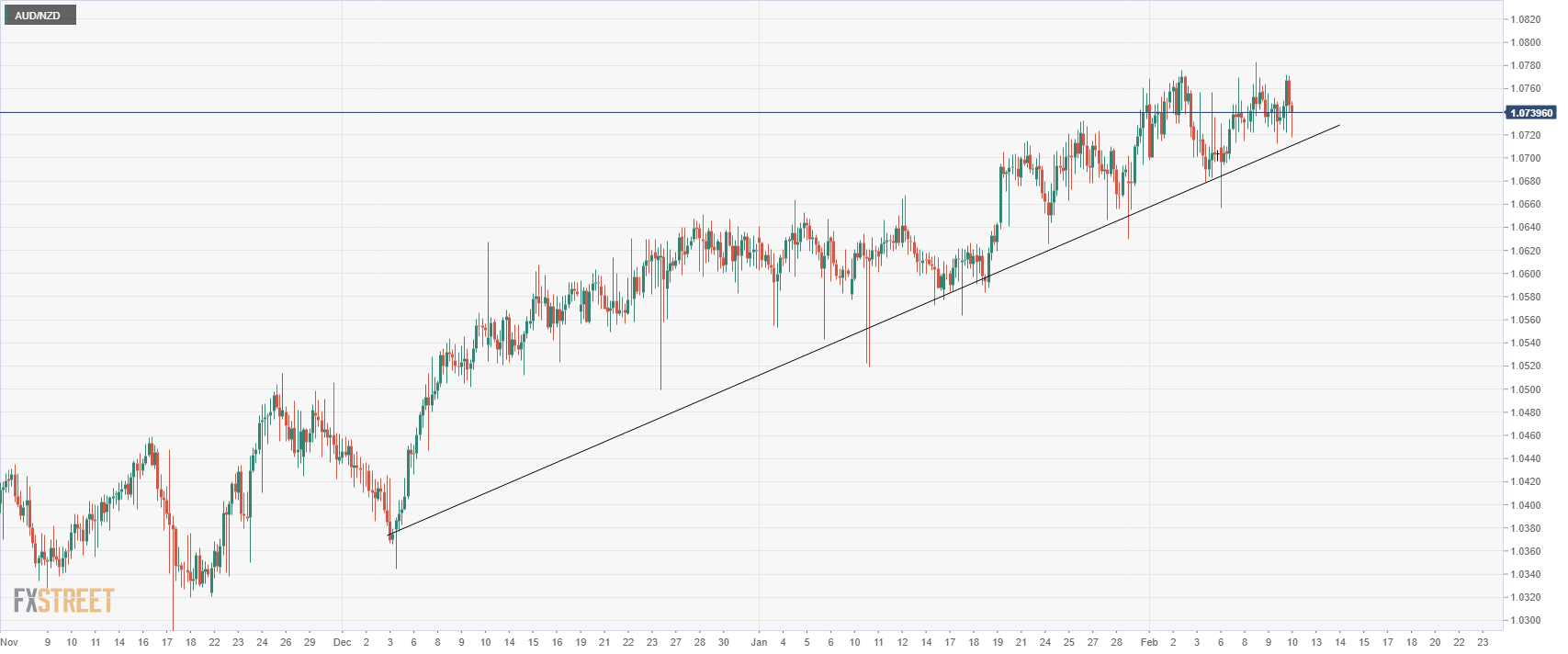
The 4-hour chart above shows the price hugging the ascending trendline support. While there are prospects of higher highs to come, 1.08 could be the limit when taking into account the daily resistance as follows:
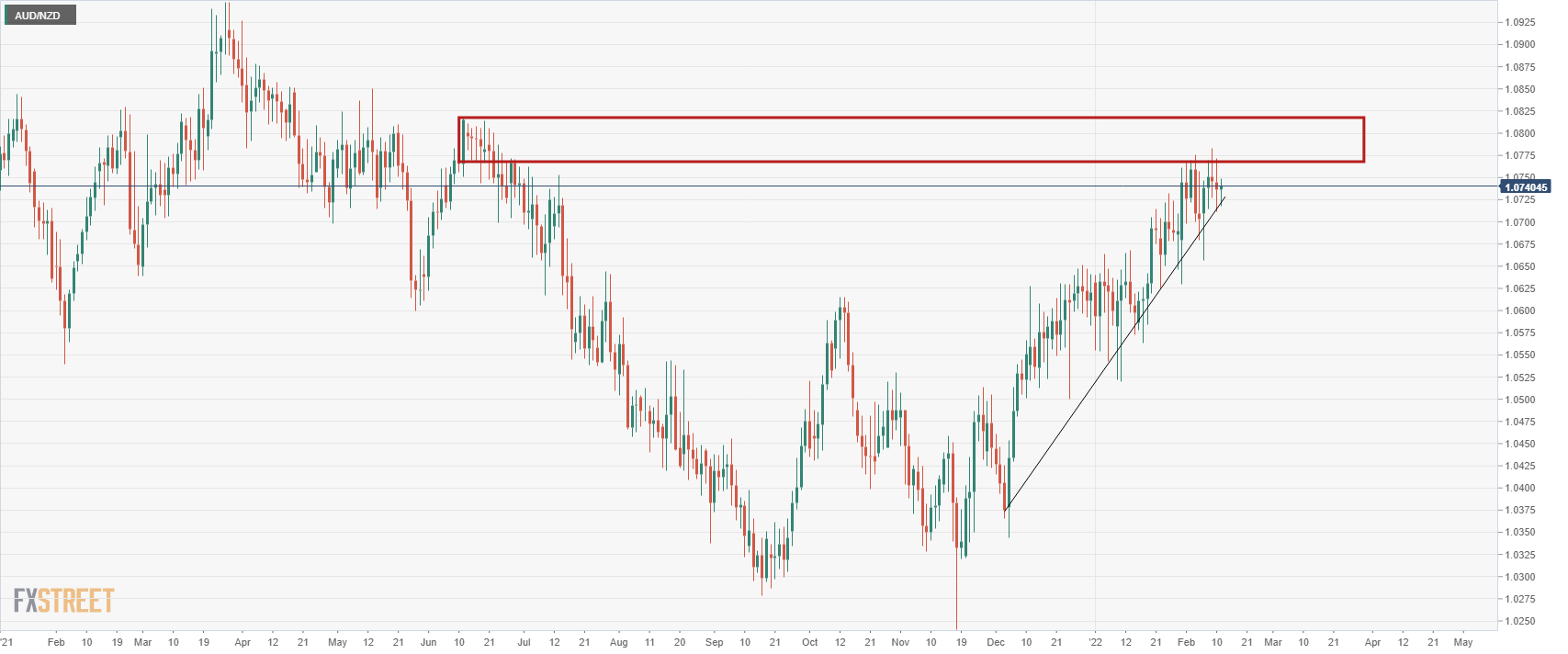
The Reserve Bank of Australia's Phillip Lowe has said that it is ''plausible we could raise rates later this year depending on economy.'' He added that he hasn't said rates won't go up.
AUD could get a lift on such rhetoric, but there hasn't been any knee-jerk reaction thus far.
More to come...
Raising the European Central Bank's main interest rate now would not bring down record-high eurozone inflation and only hurt the economy, ECB President Christine Lagarde said in an interview published on Friday.
Key quotes
Raising rates would not solve any of current problems.
Highly unlikely that oil price will continue climbing at 2020-2022 pace.
Confident that inflation will fall back in the course of the year.
We are getting closer to goal, that would allow us to gradually withdraw some interventions.
We don’t want to choke off the recovery.
The greenflation debate is exaggerated.
In most euro area countries, including Germany, wage demands are very moderate.
EUR/USD drops
Following the downbeat comments from ECB President Lagarde, EUR/USD prices drop back to 1.1400.
Read: EUR/USD Price Analysis: Stays directed to 1.1500 despite recent pullback
- The lack of catalysts of the GBP/JPY would keep it subject to market mood.
- GBP/JPY traders beware of the developments of the GBP/USD as USD strength looms, courtesy of higher US Treasury yields.
- GBP/JPY is upward biased and would accelerate its uptrend if GBP bulls reclaim 158.00.
On Thursday, the GBP/JPY gained some 0.58%. The rally on the GBP/JPY was triggered by the GBP/USD price action, which jumped on the release of high US inflation, towards 1.3643, retreating later on the day, as money market futures have priced in a 100% chance of the US central bank hiking rates 50 bps, on the March meeting. At the time of writing, the GBP/JPY is trading at 157.35.
The market mood is risk-off. US equities recorded losses in the cash market, while Asian equity futures are headed towards a lower open, as market players flight towards safe-haven assets.
GBP/JPY Price Forecast: Technical outlook
Putting those factors aside, the GBP/JPY witnessed a rally of 200-pips. During the Asian session, the GBP/JPY was subdued, but as American traders got to their desks, alongside the overlap with European markets in full swing, spurred a jump near 158.00. Once GBP bulls struggled at 158.00, the cross-currency fell towards 157.33.
The GBP/JPY first resistance would be a five-month-old downslope trendline lying around the 157.45-65 region. Once cleared, the GBP/JPY next resistance would be February 10 daily high at 158.06, followed by October 20, 2021, daily high at 158.22.
On the flip side, the GBP/JPY first support would be 157.00, followed by a one-month-old downslope trendline broken on February 10, around 156.60-70, and February 10 daily low 156.19.
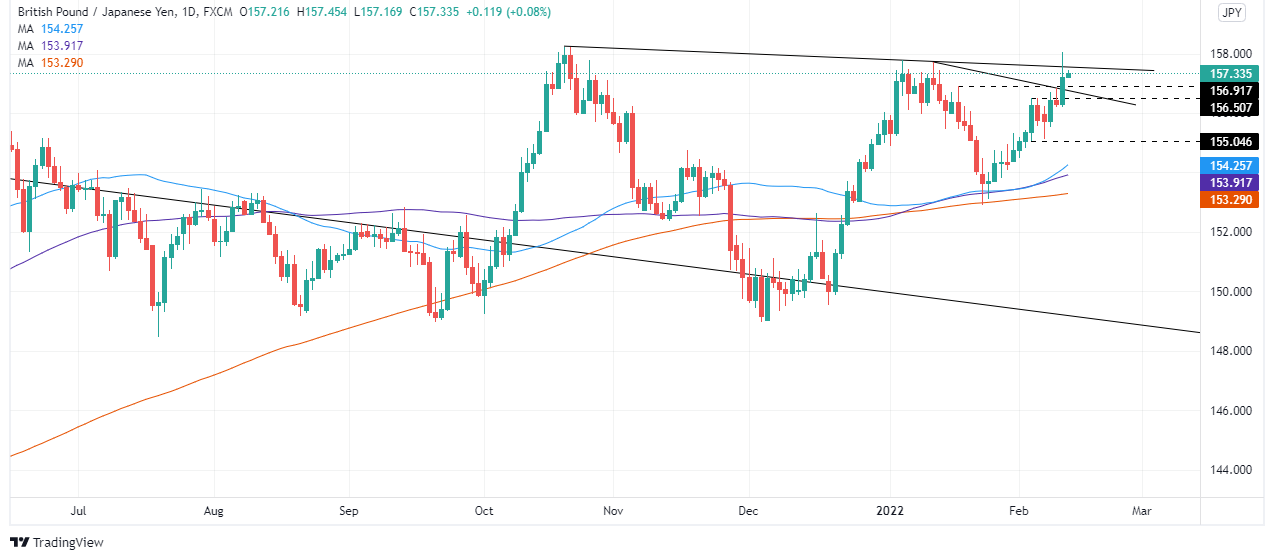
US President Biden: Things could get crazy rapidly in Ukraine
More to come
“We have scope to wait and see how the data develop and how some of the uncertainties are resolved,” said Reserve Bank of Australia (RBA) Governor Philip Lowe during a testimony at a virtual hearing before the House of Representatives Standing Committee on Economics on early Friday morning in Asia-Pacific region.
Key quotes
Estimate that GDP increased by around 5 percent over 2021 and are expecting GDP growth of around 4¼ per cent over 2022 and 2 percent over 2023.
Upswing in business investment is also under way.
The board is prepared to be patient.
Macroeconomic policy settings are supportive of growth.
We have scope to wait and see how the data develop and how some of the uncertainties are resolved.
I recognise that there is a risk to waiting but there is also a risk to moving too early.
Forward-looking indicators suggest further growth in jobs over the months ahead.
Moving too early could put employment goal at risk.
Main source of uncertainty about the outlook continues to be covid-19.
Stronger the economy and the more upward pressure on prices and wages, the stronger will be the case for an increase in interest rates.
Sharp pick-up in inflation in parts of the world, especially in the united states, has come as a surprise and is an additional source of uncertainty.
Too early to conclude that inflation is sustainably in the target range.
We expect a further lift in underlying inflation.
Further pick-up in overall wages growth is expected.
It is entirely possible that countries with higher inflation rates will need a bigger adjustment in interest rates than currently anticipated.
Official link to full statement
AUD/USD pays a little heed
AUD/USD keeps the latest pullback from three-week high following the downbeat statements from RBA’s Lowe. The risk barometer’s previous declines could be linked to the strong US inflation data.
Read: AUD/USD Price Analysis: Committed and late bulls were knocked down to size, eyes on RBA Lowe, 0.7200/0.7150
- EUR/USD bulls take a breather after refreshing 2022 peak.
- 50-SMA, 200-SMA defend short-term buyers, two-week-old previous support guards upside.
- Sluggish MACD, firmer RSI suggests slow grind to the north.
EUR/USD braces for a fresh upside, despite stepping back from a fresh yearly high to 1.1430 during early Friday morning in Asia.
The major currency pair bounced off 50-SMA to cross the short-term horizontal area following the hot US inflation release.
However, the support-turned-resistance from January 31, around 1.1505 at the latest, restricted the pair’s upside and pulled it back towards the aforementioned SMA level of 1.1385 by the press time.
Given the mostly steady MACD and RSI line beyond 50.00, EUR/USD prices are likely to portray another bounce off the SMA support, if not then the 200-SMA level near 1.1335 will offer another chance to the pair buyers.
It should be noted, however, that the quote’s weakness past 1.1335 will welcome EUR/USD bears targeting January’s bottom surrounding 1.1120.
Alternatively, a three-month-old horizontal area surrounding 1.1480-85 preceded the previous support line near 1.1505 to challenge the EUR/USD pair’s short-term upside moves.
Adding to the upside filters is the October 2021 bottom surrounding 1.1530.
Overall, EUR/USD braces for a bumpy road to the north.
EUR/USD: Four-hour chart
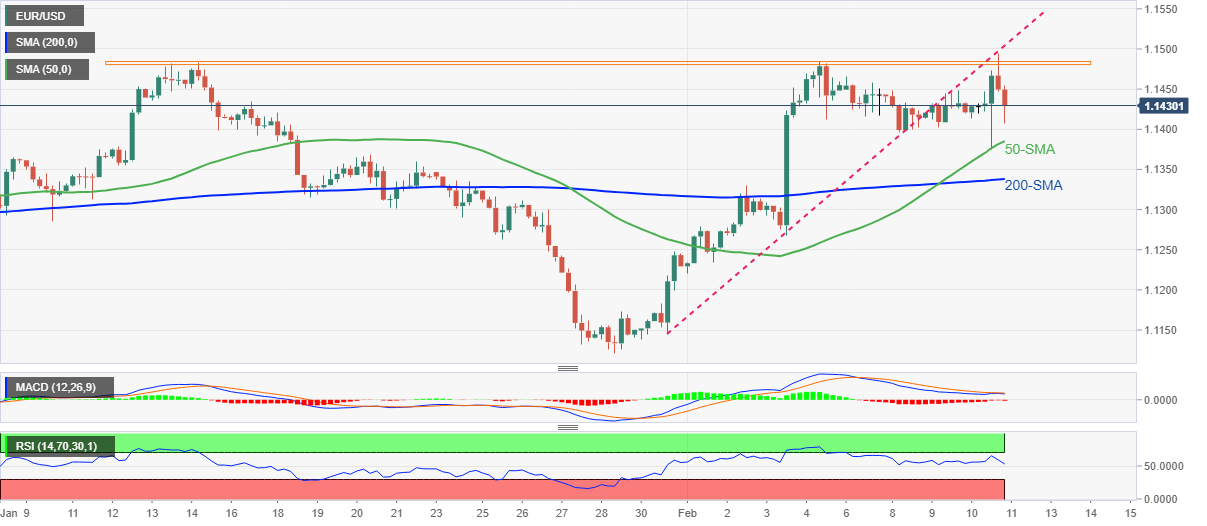
Trend: Further upside expected
- AUD/USD bulls have been thrown back by the bears as the US dollar firms.
- The price of AUD/USD is now in a phase of consolidation.
- RBA Lowe is speaking at the top of the hour.
governor Philip Lowe is speaking at the top of the hour which could be some further volatility into the pair in what has already been a turbulent time for the Aussie. Lowe is appearing before the House of Representatives Committee on Economics which could give some insight into the path of rate hikes to come from the central bank.
AUD/USD H1 chart
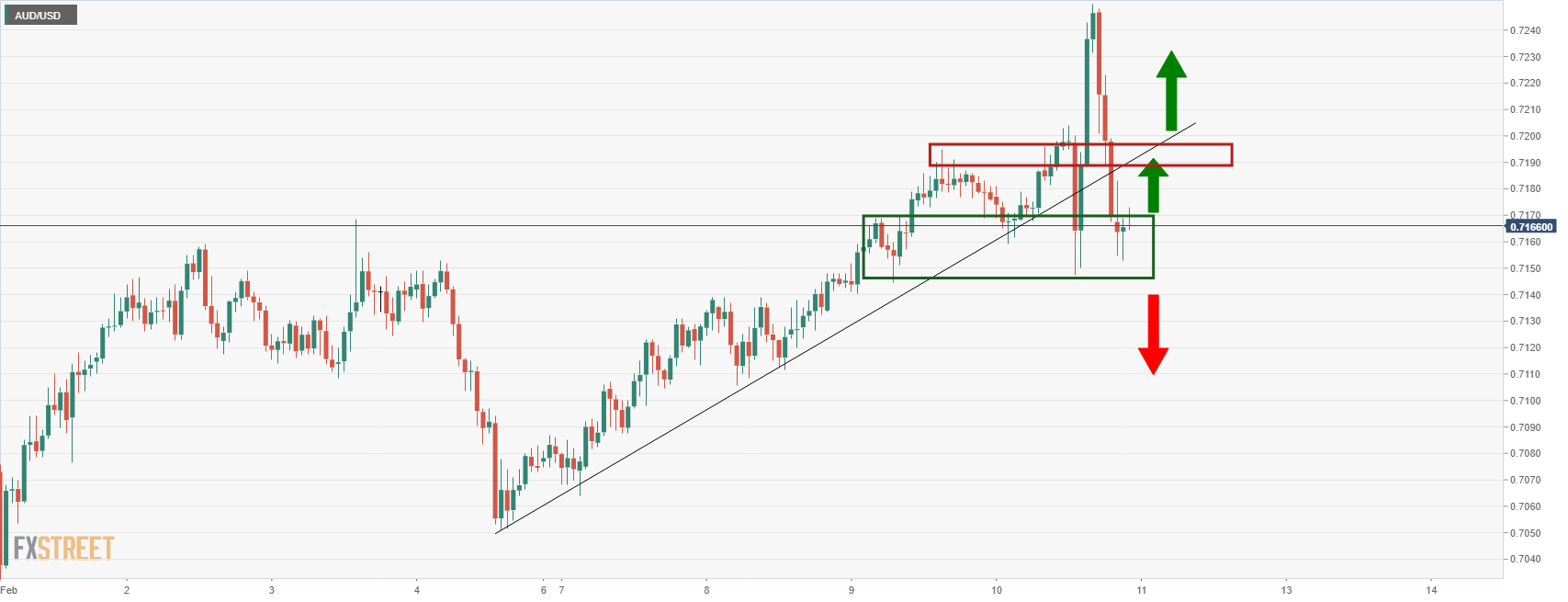
0.7200 and 0.7150 are key levels for the rest of the week.
Meanwhile, as per the pre-US inflation data analysis from the prior session, AUD/USD Price Analysis: Bulls eye a break of 0.72 the figure, the price has followed suit, initially testing the 0.72 figure before crashing back into the bear's layer again, as follows:
AUD/USD prior analysis
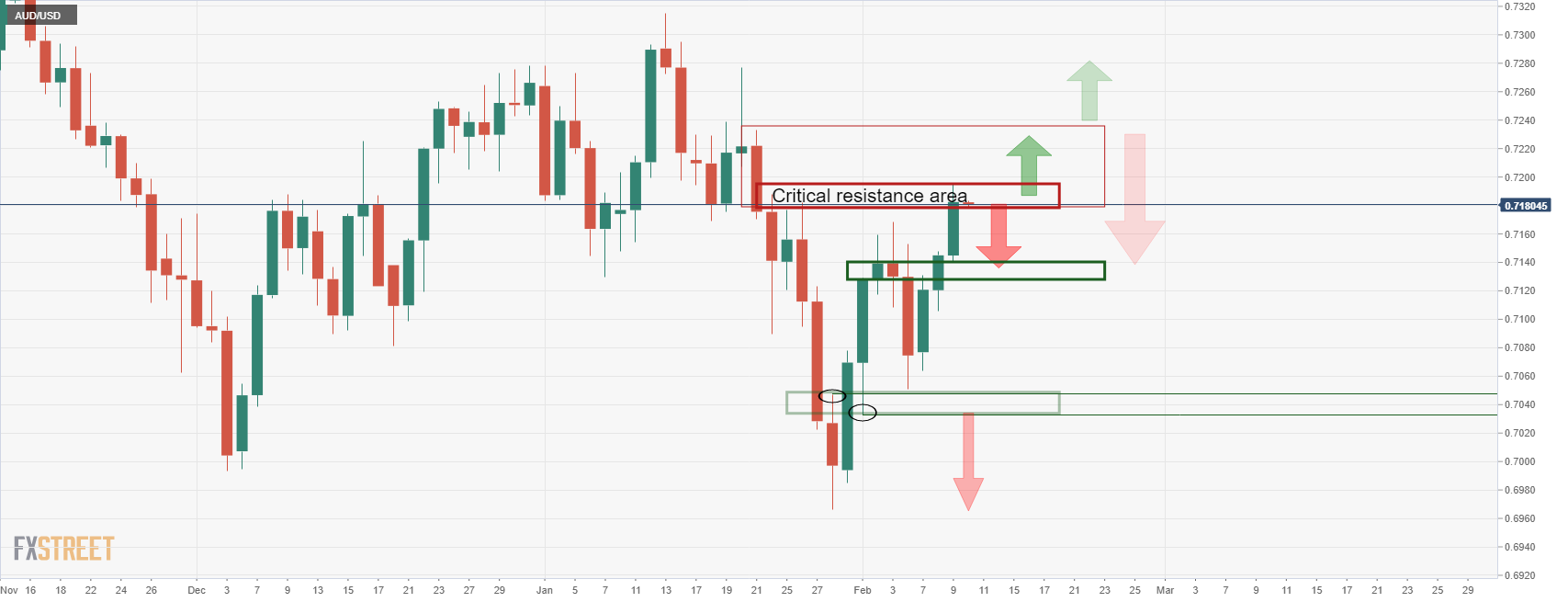
The price broke the critical resistance area as follows:
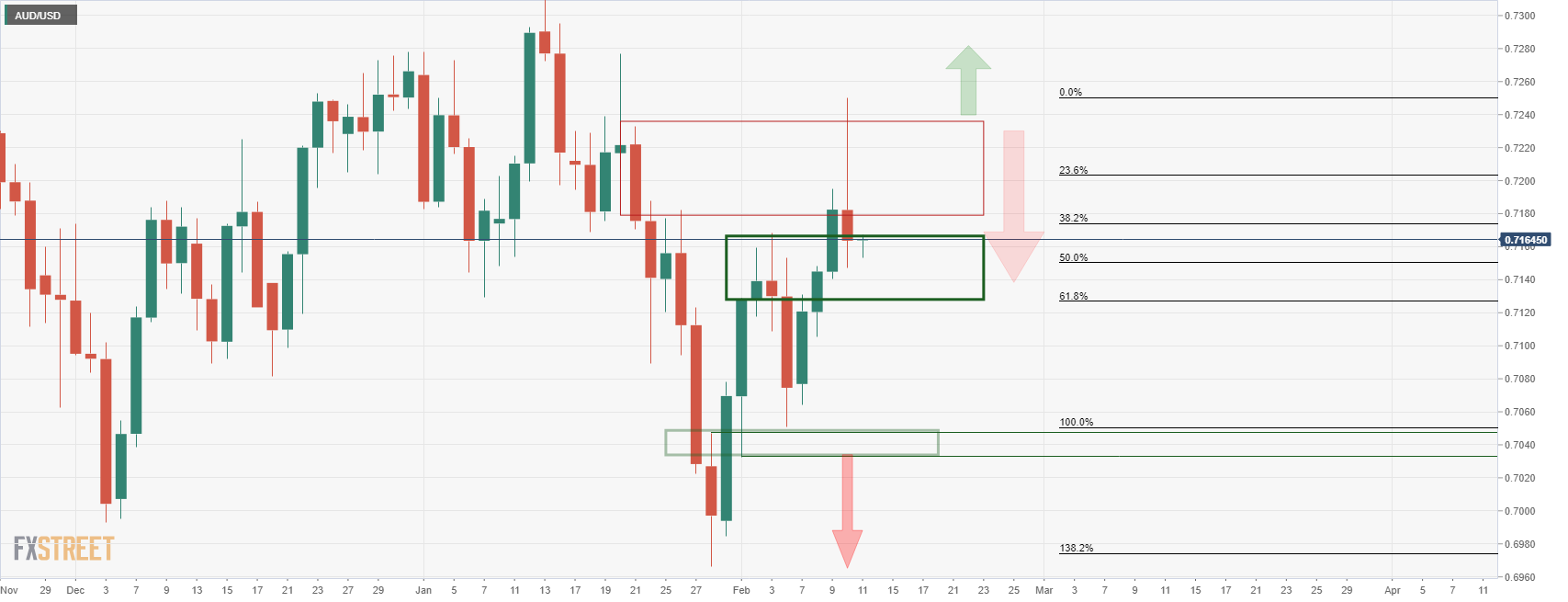
However, the W-formation was always going to be problematic for the bulls as explained in the prior analysis. The price has subsequently fallen back into the old highs where it would be expected to consolidate as traders muddle through the various implications of sky-high inflation on a macro scale.
Bar any fundamental shock, such as an emergency rate hike from the Federal Reserve or some coordinated agreement between global central banks, the greenback would still be expected to remain underpinned. With that being said, the commodity currencies could fare well against the higher inflationary backdrop.
- The NZD/JPY advances as the North American session winds down, up some 0.25%.
- The market sentiment is downbeat, as US equity indices finished in the red.
- NZD/JPY upward move stalled at the 200-DMA, but NZD bulls remain in charge.
The NZD/JPY retreats from weekly tops after inflation in the United States reaches 7.5%, a level last seen in August 1982, causing a sell-off in the US equity markets amid a risk-off market mood. Despite the aforementioned, the NZD/JPY clings to gains, trading at 77.41 at the time of writing.
During the North American session, financial markets have been volatile. High elevated prices, reported by the US Labor department, increased the odds of the US central bank’s 50 bps rate hike. Initially, the US Dollar Index, a gauge of the greenback’s value against its peer, shot through the roof, followed by a fall to the 95.40 area for a 0.20% loss.
However, in the last hour, the DXY rebounded, sitting at 95.60, aligned with higher US Treasury yields, led by the 10-year benchmark note at 2.052%, a gain of twelve basis points.
NZD/JPY Price Forecast. Technical outlook
Putting those factors aside, the NZD/JPY initially broke upwards, but the move stalled at the 200-day moving average (DMA) at 77.98, followed by a drop to the February 9 daily high at 77.30.
That said, the NZD/JPY first resistance would be the 200-DMA at 77.98. Breach of the latter would expose the 100-DMA at 78.36, followed by the January 5 swing high at 79.22.
On the flip side, the NZD/JPY first support is 77.30. Once cleared, the next support would be the 77.00 figure, followed by the February 9 daily low at 76.65.

- USD/CAD bulls eye the 1.2780's for the days ahead.
- The bulls are back in control within the daily sideways channel.
USD/CAD has been thrown left right and centre on the day in the aftermath of the US inflation data. In the prior day's analysis, USD/CAD Price Analysis: Bulls are moving in at critical H1 support, and
USD/CAD bulls correcting to the 38.2% Fibo, traders are in anticipation of US CPI, the price had found stability in the hourly lows but it has carved out a lower low as follows:
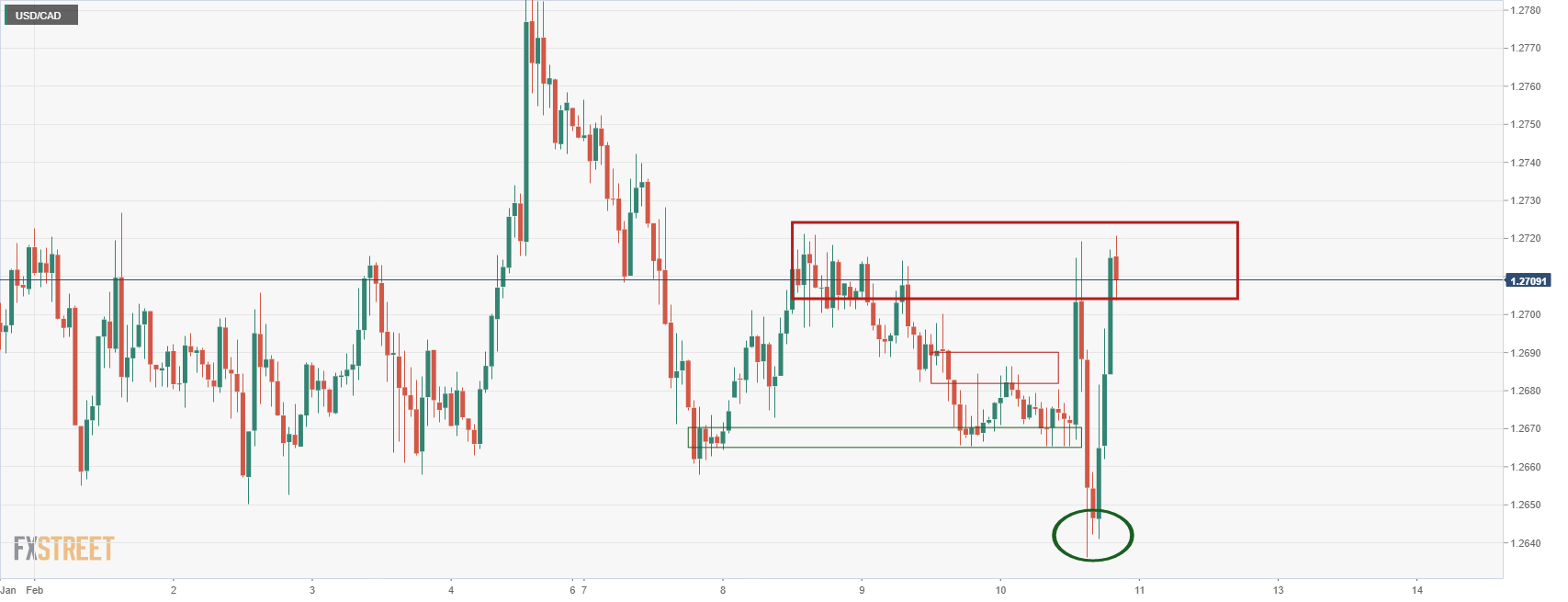
The spike lower would have cleared out some of the stale sell stops below the daily support which has resulted in a renewed bullish impulse on the daily chart as follows:
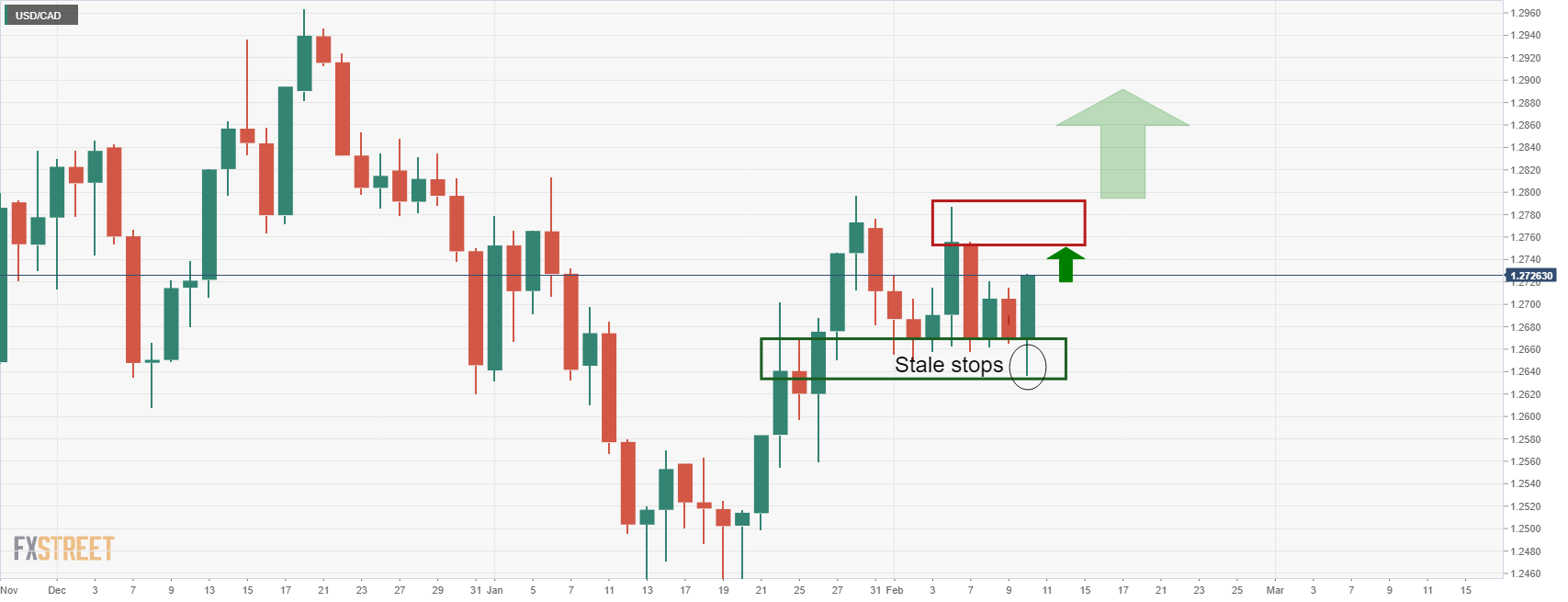
The buyers picked up a bargain below the lows and added length back into the structure to take out the prior hourly resistance. This has resulted in a break of daily highs with eyes on the 1.2780's and the Feb highs for the days ahead.
- The cross-currency is almost flat during the day, as both currencies are the main gainers in the FX complex.
- The EUR/GBP is trapped between the 50 and the 100-DMA, a 36-pip range.
- EUR/GPB is neutral biased but could shift neutral-upwards with an upbreak of the 100-DMA.
The EUR/GBP is barely down during the North American session. At the time of writing, the EUR/GBP is trading at 0.8413.
A risk-off market mood looms the global financial markets. The US Department of Labor reported that US inflation for January rose 7.5% more than estimated, spurring a sell-off in US equity markets. In the FX complex, the history is different. The gainers are the EUR and the GBP, while the laggards are the CAD and the JPY.
That said, the EUR/GBP Thursday’s price action was confined to a 36-pip trading range, as investors’ eyes were on US macroeconomic data.
EUR/GBP Price Forecast: Technical outlook
Since the last week, the EUR/GBP jumped from under 0.8350 towards 0.8478, following the Bank of England (BoE’s) rate hike, and the European Central Bank (ECB) pivot forwards a tilted “hawkish” monetary policy stance.
At press time, the EUR/GBP sits comfortably between the 50-day moving average (DMA) at 0.8413 and the 100-DMA at 0.8449, suggesting the pair as neutral biased. Nevertheless, an upside break of the 100-DMA would shift the trend to neutral-upwards because the 200-DMA resides above the exchange rate, resting at 0.8501. In that outcome, the first resistance would be the 200-DMA at 0.8501. Breach of the latter would expose December 20, 2021, high at 0.8550, followed by a nine-month-old downslope trendline around the 0.8590-0.8600 range.
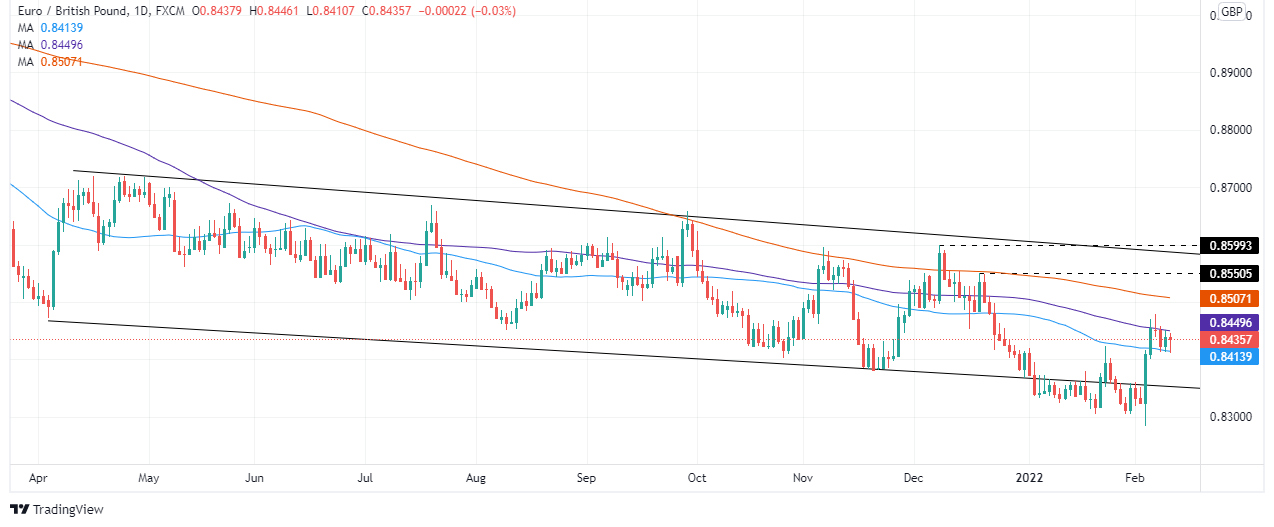
- NZD/USD pressured as Fed speakers play up the hawkish outlook following hot US CPI.
- NZD/USD bulls meet a wall of resistance and suffer heavy supply.
- The bears could be encouraged to move in for a test of critical support on the daily time frame.
NZD/USD traders were taken on a ride of volatility on Thursday as the markets positioned for macro inflationary pressures which flows made their way through every facet of the forex space. The commodity complex was bid on the inflation hedge play which initially supported the kiwi after the knee-jerk bid in the greenback before it was met with heavy supply again in midday trade.
At 0.6685 during the time of writing, NZD/USD is around flat on the day after travelling between a low of 0.6652 and a high of 0.6732 in the final hours of Wall Street's trade. The bird spiked lower after the Federal Reserve James Bullard spoke out over the hot US inflation data, commenting that the central bank could be considering meeting rate hikes. He has said that he favours a 50bp hike in March and 10bps by July.
''Volatility remains the order of the day. Higher US yields are battling things like higher commodity prices for attention; while rates have had less of an influence on FX of late, the knee-jerk reaction to higher US bond yields tends to be NZD-negative,'' analysts at ANZ Bank explained.
NZD/USD technical analysis
As per the prior analysis, whereby it ws noted:
The ''NZD/USD bulls are taking charge in a significant correction,'' that was moving ''in on old lows near 0.67 the figure and towards the neckline of the M-formation near 0.6733,'' the price reache dthe target on Thursday.
This resided between the 50% mean reversion and the 61.8% ratio as follows:
NZD/USD prior and live analysis
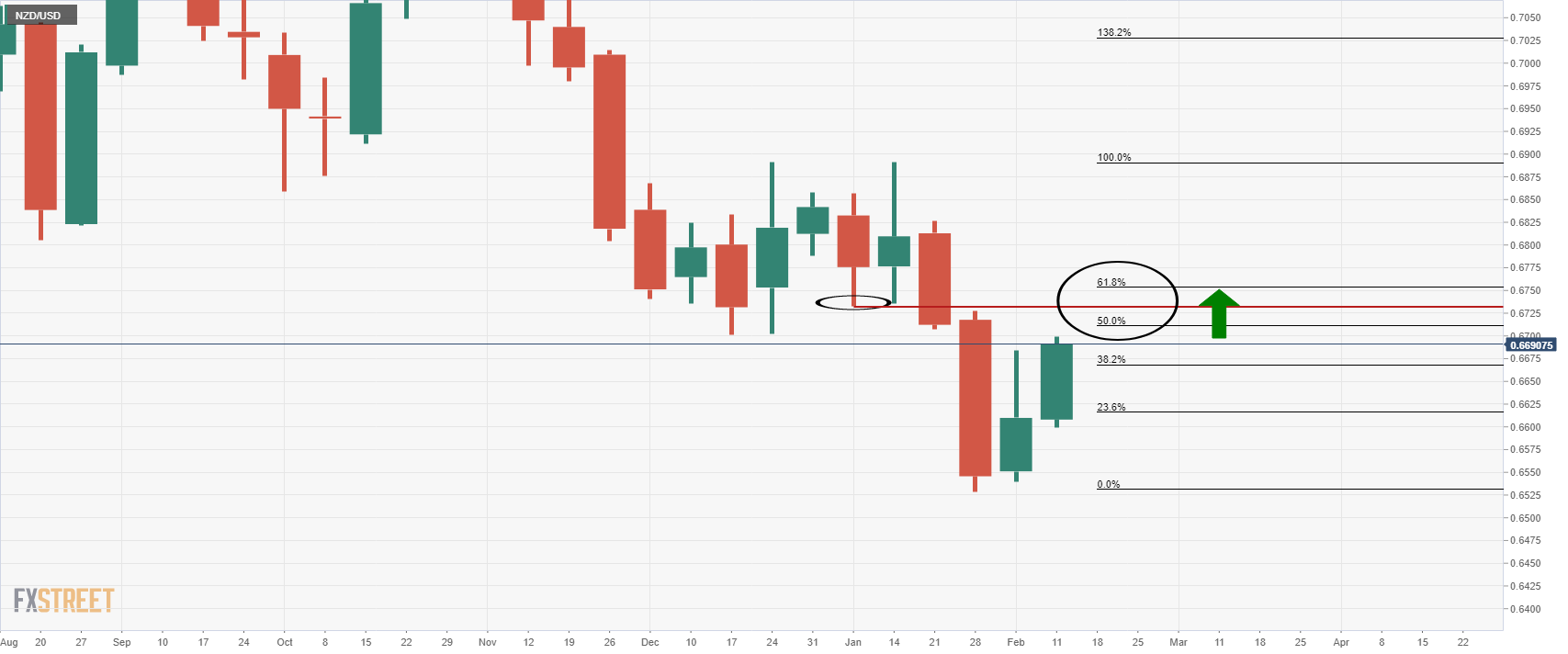
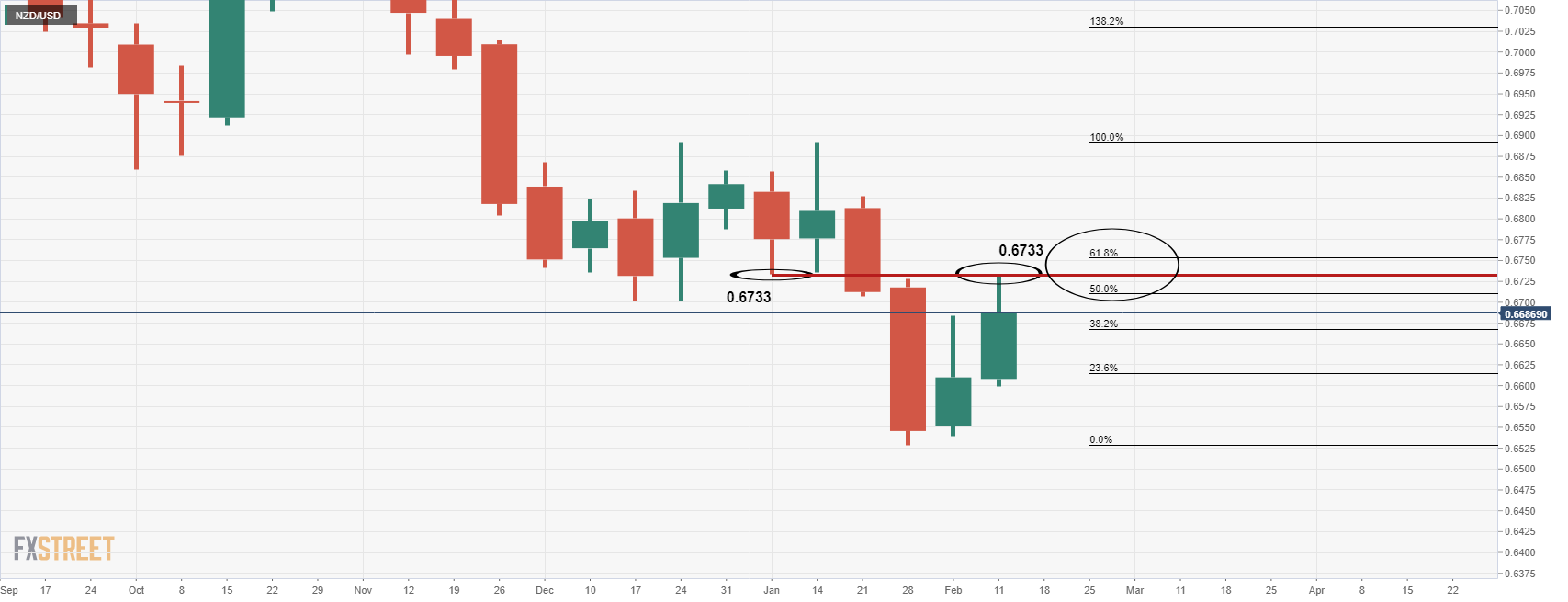
NZD/USD daily chart
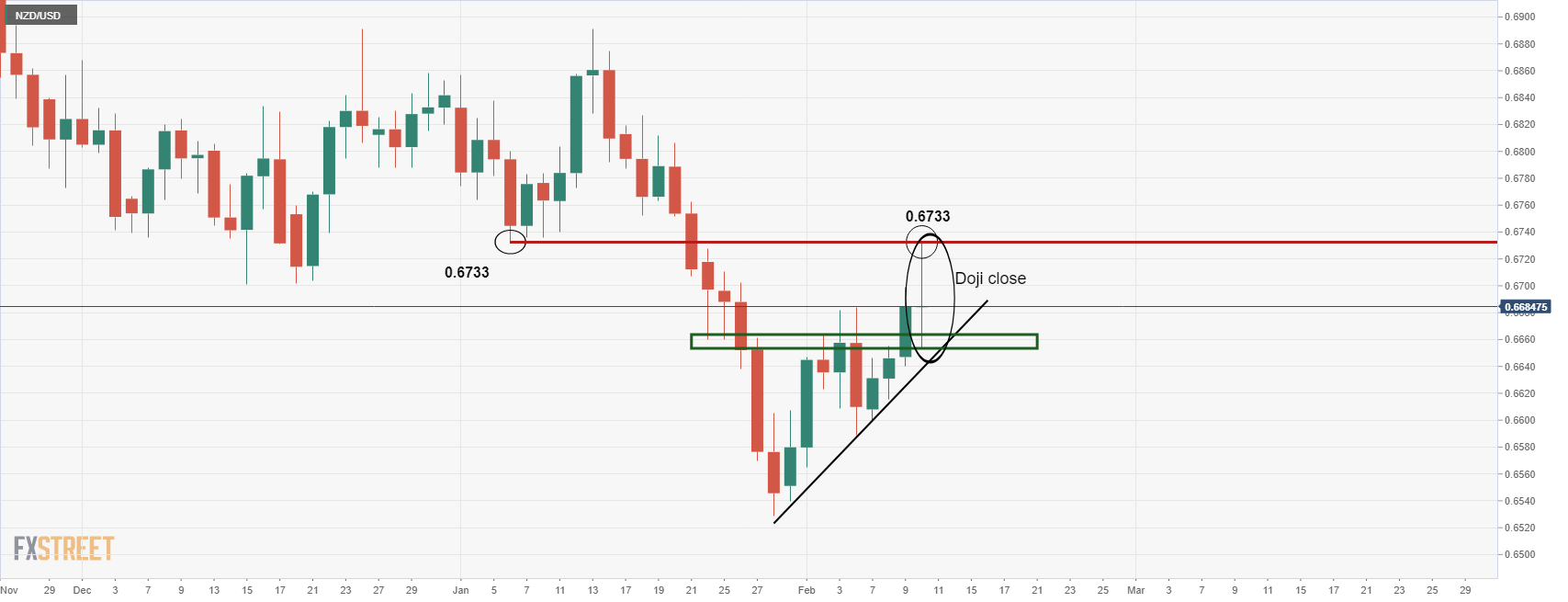
The Doji candle, if followed by a bearish close on Friday, could set case for a downside continuation for next week's business:
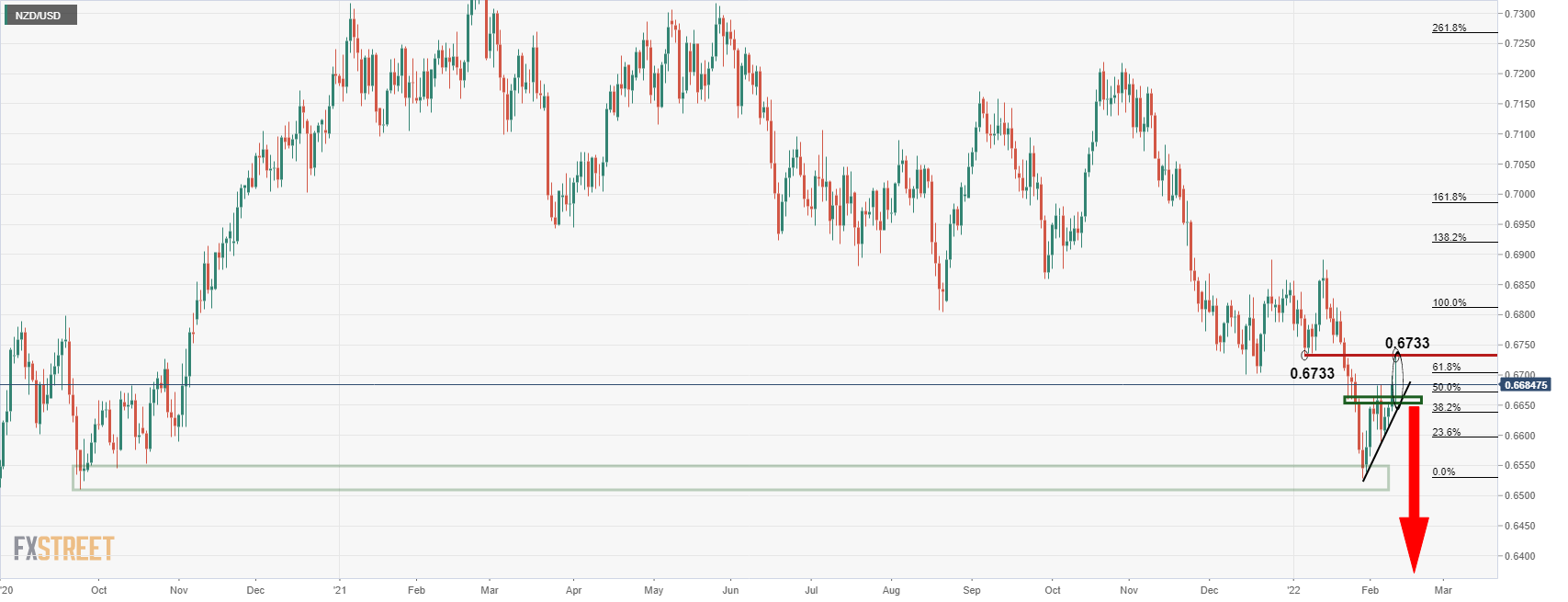
NZD/USD weekly chart
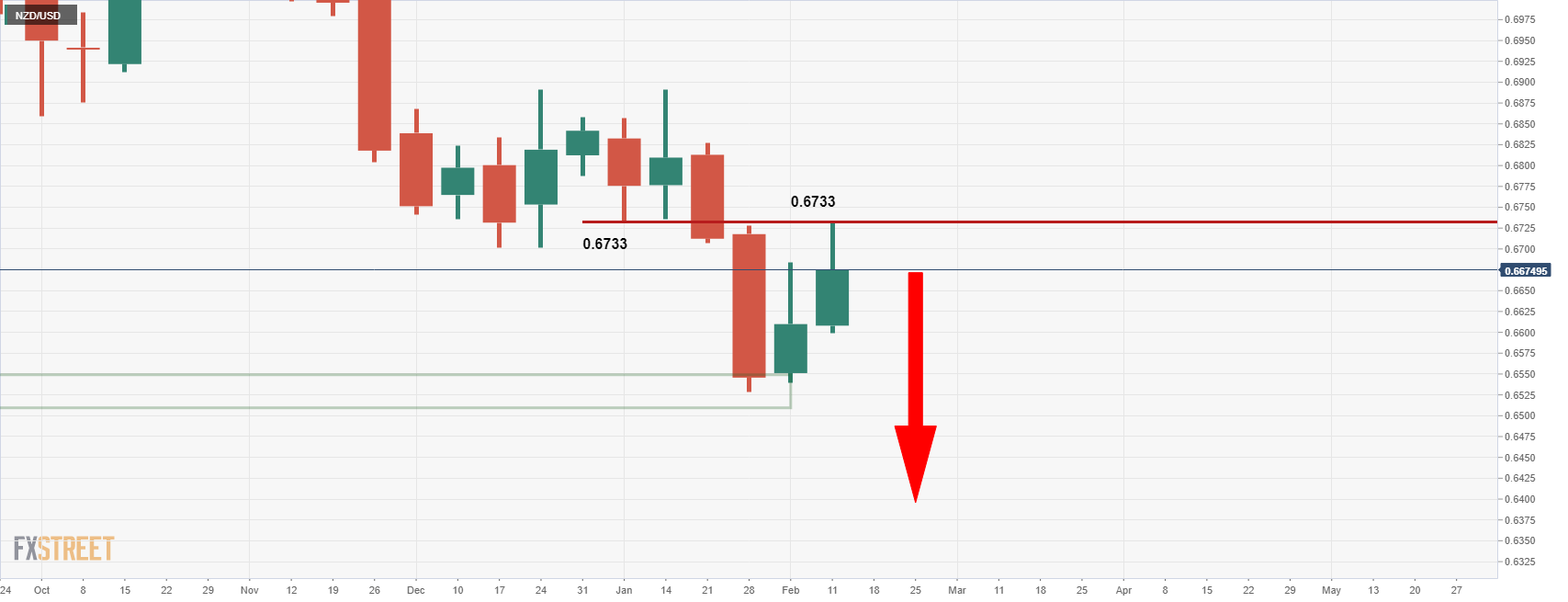
What you need to know on Friday, February 11:
Major pairs were quite volatile on Thursday following the release of US inflation figures. The US Consumer Price Index soared to 7.5% YoY in January, higher than the 7.3% expected. The core reading printed at 6%, also above the market’s forecast. The headline spurred a short-lived dollar’s rally, although the greenback quickly changed course and moved from daily highs to fresh weekly lows against most of its major rivals.
The EUR/USD pair peaked at 1.1394, a fresh 2022 high, stabilizing at the 1.1460 price zone. Earlier in the day, the European Commission raised its inflation expectations for this year from 3.5% but is still expecting it to decline in 2023, seeing it at 1.7%. Prices pressure was blamed on supply disruption and the energy crisis, exacerbated by geopolitical tensions between Russia and Ukraine. Also, Bundesbank Governor Joachim Nagel indicated that the European Central Bank might raise rates later this year.
The GBP/USD pair holds on to intraday gains just above the 1.3600 region after hitting a monthly high of 1.3643.
Commodity-linked currencies were unable to hold on to intraday gains. The AUD/USD pair is marginally higher at around 0.7180, while USD/CAD is up for the day, trading at around 1.2700.
RBA Governor Philip Lowe will testify at a virtual hearing before the House of Representatives Standing Committee on Economics and may refer to the monetary policy.
Crude oil prices ended the day little changed. The OPEC boosted its forecast for 2022 crude demand by 100K barrels per day but reported that output rose by 64K bpd in January, lagging the pledged increase by OPEC+. WTI trades at $89.60 a barrel.
Gold jumped to $1,841.83 a troy ounce but retreated towards the current 1,830 region.
Wall Street edged lower, with the DJIA shedding over 500 points. The poor tone of equities helped the greenback to recover some ground ahead of the daily close.
US Treasury yields soared. The yield on the US 10-year Treasury note soared to 2.02% above the 2% threshold for the first time since 2019, while the 2-year note yielded as much as 1.51%. Following the release of inflation data, the chances of a rate hike of 50 basis points in March rose to nearly 50%.
Top 3 Price Prediction Bitcoin, Ethereum, Ripple: Cryptos set for fireworks this weekend
Like this article? Help us with some feedback by answering this survey:
- The USD/JPY rallied towards 116.33, but USD bulls failed to sustain the rally, eases to high 115.00s.
- US Treasury yields advance, but the greenback bucks the trend, as it falls 0.10% during the day.
- USD/JPY keeps upward biased, confirmed by the upbreak of a month-old trendline.
Following the US inflation report that showed that prices rose by 7.5% y/y in January, the USD/JPY advances 0.31% in the North American session. At the time of writing, the USD/JPY is trading at 115.86.
The financial market mood dampened as the New York session progressed. US equity indices are recording losses after the US Labor Department noted that the Consumer Price Index (CPI) increased to levels last seen in August 1982. The core CPI reading, which excludes volatile items like food and energy, expanded above the 6% threshold (y/y), a tenth higher of expectations.
The US Dollar Index, a gauge of the greenback’s performance against a basket of six currencies, edges lower 0.10%, sitting at 95.40, failing to track the rise of US Treasuries, led by the 10-year benchmark note, sitting at 2.012%, gaining seven basis points.
USD/JPY Price Forecasts: Technical outlook
The USD/JPY keeps the upward bias intact. The upbreak of a one-month-old trendline accelerated the move towards 116.00, which was broken after the release of US CPI, though it fell short of piercing the YTD high at 116.35.
As USD bulls take a breather, after a steeper trip over 116.00, the USD/JPY sits comfortably above November 24, 2021, daily high at 115.52. That said, the USD/JPY first resistance would be 116.0. Breach of the latter would expose the YTD high at 116.35, followed by a challenge of a 24-month-old downslope trendline around 117.00. A clear break of that ceiling level would pave the way towards January 2017 swing high at 118.61.
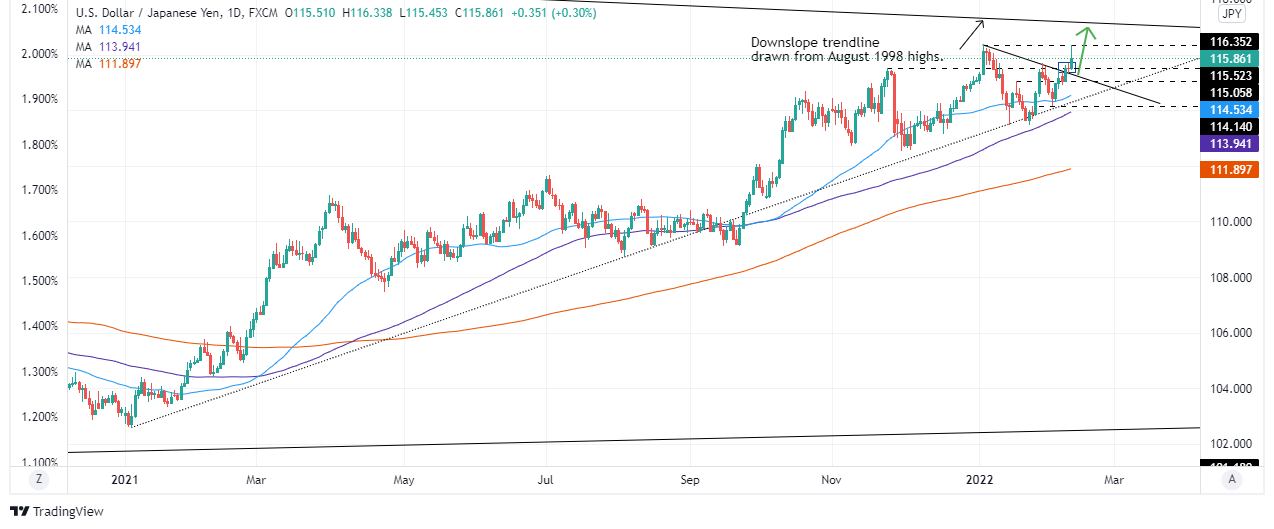
Banxico hikes overnight rate by 50bps to 6%, as expected, as it sought to keep price pressures in check with inflation running hot.
The central bank explained that the board was not unanimous on rate decision with 4 board members that voted to hike the key rate to 6.0% with1 board member that voted to hike the key rate to 5.75%.
The central banks said inflationary pressures have been greater and have lasted longer than anticipated and that the board will closely watch inflationary pressures in upcoming monetary policy meetings.
The inflation expectations for 2022 and 2023 increased again, while medium-term expectations decreased slightly and those for longer terms have remained stable at levels above the target.
The forecasts for headline and core inflation were revised upwards, especially for 2022 and the first quarter of 2023.
The central bank says that the balance of risks for the trajectory of inflation within the forecast horizon remains biased to the upside.
The central bank says it evaluated magnitude, diversity of shocks that have affected inflation and its determinants, along with the risk of medium - and long-term inflation expectations and price formation becoming contaminated.
USD/MXN is unchanged on the move whereby the US inflaiton data has played a bigger role in the currency pair's volatility on the day. USD/MXN has ranged between a low of 20.3492 and a high of 20.57.5740.
- The EUR/USD reaches a new YTD high at 1.1495, 5-pips near 1.1500.
- The market sentiment is mixed due to the higher than expected US inflation number.
- Money market futures show a 71% chance of the US central bank hiking 50bps following Fed’s Bullard remarks.
- EUR/USD is neutral-upward biased, but it would need a daily close above February 7 daily high.
Following a higher than expected January’s US inflation report, the EUR/USD is rallying in the North American session. At the time of writing, the EUR/USD is trading at 1.1476.
Financial markets mood is mixed after the US Department of Labor revealed that the Consumer Price Index (CPI) rose to 7.5% y/y, a level last seen in August 1982. Additionally, the core CPI, which excluded food and energy, pierced the 6% threshold on an annual-based figure. Both readings were higher than estimations, further cementing the case of a Federal Reserve rate hike in the March meeting.
The CME FEDWATCH Tool, a gauge of market players’ expectations of the Federal Funds Rate (FFR), has fully priced in a 25 bps increase to it. Furthermore, there is a 71% chance of a 50 bps increase, which appears aggressive, as base effects could ease some.
Nevertheless, on March 10, the US economic docket would feature CPI for February, which could significantly influence Federal Reserve policymakers of hiking more aggressive than expected.
At press time, crossing the wires, St. Lous Fed President James Bullard said that “I’d like to see 100 basis points in the bag by July 1,” as reported per Bloomberg.
Meanwhile, the Eurozone economic docket was pretty light, though it featured the European Central Bank (ECB) Chief Economist Philip Lane. Lane said that “since bottlenecks will eventually be resolved, price pressures should abate and inflation return to its trend without a need for a significant adjustment in monetary policy.”
Furthermore, he noted that “since monetary policy steers domestic demand, a tightening of monetary policy in reaction to an external supply shock would mean that the economy would be simultaneously confronted with two adverse shocks....”
EUR/USD Price Forecast: Technical outlook
At the release of the US CPI number, the EUR/USD initially broke below the 1.1400 thresholds, reaching a daily low of around 1.1380, followed by a jump of 120-pips near 1.1495, a YTD high. The EUR/USD has retreated from YTD high in the last hour, hovering above the February 7 daily high, a support level at 1.1464.
That said, the EUR/USD first resistance would be 1.1500. Breach of the latter would open the door towards November 9, 2021, daily high at 1.1609 and then the 200-DMA at 1.1664.
On the flip side, the February 7 daily high at 1.1464 is the first support level. Once cleared, the following demand area would be the 100-DMA at 1.1416 and the 1.1400 psychological level.
Federal Reserve Bullard says that he favours the first half-point rate hike since 2000 and defers to chair Jerome Powell on a potential for a 50bps rate hike in March.
He favours 100bps rate hikes by July and for the balance sheet reduction start in in the second quarter.
He explained that the balance sheet reduction may require asset sales and that he is concerned about the January inflation print. He said that the Fed should be open to considering an inter-meeting increase.
More to come...
- GBP/USD volatility is creating trading opportunities for both the bulls and bears.
- US CPI data came in hot, driving money markets into a frenzy.
GBP/USD has made a break for it on the upside as the US dollar turns on a dime in high volatility in the forex markets driven by hot inflation data and re-pricing of global central banks.
The moves are creating trading opportunities and cable is considered one of the most volatile pairs in the space. Following the US Consumer Price Index data, the price fell to 1.3523 over the space of 3 fifteen minute candles only to then rally over the following ten 15-min candles to score a high of 1.3644.
The rally was parabolic so the price would be expected to see a reversion in the coming hours. We are still some way off from the market close and profit-taking could continue to ensure for the remainder of the day. At the time of writing, the price is now falling as follows:
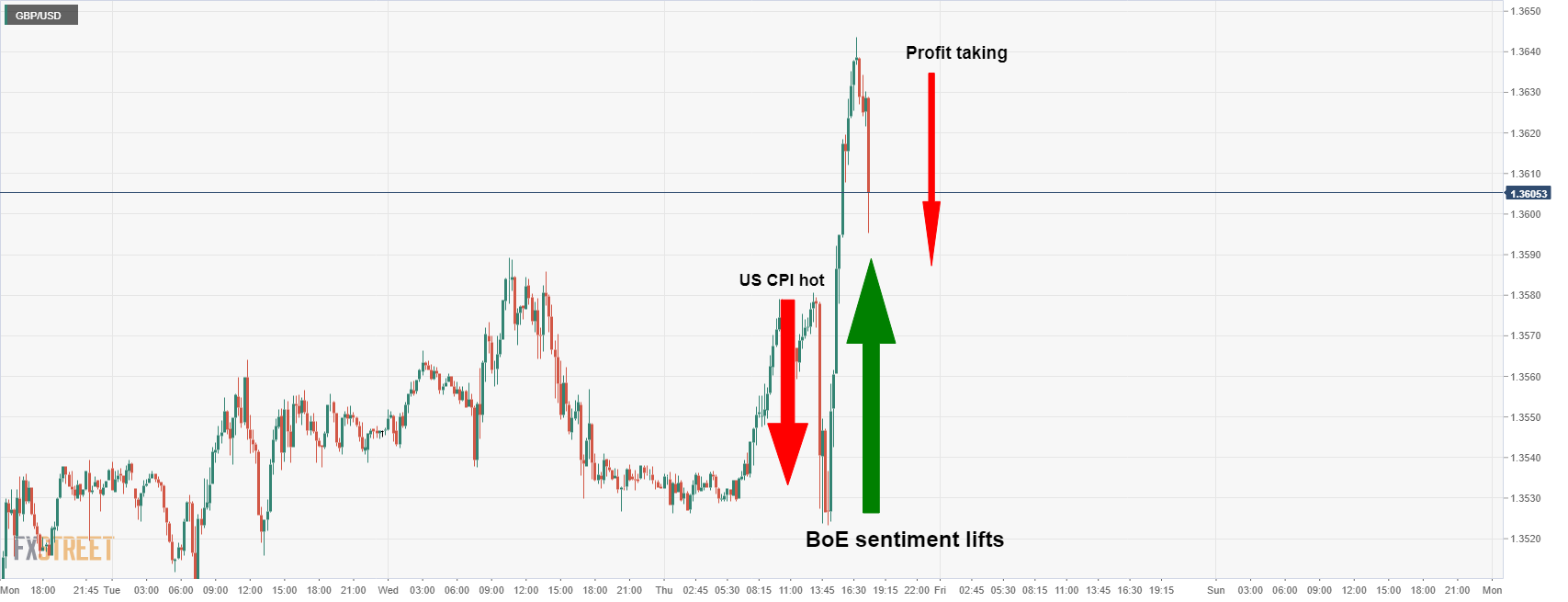
More to come...
- Silver broaden its weekly gains, up so far 5.17%.
- US inflation reached levels last seen in August 1982, above 7% for the second consecutive month.
- Money market futures have priced in an 80% chance of a 50 bps increase on the Fed’s March meeting.
- XAG/USD is neutral biased, but bulls get ready to attack the 200-DMA at $24.20.
Silver (XAG/USD) expands its rally to five straight days following a hot US inflation report that reached levels not seen since the 1980s. At the time of writing, XAG/USD is trading at $23.70.
An hour before the US cash equity markets opened, the Bureau of Labor Statistics (BLS) revealed that the Consumer Price Index (CPI), the inflation indicator in the US in January, reached 7.5% y/y, more than the 7.3% estimated by analysts. The so-called core CPI, which excludes volatile items like food and energy, rose to 6%, higher than the 5.9% estimated.
According to analysts at RBC, they noted that “near-term inflation is driven by higher home rent and vehicle prices.· Further added that inflation pressures are broadening “as majority of the consumer basket is seeing +2% growth in inflation.”
Following the data release, market players have fully priced in a 25 basis point increase to the Federal Funds Rate (FFR) by the Federal Reserve. However, there is an 80% chance of a 50 basis point increase, as reported by the CME FEDWATCH Tool, as of February 10, 2022, at press time.
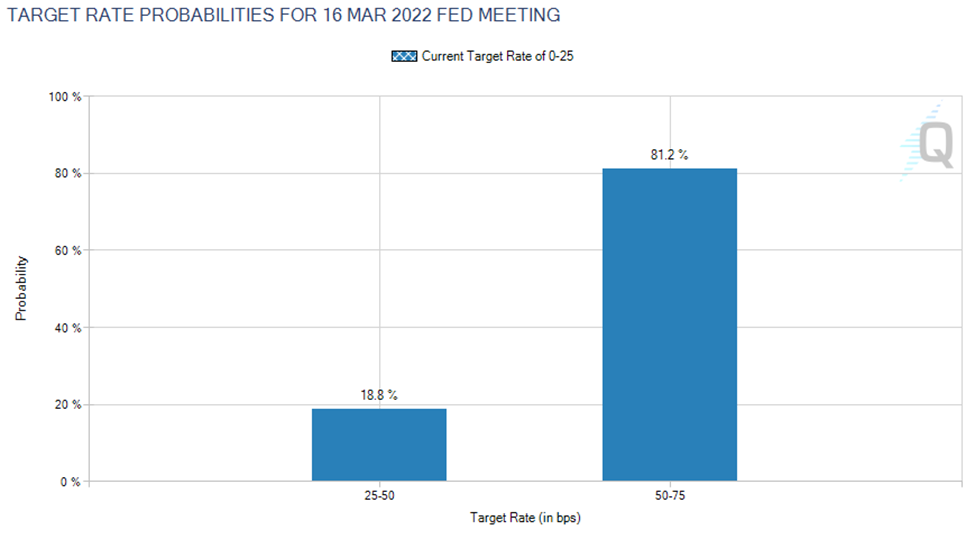
Source: CME Group
In the meantime, the US Dollar Index, a gauge of the greenback’s value against a basket of peers, slide 0.27%, currently at 95.26. The US 10-year Treasury yield rises eight basis points sits at 2.024%, which usually would derail the white metal from pushing for higher prices, but appears to be ignored by investors.
Alongside the inflation report, the US economic docket featured the Initial Jobless Claims for the week ending on February 5 rose to 223K, better than the 230K forecasted by analysts while Continuing Jobless Claims stayed unchanged at 1621K compared to the revision of the previous week.
XAG/USD Price Forecast: Techincal outlook
XAG/USD is neutral-upward biased, as shown by the daily charts. Silver’s Thursday price action left the 100-day moving average (DMA) as support at $23.21, and following the US CPI release, broke the January 3 daily high resistance level at $23.40, which now turned support.
Once those levels cleared, XAG/USD’s next resistance would be a 10-month-old downslope trendline lying around $24.20, but first, XAG/USD bulls will need to crack down the $24.00 psychological figure. If the $24.00-20 region gives way, there would be nothing in the path towards $25.00.

Data released on Thursday showed higher-than-expected inflation numbers with the annual CPI hitting the highest level since 1982. The upside surprise, even as areas like energy goods and autos cooled as expected, illustrates that inflation continues to carry plenty of momentum, and any meaningful slowdown remains elusive, explained analysts at Wells Fargo.
Key Quotes:
“The inertia in inflation looks increasingly difficult to break.”
“We continue to believe that inflation will cool somewhat in the coming months beyond the year-ago base effects. As total spending growth slows and shifts toward services, goods inflation is likely to ease from the dizzying rates witnessed this past year. The moderating effect on the headline should be amplified by the relative importance of core goods having increased with the new weights introduced in today's report.”
“The FOMC has strongly signaled it plans to begin tightening policy at its March 15-16 meeting. How much it may raise the fed funds rate is more uncertain. Today's report keeps the door open to a 50 bp rate increase in March, but FOMC members will get an additional look at inflation with the February CPI report, released on March 10. If, as we expect, it shows the peak in inflation has likely been reached, we anticipate the FOMC will take a more measured approach, opting to raise the fed funds rate by 25 bps in March but signaling additional hikes will be right on its heels.”
- Despite US inflation reaching the highest level since 1982, the greenback weakens.
- AUD/USD traders faded the downward reaction followed by a 90-pip rally, from 0.7140 to 0.7250.
- Treasury yields rise, led by the 10-year benchmark note, piercing the 2.00% threshold.
The AUD/USD advances sharply following the release of US inflation data, which rose the highest since 1982. At the time of writing, the AUD/USD is trading at 0.7237 for a gain of 0.77%.
Before Wall Street opened, the Department of Labor unveiled the January Consumer Price Index (CPI), which increased 7.5%, higher than the 7.3% foreseen on annual figures. Excluding volatile items like food and energy, the so-called Core CPI broke the 6% threshold, higher than the 5.9% estimations.
Market’s reaction
On the release, the AUD/USD dipped as low as the S1 daily pivot at 0.7147, followed by a jump of 80-pips so far, approaching the 100-day moving average (DMA) at 0.7247. The US 10-year Treasury yield reached the 2% mark, advancing six basis points.
In the meantime, the US Dollar Index, a gauge of the greenback’s value against a basket of its peers, falls 0.17%, sitting at 95.33.
During the Asian Pacific session, the Australian economic docket featured Building Permits on its monthly reading for December, alongside Consumer Inflation Expectations for February. The former came at 8.2%, as foreseen by market players, while the latter arrived at 4.6% with no forecast.
In the US, alongside inflation figures, Initial Jobless Claims for the week ending on February 5 rose to 223K, better than the 230K forecasted by economists, while Continuing Jobless Claims stayed unchanged at 1621K compared to the revision of the previous week.
AUD/USD Price Forecast: Technical outlook
Now that US CPI is in the rearview mirror, the AUD/USD is neutral biased, despite the 90-pip jump in the session. The 50-DMA at 0.7166 is under the spot price, while the 100-DMA and the 200-DMA reside above the spot price, suggesting that the AUD/USD is tilted to the downside.
However, worth noting that at press time, a five-month-old downslope trendline, a resistance around 0.7220, witnessed a break, which a daily close above the latter could confirm.
Upwards, the AUD/USD first resistance would be the 100-DMA at 0.7247. A break of that ceiling would expose the January 13 daily high at 0.7313, followed by the 200-DMA at 0.7366.
Consumer prices exceeded expectations in January, rising a strong 0.6% MoM. In the view of economists at TD Securities, a strong CPI print will keep that 50bp hike for next month alive. That should leave the USD on its front-foot for now and, with EUR/USD at risk of re-testing 1.13.
New US inflation highs heaps pressure on the Fed
“Another strong CPI report, with consumer prices exceeding expectations. Total/core prices rose 0.6% MoM each, above the 0.4%/0.5% consensus, respectively. The YoY pace reached new multi-decade highs at 7.5%/6.0% for headline and core CPI inflation, respectively.”
“The stronger than expected January CPI report increases the odds of a firmer monetary policy response by the Fed. We continue to expect the FOMC to raise rates by 25bp at its March meeting, but another solid print in February will likely encourage the Fed to accelerate the pace of hikes in 2022 and hasten both the timing and pace of balance sheet runoff.”
“The next ECB meeting comes a few days ahead of the Fed, which leaves us biased for a retest of 1.13 in EUR/USD, before looking for a more meaningful move topside. Meanwhile, we think USD/JPY is destined higher (118), especially with the BOJ still very far away from any sort of normalization this year. We expect this CPI print to place pressure in equities, and that will weigh on the antipodes.”
- US CPI data above expectations triggers volatility across financial markets.
- Metals tumble and then rebound, erasing losses.
- XAU/USD back above $1830, still capped by the $1835 area.
Gold prices bounces sharply on a volatile session. Following CPI data, XAU/USD tumbled to $1821, hitting a two-day low. A few minutes later, it rebounded above $1830, approaching weekly highs. The rebound suggests some underlying strength, but it needs to break firm above $1835 to open the door to more gains.
USD soars, and then tumbles
Economy data from the US showed the annual CPI rate rose to 7.5% in January, the highest level since 1982, and above the 7.3% expected. The numbers reinforced rate hike expectations from the Federal Reserve and boosted the dollar across the board.
After the opening bell at Wall Street, the greenback reversed and erased all gains, as stocks also moved back to the upside. US yields pulled back after the post CPI spike to fresh month monthly highs.
The “buy the rumor, sell the fact” patterns favoured gold prices. XAU/USD is trading back above $1830. It still faces resistance at $1835, and a break higher could lead to more gains and a move toward $1850. If it fails to hold above $1830 on Thursday, then a corrective move seems likely. The initial support is seen at $1820, followed by $1815 and $1808.
Technical levels
- DXY moves higher and flirts with the 96.00 barrier.
- US headline CPI rose 7.5% YoY in January.
- US Initial Claims increased by 223K WoW.
The US Dollar Index (DXY), which tracks the greenback vs. a bundle of its main competitors, leaps to fresh tops in the boundaries of the 96.00 zone on Thursday.
US Dollar Index stronger after hottest CPI in 4 decades
The index quickly climbed to multi-day highs after US inflation figures rose at the fastest pace in 40 years at 7.5% in January. In the same line, core prices – excluded energy and food costs – rose to 6.0% over the last twelve months.

The strong CPI print immediately morphed into further upside in US yields across the curve, where the 10y benchmark note tested – albeit ephemerally – the psychological 2.00% yardstick.
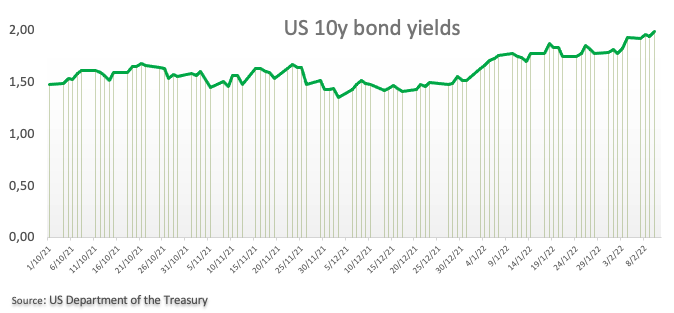
Further results from the US docket showed Initial Claims also coming in above expectations after rising 223K in the week to February 5.
The move higher in US yields responded to now rising speculation of a potential 50 bps interest rate hike at the FOMC event in March. That said, and according to CME Group’s FedWatch tool, the probability of such a raise next month is now just above 50% (from 24% on February 9).
What to look for around USD
Higher-than-expected US inflation figures lent extra oxygen to the greenback and propelled DXY back to the 96.00 neighbourhood. However, the extent and duration of this improvement in the dollar remains to be seen, as much of the current elevated inflation narrative was already priced in by market participants as well as the probability (bigger now) of a 50 bps rate hike by the Fed (instead of the more conventional 25 bps move). Looking at the longer run, and while the constructive outlook for the greenback appears well in place for the time being, recent hawkish messages from the BoE and the ECB carry the potential to undermine the expected move higher in the dollar in the next months.
Key events in the US this week: Flash Consumer Sentiment (Friday).
Eminent issues on the back boiler: Fed’s rate path this year. US-China trade conflict under the Biden administration. Debt ceiling issue. Escalating geopolitical effervescence vs. Russia and China.
US Dollar Index relevant levels
Now, the index is gaining 0.26% at 95.80 and a break above 96.00 (weekly high Feb.10) would open the door to 97.44 (2022 high Jan.28) and finally 97.80 (high Jun.30 2020). On the flip side, the next down barrier emerges at 95.28 (100-day SMA) followed by 95.13 (weekly low Feb.4) and then 94.62 (2022 low Jan.14).
- The USD/CAD appears to fade the US inflation report, which came higher than estimated.
- US Treasury yields rise, led by the 10-year benchmark note at 2%.
- USD/CAD Technical Outlook: Neutral biased, confined to the 1.2650-1.2790 range.
The USD/CAD pares Wednesday’s losses as the US inflation in January grinds higher, reaching a 40-year high, while the US central bank prepares to begin its tightening cycle. At the time of writing, the USD/CAD is trading at 1.2693.
On Thursday, the Department of Labor reported that January’s inflation rose by 7.5%, higher than the 7.3% estimated annually based. Excluding volatile items like energy and food, also called Core Consume Price Index (CPI), broke the 6% threshold, higher than the 5.9% expected, the most witnessed since 1982.
Market’s reaction
The USD/CAD initial reaction was upwards, from 1.2670s region to 1.2714, though stalled around February0s 9 daily high. Meanwhile, the US 10-year Treasury yield reached the 2% mark in the bond market, rallying more than five basis points after the US inflation report.
An absent Canadian economic docket left USD/CAD traders adrift to US macroeconomic data. On the US front, alongside the inflation figures, Initial Jobless Claims for the week ending on February 5, increased 223K, lower than the 230K estimated by economists, while Continuing Jobless Claims stayed unchanged at 1621K compared to the revision of the previous week.
USD/CAD Price Forecast: Technical outlook
The USD/CAD is confined to the 1.2650-1.2790 area. The 50-day moving average (DMA) at 1.2703 above the spot price is resistance, capping moves since Monday, while the 100 and the 200-DMA at 1,2616 and 1.2519 are almost “horizontal” well below the exchange rate.
That said, the USD/cad first resistance would be the aforementioned 50-DMA. Breach of the latter would expose the January 28 cycle high at 1.2796. Once that is broken, the USD/CAD will have a clear path towards December’s 2021 swing high at 1.2963.
Wall Street's main indexes came under strong bearish pressure on Thursday after the data from the US showed that inflation continued to rise at the beginning of the year.
The S&P 500 Index was last seen losing 1.15% at 4,535, the Dow Jones Industrial Average was losing 0.75% at 35,500 and the Nasdaq Composite was falling 1.4% at 14,285.
The US Bureau of Labor Statistics reported that inflation, as measured by the Consumer Price Index (CPI), jumped to 7.5% on a yearly basis in January from 7% in December. This reading surpassed the market expectation of 7.3%. Additionally, the Core CPI, which strips food and energy prices, climbed to 6% from 5.5%, compared to analysts' estimate of 5.9%.
Meanwhile, the benchmark 10-year US Treasury bond yield is up nearly 3% on the day at 2% and the CME Group FedWatch Tool shows that markets are pricing a 50.2% probability of a 50 basis points Fed rate hike in March.
- USD/JPY rallied hard and shot to over one-month high during the early North American session.
- Stronger US CPI prints pushed the US bond yields higher and provided a strong lift to the USD.
- Technical buying above the 115.70 region and the 116.00 mark contributed to the momentum.
The USD/JPY pair caught fresh bids during the early North American session and surged past the 116.00 mark, hitting over a one-month high in reaction to stronger US CPI.
Data released by the US Bureau of Labor Statistics reported this Thursday showed that the headline CPI in the US edged higher to 0.6% in January as against 0.5% expected and the previous. Moreover, the yearly rate jumped to a fresh multi-decade high and accelerate to 7.5% during the reported month. This was above consensus estimates pointing to a rise to 7.3% from the 7% recorded at the end of 2021.
Additional details revealed that the core CPI, which excludes food and energy prices, climbed 6.0% from a year ago as against 5.5% in December and 5.9% anticipated. The data lifted market bets for a 50 bps Fed rate hike in March. This, in turn, pushed the yield on the 2-year US government bond, which is more sensitive to rate hike expectations, to the highest level since February 2020, around 1.434%.
Adding to this, the yield on the benchmark 10-year US note shot back closer to the 2.0% threshold, or the highest level since August 2019 touched earlier this week. This prompted aggressive short-covering around the US dollar and provided a strong boost to the USD/JPY pair. The momentum confirmed a bullish breakout through the 115.70 area and took along some trading stops near the 116.00 round figure.
Sustained break through the mentioned hurdle might have already set the stage for additional gains and supports prospects for a move towards testing 2021 high, around the 116.35 region. Some follow-through buying will be seen as a fresh trigger for bullish traders and pave the way for an extension of the recent appreciating move witnessed since the beginning of this month.
Technical levels to watch
- EUR/USD reverses the initial optimism and breaches 1.1400.
- US CPI rose 7.5% YoY in January. Core CPI gained 6.0% YoY.
- US Initial Claims rose by 223K in the week to February 5.
The sudden bout of strength in the greenback forced EUR/USD to give away earlier gains and break below the 1.1400 support on Thursday.
EUR/USD weaker post-US CPI
EUR/USD drops to new multi-session lows after US inflation figures tracked by the CPI surprised to the upside in January, showing consumer prices rose 7.5% from a year earlier while prices excluding food and energy costs rose 6.0% also on a yearly basis.
The higher-than-expected US CPI gave extra wings to the buck and US yields and reinforce further the speculation of a more aggressive lift-off by the Fed at the March meeting.
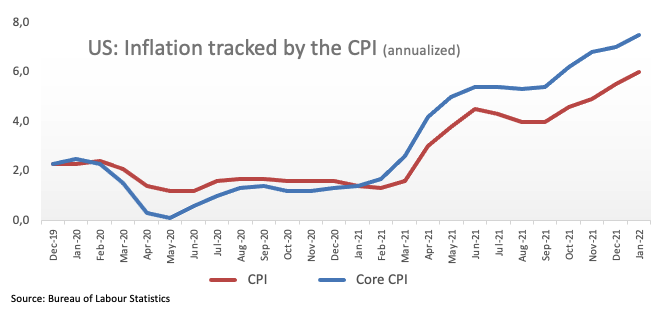
Extra results from the US docket also saw weekly Claims bettering estimates after rising 223K in the week to February 5.
EUR/USD levels to watch
So far, spot is losing 0.12% at 1.1407 and faces the next up barrier at 1.1483 (2022 high Feb.4) followed by 1.1496 (200-week SMA) and finally 1.1664 (200-day SMA). On the other hand, a break below 1.1381 (weekly low Feb.10) would target 1.1323 (55-day SMA) en route to 1.1121 (2022 low Jan.28).
The S&P 500 has recovered strongly for a break above its downtrend from early January to retest of its early February high and 61.8% retracement of the January sell-off at 4591/95. We see scope for a move above the early February high and 61.8% retracement of the January sell-off at 4591/95 to test the 63-day moving average (DMA) at 4625, but with a fresh cap looked for here.
Close below 4453/50 to mark a more important turn lower again
“With daily MACD momentum having turned higher, there is a risk for a break above the early February high and 61.8% retracement of the January sell-off for a deeper recovery yet to test the falling 63-DMA, currently placed at 4625.”
“Our bias remains for the 4625 level to prove a major barrier and for the broader risk to then turn lower again in line with our broader ranging view.”
“We note though the continued similarities between now and 2018 and if we were to continue to repeat this path this suggests a move to the 78.6% retracement of the January collapse at 4691 cannot be ruled out.”
“Support is seen at 4548/47 initially, then the lower end of the price gap from yesterday morning at 4522. A close back below here can ease the immediate upside bias for a fall back the key price pivot and 20-DMA at 4453/50. A close below here is needed to mark a more important turn lower again.”
India’s Monetary Policy Committee (MPC) kept both the repo and the reverse repo rate unchanged and maintained its accommodative policy stance. In the view of analysts at Standard Chartered, RBI’s dovish rhetoric poses yet another headwind – they remain bearish on the INR.
Dovish RBI supports bearish INR view
“MPC maintains status quo on repo and reverse repo rates. We continue to expect the repo rate to be hiked from August; corridor normalisation likely by June vs our previous expectation of April.”
“We think the RBI’s dovish rhetoric relative to market expectations will act as another headwind for the INR, particularly at a time when major central banks are adopting a much more hawkish stance.”
“We maintain our targets for USD/INR at 75.50 by end-March and 77.50 by year-end.”
- Weekly Initial Jobless Claims in US declined by 16,000.
- US Dollar Index pushes higher toward 96.00 in the early American session.
There were 223,000 initial claims for unemployment benefits in the US during the week ending February 5, the data published by the US Department of Labor (DOL) revealed on Thursday. This reading came in better than the market expectation of 230,000.
Market reaction
The US Dollar Index pushes higher toward 96.00 in the early American session but the greenback seems to be receiving a boost from the hot inflation data.
Additional takeaways
"The 4-week moving average was 253,250, a decrease of 2,000 from the previous week's revised average."
"The advance seasonally adjusted insured unemployment rate was 1.2% for the week ending January 29, unchanged from the previous week's unrevised rate."
"The advance number for seasonally adjusted insured unemployment during the week ending January 29 was 1,621,000, unchanged from the previous week's revised level."
- GBP/USD dived over 50 pips in the last hour amid a strong pickup in the USD demand.
- Hotter-than-expected US CPI print boosted Fed rate hike bets and lifted the greenback.
- Bears might wait for sustained break below the 1.3500 mark before placing fresh bets.
the GBP/USD pair witnessed a dramatic turnaround in reaction to stronger US CPI prints and dived to a fresh daily low, around the 1.3525 region in the last hour.
Following a brief consolidation, the US dollar caught fresh bids during the early North American session following the release of the latest US consumer inflation figures. This, in turn, was seen as a key factor that attracted some selling around the GBP/USD pair and led to a sharp pullback of over 50 pips from the daily high, near the 1.3580 region.
According to the data released this Thursday, the headline US CPI edged higher to 0.6% in January as against expectations for a reading of 0.5%. Moreover, the yearly rate reached a fresh multi-decade high and accelerate to 7.5% during the reported month, up from 7% recorded at the end of 2021, against surpassing consensus estimates.
Adding to this, the core CPI, which excludes food and energy prices, rose 6.0% from a year ago as against 5.5% in December and 5.9% anticipated. The data boosted bets for a 50 bps Fed rate hike in March, which was evident from an uptick in the US Treasury bond yields. This, in turn, benefitted the USD and exerted pressure around the GBP/USD pair.
It will now be interesting to find if the pair is able to find some buying at lower levels or weakens further below the key 1.3500 mark, confirming a near-term bearish breakdown. Hence, it will be prudent to wait for a strong follow-through selling before traders start positioning for any further near-term depreciating move for the GBP/USD pair.
Technical levels to watch
Inflation in the US, as measured by the Consumer Price Index (CPI), rose to 7.5% on a yearly basis in January from 7% in December, the US Bureau of Labor Statistics reported on Thursday. This print surpassed the market expectation of 7.3%. On a monthly basis, CPI was up 0.6% in January.
Further details of the publication revealed that the Core CPI, which excludes volatile food and energy prices, climbed to 6% from 5.5% in December.
Market reaction
With the initial market reaction, the greenback started to gather strength against its major rivals and the US Dollar Index was last seen rising 0.25% on the day at 95.78.
Meanwhile, the benchmark 10-year US Treasury bond yield gained traction and reached its highest level since August 2019 at 1.98%.
Gold looks to be finding better support in its broader sideways range. But strategists at Credit Suisse notes that the yellow metal needs to break above $1,877 to see a sustained leg higher.
Break under $1,780 to ease upward bias
“Gold remains well supported in the converging range of the past year but needs to clear $1,854 to suggest the downtrend from early 2021 break and above $1,877 to suggest we are seeing a more sustainable move higher, for a test of $1,917 next.”
“Below $1,780 is needed to ease the immediate upward bias for a fall back to $1,759/54, but with a break below here needed to clear the way for a retest of key price and retracement support from the lower end of the range at $1,691/76.”
“Only below $1,691/76 though would see a major top established to mark an important change of trend lower.”
See – Gold Price Forecast: XAU/USD to trade at $1,800 towards the end of Q1 2022 – ANZ
- A combination of factors continued acting as a headwind for USD/CAD on Thursday.
- Bullish oil prices underpinned the loonie and capped the upside amid weaker USD.
- The downside remains cushioned as investors await the release of the US CPI print.
The USD/CAD pair extended its sideways consolidative price move through the early North American session and remained confined in a narrow trading band, around the 1.2670 region.
The pair struggled to gain any meaningful traction and remained below the 1.2700 mark amid the underlying bullish tone around crude oil prices, which tend to benefit the commodity-linked loonie. On the other hand, a generally positive risk tone weighed on the safe-haven US dollar and acted as a headwind for the USD/CAD pair.
The downside, however, remains cushioned, at least for the time being, as investors seem reluctant and preferred to wait on the sidelines ahead of the US consumer inflation figures. It is worth mentioning that investors have been pricing in a more aggressive policy response by the Fed to contain stubbornly high inflation.
Hence, the US CPI report for January would be looked upon for fresh clues about the pace of the Fed's policy tightening cycle. This, in turn, will play a key role in driving the near-term USD demand. This, along with oil price dynamics, would help investors to determine the next leg of a directional move for the USD/CAD pair.
From a technical perspective, bulls, so far, have managed to defend support near the 1.2450 region. This should now act as a pivotal point for short-term traders, which if broken decisively will set the stage for an extension of the recent pullback from the 1.2785 region, or the monthly high touched in reaction to the stellar NFP report last week.
Technical levels to watch
- EUR/USD extends the corrective climb to 1.1445/50.
- The 5-month support line holds the downside near 1.1400.
EUR/USD moves further north and reaches the mid-1.1400s ahead of the key US CPI release on Thursday.
In the meantime, further gains in the pair remains on the table while above the 5-month line, today around 1.1400. Beyond this area, EUR/USD should be able to attempt another visit to the 2022 high at 1.1483 (February 4) just ahead of the 200-week SMA, today at 1.1496. Between 1.1500 and 1.1600 there are no resistance levels of note, leaving the October 2021 top at 1.1692 as the potential longer-term target.
In the longer run, the negative outlook remains in place while below the key 200-day SMA at 1.1664.
EUR/USD daily chart
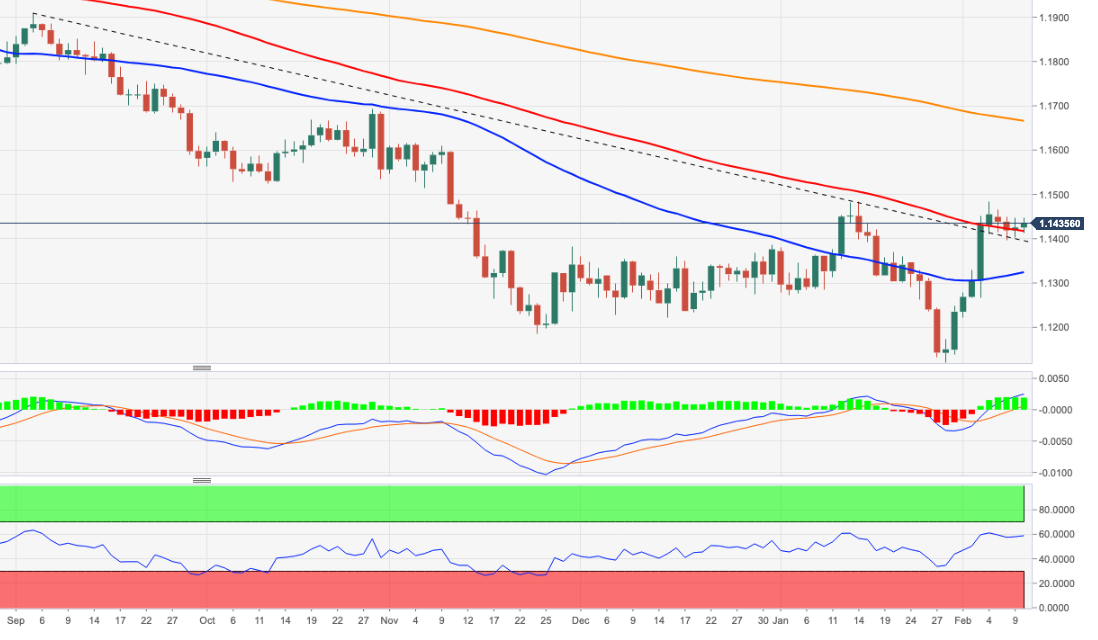
The Organization of the Petroleum Exporting Countries (OPEC) announced in its latest monthly report that it left the 2022 world oil demand growth forecast unchanged at 4.15 million barrels per day (bpd), as reported by Reuters.
Key takeaways
"OPEC sees upside potential in 2022 oil demand forecast due to strong economic recovery."
"OPEC keeps forecast for 2022 non-OPEC supply growth unchanged."
"OPEC boosts forecast of 2022 demand for its crude by 100,000 bpd."
"OPEC's oil output rose by 64,000 bpd in January to 27.98 million bpd, lagging pledged increase under OPEC+ deal."
"Saudi Arabia tells OPEC it boosted output by 123,000 bpd in January to 10.145 million bpd."
Market reaction
Crude oil prices showed no immediate reaction to this publication and the barrel of West Texas Intermediate was last seen posting small daily gains at $90.37.
- DXY adds to Wednesday’s losses around the 95.50 zone.
- Next on the downside comes the monthly low at 95.13.
DXY keeps the neutral/bearish mood unchanged around the mid-95.00s on Thursday.
The inability of the index to garner convincing upside traction, ideally in the short term, could prompt sellers to return to the market. That scenario should force the dollar to initially retest the so far monthly low at 95.13 (February 4), while a breach of it could expose a deeper retracement to the 2022 low at 94.62 (January 14).
In the near term, the 5-month line around 95.15 is expected to hold the downside for the time being. Looking at the broader picture, the longer-term positive stance in the dollar remains unchanged above the 200-day SMA at 93.56.
DXY daily chart
- AUD/USD turned positive for the fourth straight day and shot to a near three-week high.
- A convincing breakthrough the 0.7175-0.7180 confluence hurdle favours bullish traders.
- Bulls might now aim to reclaim the 0.7300 mark and test the 0.7315 area, or 2022 high.
The AUD/USD pair attracted some dip-buying near the 0.7160 region on Thursday and turned positive for the fourth successive day. The momentum pushed the pair to a near three-week high during the mid-European session, with bulls now looking to build on the momentum beyond the 0.7200 mark.
From a technical perspective, the latest leg up now seems to have confirmed a bullish breakout through a descending trend-line extending from 2022 high, around the 0.7315 area touched on January 13. The mentioned hurdle also coincided with the 61.8% Fibonacci level of the 0.7315-0.6967 downfall.
Given that technical indicators on the daily chart have just started gaining positive traction, the AUD/USD pair seems all set to prolong its recent recovery from a two-year low. That said, bulls are likely to wait for the US CPI report before positioning for any further appreciating move.
The next relevant resistance pegged near the 0.7225 region ahead of the 100-day SMA, around mid-0.7200s. Some follow-through buying has the potential to lift the AUD/USD pair beyond the 0.7280 intermediate resistance, towards the 0.7300 mark and the 0.7315 region, or the YTD high.
On the flip side, the 0.7180-0.7175 confluence resistance breakpoint now seems to protect the immediate downside. Any subsequent slide might attract some buying and remain limited near the 50% Fibo. level, around the 0.7140 region, which if broken decisively will negate the positive outlook.
The AUD/USD pair would then turn vulnerable and accelerate the slide towards the 0.7100 round-figure mark. The downward trajectory could further get extended and drag spot prices back towards retesting the post-NFP swing low, around the 0.7050 region, support marked by the 23.6% Fibo. level.
AUD/USD daily chart
-637800937611795156.png)
Technical levels to watch
European Central Bank (ECB) Vice President Luis de Guindos argued on Thursday that the wage-bargaining process, perhaps, had been postponed in the euro area, as reported by Reuters.
"if we start to see second-round effects, then inflation will become much more complicated and monetary policy will have to respond," de Guindos added and noted that ECB President Lagarde's press conference reflected the majority view of the Governing Council.
Market reaction
These comments don't seem to be having a noticeable impact on the shared currency's performance against its rivals. As of writing, EUR/USD was up 0.12% on the day at 1.1435.
European Central Bank (ECB) Vice President Luis de Guindos said on Thursday that they expect growth to rebound strongly over the course of 2022 in the euro area, as reported by Reuters.
Additional takeaways
"Over the next three years, we anticipate that euro area growth will remain above its long-term average."
"Inflation is likely to remain elevated for longer than previously expected but to decline in the course of this year."
"There are upside risks to that inflation outlook."
"We need more than ever to maintain flexibility and optionality in the conduct of monetary policy."
"We stand ready to adjust all of our instruments, as appropriate, to ensure that inflation stabilises at our 2% target over the medium term."
"Our forward guidance on the conditions under which rates will be raised is clear."
"It’s natural that central banks around the globe won’t necessarily start raising rates at the same time."
"We are guided by our forward guidance conditions and will act if, and when, they have been met."
Market reaction
The EUR/SD pair showed no immediate reaction to these comments and was last seen posting small daily gains at 1.1432.
US CPI Overview
Thursday's US economic docket highlights the release of the critical US consumer inflation figures for January, scheduled later during the early North American session at 13:30 GMT. The headline CPI is anticipated to come in at 0.5% during the reported month, unchanged from December. The yearly rate, however, is projected to reach a fresh 39-year high and accelerate to 7.3% in January from 7.0% recorded at the end of 2021. Meanwhile, core inflation, which excludes food and energy prices, is anticipated to rise to 5.9% from a year ago as against 5.5% in the previous month.
Joseph Trevisani, Senior Analyst at FXStreet, explains: “The pandemic lockdown and the subsequent flood of liquidity from the Federal Reserve and the US government has combined, a year later, with labor and material shortages for manufacturing and a supply chain tangle that has stretched around the world, to produce the highest American consumer inflation rate in four decades.”
How Could it Affect EUR/USD?
The markets seem convinced that the US central bank would adopt a more aggressive policy response to combat stubbornly high inflation. A stronger than expected CPI print would further boost bets for a 50 bps Fed rate hike in March and push the US bond yields higher, along with the US dollar. Conversely, a softer reading – though seems unlikely – might do little to calm market fears about a faster policy tightening by the Fed or prompt any meaningful selling around the greenback. This, in turn, suggests that the path of least resistance for the EUR/USD pair is to the downside, though a more hawkish ECB last week should help limit deeper losses.
Meanwhile, Eren Sengezer, Editor at FXStreet, offered a brief technical outlook and outlined important levels to trade the EUR/USD pair: “The Relative Strength Index (RSI) indicator on the four-hour chart is sitting above 50 early Thursday, pointing to a bullish tilt in the near term. However, the pair might need to break above 1.1480 (static level) to convince buyers of another leg higher. Above that level, 1.1500 (psychological level, static level) aligns as the next resistance before 1.1550..”
“On the downside, supports ate located at 1.1400 (psychological level, Fibonacci 23.6% of the latest uptrend), 1.1350 (Fibonacci 38.2% retracement, 200 period-SMA) and 1.1320 (100-period SMA),” Eren added further.
Key Notes
• US Consumer Price Index January Preview: Is this inflation different?
• US Inflation Preview: Core CPI above 6% could spark next dollar rally
• EUR/USD Forecast: Euro holds its ground ahead of US CPI
About the US CPI
The Consumer Price Index released by the US Bureau of Labor Statistics is a measure of price movements by the comparison between the retail prices of a representative shopping basket of goods and services. The purchasing power of USD is dragged down by inflation. The CPI is a key indicator to measure inflation and changes in purchasing trends. Generally speaking, a high reading is seen as positive (or bullish) for the USD, while a low reading is seen as negative (or Bearish).
- EUR/JPY extends the rally and records new 2022 peaks.
- The next target of note aligns at the October 2021 high near 133.50.
EUR/JPY is contentedly maintaining its February rally and has advanced to fresh peaks near 132.60 on Thursday.
Considering the recent price action, further gains in the cross seem likely over the short-term horizon. That said, there is a minor hurdle at 132.91 (high October 29), which is considered as the last defence for a test of the October 2021 peak at 133.48 (October 20).
In the near term, further upside remains on the table while above the 3-month support line, today near 130.80. In the longer run, and while above the 200-day SMA at 130.46, the outlook for the cross is expected to remain constructive.
EUR/JPY daily chart
- Silver edged higher for the fifth straight day and climbed to a two-week high on Thursday.
- The overnight sustained move above the 100-day SMA supports prospects for further gains.
- Bulls might now aim to reclaim the $24.00 mark and test the YTD high touched in January.
Silver traded with a mild positive bias through the first half of the European session and was last seen hovering near a two-week high, around the $23.35 region. The uptick, however, lacked bullish conviction as traders now seemed to wait for the release of the US CPI report, due later during the early North American session.
From a technical perspective, the overnight sustained strength above the 100-day SMA could be seen as a fresh trigger for the XAG/USD bulls. Some follow-through buying beyond the $23.40-$23.45 resistance would reaffirm the positive bias and set the stage for an extension of the appreciating move witnessed over the past one week or so.
The positive outlook is reinforced by the fact that technical indicators on the daily chart have just started moving into bullish territory. Hence, a subsequent strength towards reclaiming the $24.00 round-figure mark, en-route the YTD high around the $24.70 area touched on January 20, remains a distinct possibility.
On the flip side, the 100-day SMA resistance breakpoint, around the $23.20-$23.15 region, now seems to protect the immediate downside ahead of the $23.00 mark. A convincing break below would expose the $22.75 support area before the XAG/USD drops to mid-$22.00, which if broken decisively will negate any near-term positive bias.
The XAG/USD would then turn vulnerable and accelerate the slide towards the next relevant support is near the $22.00 mark. Some follow-through selling will shift the bias in favour of bearish traders and pave the way for a slide towards challenging the double-bottom support, around the $21.40 region.
Silver daily chart
-637800860028129125.png)
Technical levels to watch
GBP/USD has regained its traction following Wednesday's wobbly action. Near-term bullish bias stays intact while eyes turn to US Consumer Price Index (CPI) data for January, FXStreet’s Eren Sengezer reports.
Dollar could capitalize on hot inflation data and force GBP/USD to turn south
“The US Bureau of Economic Analysis will release the CPI data for January. In case this report suggests that inflation in the US continued to heat up at the beginning of the year, market participants could price in an aggressive rate hike in March and help the dollar outperform its rivals. On the flip side, the greenback is likely to come under renewed selling pressure in case the CPI readings fall short of estimates.”
“1.3600 (psychological level) aligns as the next immediate target on the upside before 1.3620 (static level) and 1.3650 (static level).”
“In case the pair reverses its course on strong CPI figures, 1.3540 (200-period SMA) is the first support ahead of 1.3520 (Fibonacci 38.2% retracement of the latest uptrend, 100-period SMA) and 1.3500 (psychological level, Fibonacci 50% retracement).”
See – US CPI Preview: Forecasts from 10 major banks, higher but showing moderation
The European Commission announced on Thursday that it raised the eurozone 2022 inflation forecast to 3.5% from 2.2% in November's forecast, as reported by Reuters. For 2023, the Commission sees inflation at 2.2%, compared to 1.7% in November.
The publication further showed that the 2022 growth forecast got revised lower to 4% from 4.3%.
"Multiple headwinds have chilled Europe's economy this winter: the swift spread of Omicron, a further rise in inflation driven by soaring energy prices and persistent supply-chain disruptions," European Economic Commissioner Paolo Gentiloni said, per Reuters. "With these headwinds expected to fade progressively, we project growth to pick up speed again already this spring."
Market reaction
This report doesn't seem to be having a significant impact on the shared currency's performance against its rivals. EUR/USD was last seen trading in the positive territory near mid-1.1400s.
- USD/CHF witnessed some selling on Wednesday amid subdued USD demand.
- The risk-on mood undermined the safe-haven CHF and helped limit the slide.
- Investors also seemed reluctant ahead of the release of the key US CPI report.
The USD/CHF pair remained on the defensive through the first half of the European session and was last seen hovering just a few pips above the daily low, around the 0.9235 region.
The US dollar edged lower on Thursday and exerted some downward pressure on the USD/CHF pair, though a generally positive risk tone undermined the safe-haven Swiss franc and extended some support. Apart from this, elevated US Treasury bond yields, along with hawkish Fed expectations acted as a tailwind for the greenback and further contributed to limiting the downside for the major.
Investors seem convinced that the Fed would adopt a more aggressive policy response to contain high inflation and have been pricing in a 50 bps rate hike in March. Thursday's release of the US consumer inflation figures should provide clues about the pace of the Fed's policy tightening cycle. This, in turn, will influence the USD and the near-term trajectory for the USD/CHF pair.
Looking at the broader picture, the pair has been oscillating in a familiar trading range since the beginning of this week. This further points to indecision among traders and warrants some caution before placing directional bets around the USD/CHF pair. Hence, it will be prudent to wait for a strong follow-through selling in order to confirm that the post-NFP rally has lost steam.
Thursday's US economic docket also features the release of the usual Weekly Initial Jobless Claims data late during the early North American session. This, along with the US bond yields, will drive the USD demand and provide some impetus to the USD/CHF pair. Apart from this, traders will further take cues from the broader market risk sentiment to grab some short-term opportunities.
Technical levels to watch
Thursday's Riksbank meeting erred more on the dovish side than economists at ING had expected. In their view, the Swedish krona can recover in the short-run, but upside capped in the medium-run.
Solidly dovish performance form the Riksbank
“Riksbank has defied hawkish expectations and is sticking to its past script of no rate hike before 2024 and no change to its balance sheet size in 2022. Both policies are likely to be adjusted earlier than the Riksbank is currently signaling, but with a lot of tightening already in the price, the medium-term upside for SEK is limited.”
“We still think EUR/SEK is mostly facing downside risks in the coming weeks, and we expect a move to the 10.30-10.35 area by the end of this quarter should global risk sentiment stabilise.”
“In the longer run, the Riksbank’s dovishness should continue to put a cap on SEK’s appreciation, especially considering there is still a good deal of tightening (65bp in the next 12 months) to be priced out of the SEK curve. We now expect EUR/SEK to stay above 10.00 for the remainder of the year.”
- WTI price is preserving a part of previous gains ahead of US inflation.
- Bulls cheer drawdown in US crude stockpiles, as Iran supply concerns loom.
- Upside appears more compelling if the daily rising trendline support holds.
WTI (NYMEX futures) is trading better bid so far this Thursday, clinging onto the previous gains but bulls turn cautious ahead of the critical US inflation.
A hotter US inflation report could boost the aggressive Fed’s tightening expectations, triggering a big leg up in the dollar, which could weigh negatively on the USD-denominated oil.
Further, looming concerns over a probable return of the Iranian oil supplies to the global markets, as Iran nuclear deal talks enter the final stretch, also keep the upside attempts limited in the black gold.
However, WTI bulls remain somewhat supported, courtesy of a big drawdown in the US crude stockpiles data published by the Energy Information Administration (EIA) on Wednesday.
The latest EIA data showed that the “US crude stocks fell by 4.8 million barrels last week to 410.4 million barrels, their lowest since October 2018, while overall product supplied, a proxy for demand, hit a record 21.9 million barrels per day over the past four weeks,” per Reuters.
All eyes now remain on the US inflation release and the sentiment on Wall Street for fresh trading impetus on the higher-yielding oil.
From a near-term technical perspective, WTI bulls manage to defend the over two-month-long rising trendline support at $88.42.
The 14-day Relative Strength Index (RSI) has pulled back from the overbought region, allowing room for a fresh upside.
The next bullish target is seen at $90.00, above which the February 8 highs of $90.61 will be challenged.
On the flip side, a breach of the aforesaid critical support will expose the ascending 21-Daily Moving Average (DMA) at 86.47.
The last line of defense for bulls is aligned at $86 – the round level.
WTI: Daily chart
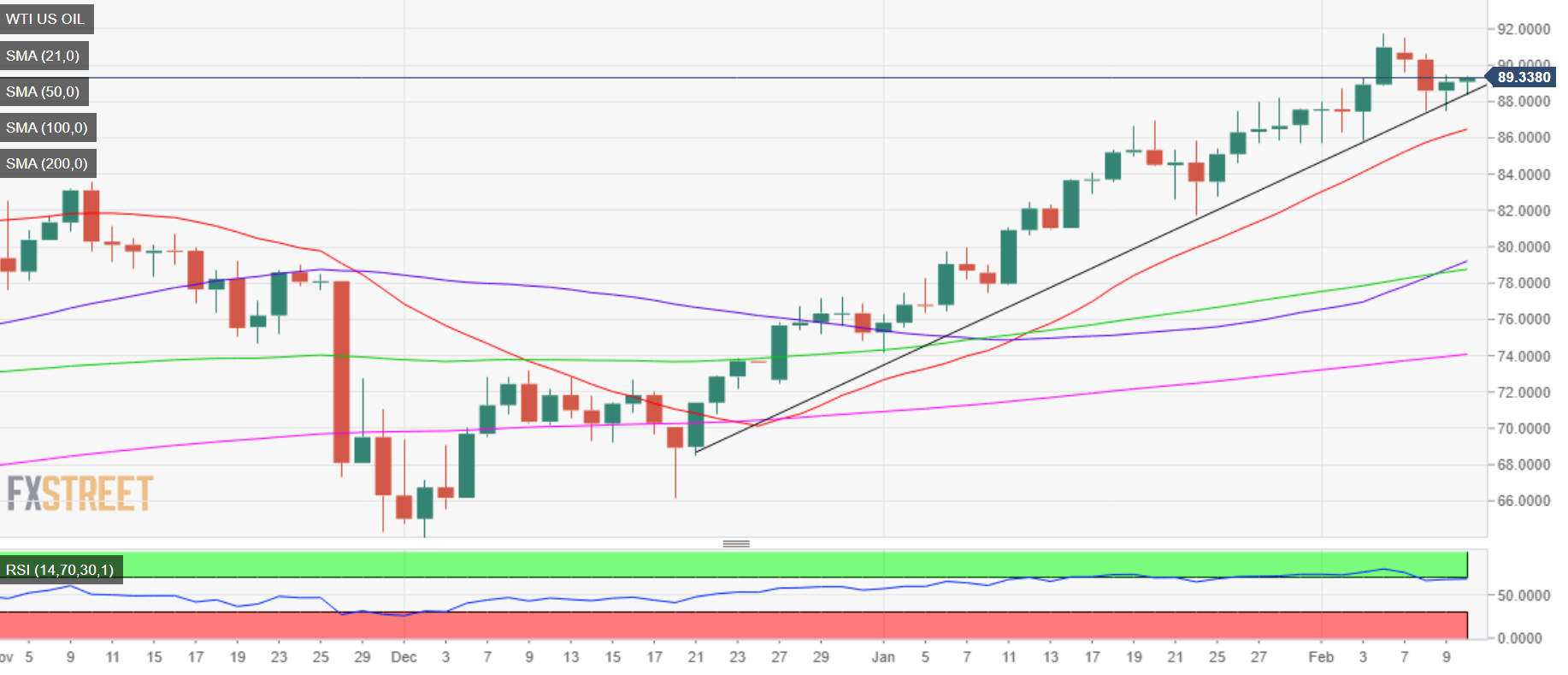
- GBP/USD caught fresh bids on Thursday and was supported by modest USD weakness.
- A positive risk tone turned out to be a key factor that undermined the safe-haven USD.
- Brexit jitters, hawkish Fed expectations should cap gains ahead of the key US CPI print.
The GBP/USD pair regained positive traction during the first half of the European session and shot to a fresh daily high, around the 1.3560-1.3565 region in the last hour.
Following the previous day's turnaround from the weekly low, the GBP/USD pair caught fresh bids on Thursday and was supported by modest US dollar weakness. A generally positive tone around the equity markets was seen as a key factor that undermined the greenback's relative safe-haven status. That said, elevated US Treasury bond yields and hawkish Fed expectations should limit any meaningful USD losses, warranting caution for bullish traders.
Investors seem convinced that the Fed will adopt a more aggressive policy response to combat high inflation and have been pricing in a 50 bps rate hike in March. This, in turn, had pushed the US bond yields to multi-year highs earlier this week. Hence, Thursday release of the US CPI report would be looked upon for fresh clues about the pace of the Fed's policy tightening cycle, which will play a key role in influencing the USD price dynamics.
In the meantime, some cross-driven strength stemming from a sharp spike in the GBP/JPY cross remained supportive of the move up. It, however, remains to be seen if bulls can retain their dominant position or the momentum meets with a fresh supply at higher levels amid renewed tensions over the Northern Ireland Protocol of the Brexit agreement. This makes it prudent to wait for some follow-through buying before positioning for any further gains.
Technical levels to watch
Barnabas Gan, Economist at UOB Group, reviews the latest BoT meeting (February 9).
Key Takeaways
“The Bank of Thailand (BOT) kept its one-day repurchase rate unchanged at 0.50% for its 14th consecutive meeting on 9 Feb 2022. The last time it made a move was in May 2020, when the benchmark rate was cut by 25 bps.”
“While the central bank made no adjustment to its 2022 GDP outlook of 3.4%, the decision to keep the monetary policy accommodative was largely expected given the economic risks surrounding the (1) development of COVID-19 outbreak amid the (2) risk of higher global energy prices and cost pass through.”
“We expect BOT to inject a token 25 basis point rate hike in 2022, possibly as early as 3Q22, in response to higher inflation risk and the faster-than-anticipated FOMC rate hike for the year ahead. Notwithstanding the projected 25bps hike later this year, we continue to view the monetary policy stance of BOT to be accommodative, especially against the backdrop of potentially higher global interest rates.”
- NZD/USD gained positive traction for the third successive day, though lacked bullish conviction.
- A positive risk tone extended support to the perceived riskier kiwi amid subdued USD demand.
- Traders seemed reluctant and preferred to wait on the sidelines ahead of the key US CPI report.
The NZD/USD pair traded with a mild positive bias through the early European session and was last seen hovering near a two-week high, just below the 0.6700 mark.
The pair edged higher for the third successive day on Thursday and might now be looking to build on its recent recovery from the 0.6530 area or lowest level since September 2020. A generally positive tone around the equity markets turned out to be a key factor that benefitted the perceived riskier kiwi amid subdued US dollar demand.
The uptick, however, lacked follow-through or a bullish conviction amid rising bets for a 50 bps Fed rate hike move in March, which continued acting as a tailwind for the greenback. The markets seem convinced that the US central bank will tighten its monetary policy at a faster pace than anticipated to combat stubbornly high inflation.
Hence, the market focus will remain glued to the latest US consumer inflation figures, due later during the early North American session. Ahead of the key release, traders might refrain from placing aggressive directional bets, which might further contribute to keeping a lid on any meaningful upside for the NZD/USD pair, at least for now.
Thursday's US economic docket also features the release of the usual Weekly Initial Jobless Claims data. This, along with the US bond yields, would influence the USD price dynamics and provide some impetus to the NZD/USD pair. Traders will further take cues from the broader market risk sentiment to grab some short-term opportunities.
Technical levels to watch
The European Central Bank (ECB) board is working with all its tools to stabilize inflation at its 2% target in the medium term, the central bank’s Governing Council Member Olli Rehn on Thursday.
He said, “it's better to progress step by step in normalizing monetary policy in an uncertain situation.”
His comments come ahead of the European Commission’s eurozone forecasts release, with the draft having shown inflation at 3.5% in 2022.
Market reaction
EUR/USD is keeping its range around 1.1430, largely unchanged on the day, with all eyes on the EU economic forecasts and the US inflation.
The major foreign exchange rates remain stable as they trade in a holding pattern ahead of the release later today of the latest US CPI report. Economists at MUFG Bank believe the risks are more skewed to the downside for the dollar heading into the release of January Consumer Price Index (CPI) data.
Annual CPI expected to climb to 7.2% in January
“The US CPI report is expected to reveal that both headline and core inflation picked up further to 7.2% YoY and 5.9% YoY respectively in January. Market participants may draw some comfort though if the monthly pace of inflation eases for the third consecutive month after slowing to 0.6% MoM in December down from 0.7% MoM in November and a peak of 0.9% MoM in October.”
“Recent price action highlights that the dollar is vulnerable to the downside today and could extend its correction lower if the January CPI report reveals any further encouraging signs that inflation pressures are beginning to ease albeit from elevated levels.”
“Another big upside surprise would likely be required to further encourage market participants to price in an even higher risk of the Fed delivering a larger 0.50 point hike at the next FOMC meeting on 16th March.”
See – US CPI Preview: Forecasts from 10 major banks, higher but showing moderation
FX option expiries for February 10 NY cut at 10:00 Eastern Time, via DTCC, can be found below.
- EUR/USD: EUR amounts
- 1.1315 414m
- 1.1330 1.7b
- 1.1500 1.5b
- 1.1600 1.6b
- GBP/USD: GBP amounts
- 1.3300 342m
- 1.3415 513m
- 1.3500 748m
- 1.3520 811m
- USD/JPY: USD amounts
- 114.50 382m
- 116.25 300m
- USD/CHF: USD amounts
- 0.9170 495m
- AUD/USD: AUD amounts
- 0.7050 477m
- 0.7150-0.7160 1.5b
- 0.7170-75 558m
- USD/CAD: USD amounts
- 1.2670 700m
- 1.2810 1.2b
- EUR/GBP: EUR amounts
- 0.8405 702m
- EUR/USD trades in a positive mood near 1.1430 on Thursday.
- Investors will focus on speeches by ECB’s De Guindos and Lane.
- In the US docket, all the attention will be on January CPI.
The bid bias in the single currency now pushes EUR/USD back to the 1.1430 region in the second half of the week.
EUR/USD looks to ECB, US docket
EUR/USD adds to Wednesday’s advance and revisits the 1.1430 region after meeting decent support at the 5-month line in past sessions.
The cautious note around the greenback ahead of the release of US inflation figures later in the NA session initially seems to support the upside bias in the pair amidst declining US yields vs. the uptick in yields of the German 10y benchmark Bund.
No data releases in the euro docket should leave investors’ attention to the scheduled speeches by ECB’s De Guindos and Lane. In the US data space, Initial Claims and the Monthly Budget Statement are also due other than the CPI.
What to look for around EUR
EUR/USD appears to be decently supported in the 1.1400 neighbourhood for the time being. The now improved outlook in the pair looks bolstered by prospects of a potential interest rate hike by the ECB at some point by year end, higher German yields, elevated inflation in the region and a decent pace of the rebound in the economic activity and other key fundamentals. In the very near term, however, a positive surprise from US inflation figures (Thursday) emerges as the immediate threat to this view.
Key events in the euro area this week: Germany Final January CPI (Friday).
Eminent issues on the back boiler: Asymmetric economic recovery post-pandemic in the euro area. Speculation of ECB tightening/tapering later in the year. Presidential elections in France in April. Geopolitical concerns from the Russia-Ukraine conflict.
EUR/USD levels to watch
So far, spot is gaining 0.06% at 1.1428 and faces the next up barrier at 1.1483 (2022 high Feb.4) followed by 1.1496 (200-week SMA) and finally 1.1664 (200-day SMA). On the other hand, a break below 1.1396 (weekly low Feb.8) would target 1.1323 (55-day SMA) en route to 1.1121 (2022 low Jan.28).
EUR/USD fluctuates in a very tight range above 1.1400 for the second straight day. Economists at Société Générale expect the world’s most popular currency pair to head higher towards 1.1525/1.1590 while the 1.1300/1.1260 area holds.
Next potential hurdle is at 1.1525/1.1590
“Daily Ichimoku cloud at 1.1300/1.1260 is near-term support. Defending this, the bounce could persist.”
“Next potential hurdle is at 1.1525/1.1590, the low of October.”
See: EUR/USD to break below 1.14 on accelerated US inflation – ING
US stocks staged a rapid rebound last week, closing out a dismal January on a high note and building on earnings strength for several positive sessions. Will the market’s resilience last? Lisa Shalett, Chief Investment Officer, Wealth Management at Morgan Stanley, explains why the market’s rebound may be short-lived.
Future expectations for corporate sales growth and profits are not impressive
“Corporate profitability forecasts are becoming less upbeat. The rate and degree of earnings surprises have normalized to their 30-year trend, not to mention that major tech bellwethers have begun to miss forecasts. And companies’ own estimates of future earnings are getting hazy, at a time when a measure of positive revisions by analysts to corporate profit estimates continues to decline from last year’s highs.”
“The consumer spending mix between goods and services is likely to normalize, especially if COVID-19 disruptions finally crest.”
“Costs for businesses remain elevated, but their impact on financial statements may be lagging. We are likely to see a cost side catch-up, with wages, logistics and energy prices all likely to rise meaningfully in the year ahead just as the rapid economic growth from 2021 may be naturally losing momentum.”
- A combination of factors assisted GBP/JPY to regain positive traction on Thursday.
- A more hawkish BoE decision last week continued acting as a tailwind for sterling.
- A positive risk tone undermined the safe-haven JPY and provided an additional lift.
The GBP/JPY cross built on its intraday ascent and climbed to a fresh daily high, around the 156.65-156.70 region during the early European session.
Following the previous day's pullback from an over three-week high, the GBP/JPY cross attracted fresh buying on Thursday and was supported by a combination of factors. The British pound continued drawing support from a more hawkish Bank of England decision last week. On the other hand, a generally positive tone around the equity markets undermined the safe-haven Japanese yen and pushed the cross higher.
It is worth recalling that the BoE hiked its benchmark interest rate by 25 bps to 0.50%. This marked the first back-to-back raises since 2004 and was backed by a more hawkish vote distribution, showing that four out of nine MPC members backed an aggressive 50 bps increase in borrowing costs. This, in turn, was seen as a key factor that acted as a tailwind for sterling and extended support to the GBP/JPY cross.
That said, fresh tensions over the Northern Ireland protocol of the Brexit agreement might hold back bullish traders from placing fresh bets and keep a lid on any meaningful gains. Investors might also be reluctant and prefer to wait on the sidelines ahead of Friday's heavyweight UK macro data, including the Prelim Q4 GDP print. This, in turn, warrants caution for bullish traders and positioning for any further gains.
Technical levels to watch
USD/MXN is drifting towards the crucial support zone of 20.25/20.10 representing the 200-day moving average (DMA) and the trend line drawn since June 2021. A break below here would open up last year lows at 19.60/19.53, economists at Société Générale report.
Break above 21.00 is crucial to re-establish upward momentum
“A short-term bounce is not ruled out however a break above graphical levels of 21.00 is essential to re-establish upward momentum.”
“If support at 20.25/20.10 gets violated, there will be a risk of an extended down move towards 19.85 and last year lows at 19.60/19.53.”
USD/CNH is still forecast to keep the 6.3400-6.3805 range in the short-term horizon, commented FX Strategists at UOB Group.
Key Quotes
24-hour view: “Yesterday, we expected USD to ‘trade sideways between 6.3620 and 6.3760’. USD subsequently traded between 6.3600 and 6.3699 before closing little changed at 6.3618 (0.06%). The quiet price actions offer no fresh clues and we continue to expect USD to trade sideways, likely within a range of 6.3590/6.3740.”
Next 1-3 weeks: “There is no change in our view from Monday (07 Feb, spot at 6.3600). We continue to view the current movement as part of a consolidation phase and expect USD to trade between 6.3400 and 6.3805 for now.”
Economists at Westpac expect the NZD/USD pair to enjoy a near-term boost from a tired greenback and rising NZ inflation expectations to 0.6705. In the medium-term, though the kiwi is set to fall below 0.6500.
NZ inflation expectations survey could mark a 30-year high
“NZD/USD has recently been boosted by the pullback in the USD (in turn, partly related to the ECB’s hawkish shift), and should test 0.6705 during the week ahead.”
“Global sentiment has improved recently and local fundamentals remain supportive. RBNZ’s inflation expectations survey could post a 30-year high tomorrow. That could motivate markets to price even more into rates and the NZD, even though pricing is already quite full.”
“Multi-month, we continue to expect the USD to benefit from the Fed’s looming tightening cycle until around mid-2022. That should at least slow any NZD rallies, and could even cause a final dip to below 0.6500. The latter scenario could be a medium-term buying opportunity.”
- DXY trades within a range bound theme around 95.50.
- Investors’ attention remains largely on the CPI results.
- Further US data include the weekly Initial Claims.
The greenback, in terms of the US Dollar Index (DXY), trades within a narrow range in the mid-95.00s early in the European morning on Thursday.
US Dollar Index focuses on CPI
The index alternates gains with losses amidst a tight trading range in a cautious context previous to the publication of January US inflation figures gauged by the CPI.
The vigilant stance among market participants can also be seen in the US cash markets, where yields trade slightly on the defensive so far.
Still on inflation, market consensus expects consumer prices to have gained 7.3% in January vs. the same month of 2021, although a surprise on the upside carries the potential to spark a mini rally in the buck along with yields, as this scenario should support a potential 50 bps interest rate hike by the Fed in March.
Currently, and according to CME Group’s FedWatch Tool, the probability of a 25 bps rate hike in March sits just below 80% and above 20% when it comes to a 50 bps move.
Other than inflation figures, the US calendar will see the usual weekly Claims seconded by the Monthly Budget Statement.
What to look for around USD
The dollar keeps the consolidative mood unchanged around 95.50, at least until the release of the CPI figures. While the constructive outlook for the greenback remains well in place in the medium/longer run, recent hawkish messages from the BoE and the ECB carry the potential to slow the pace of a move higher in the dollar in the next months. The view of a stronger buck remains, in the meantime, propped up by higher yields, persistent elevated inflation, supportive Fedspeak and the solid pace of the US economic recovery.
Key events in the US this week: CPI, Initial Claims (Thursday) - Flash Consumer Sentiment (Friday).
Eminent issues on the back boiler: Fed’s rate path this year. US-China trade conflict under the Biden administration. Debt ceiling issue. Escalating geopolitical effervescence vs. Russia and China.
US Dollar Index relevant levels
Now, the index is losing 0.06% at 95.50 and a break above 96.01 (55-day SMA) would open the door to 97.44 (2022 high Jan.28) and finally 97.80 (high Jun.30 2020). On the flip side, the next down barrier emerges at 95.20 (200-week SMA) followed by 95.13 (weekly low Feb.4) and then 94.62 (2022 low Jan.14).
10-year US Treasury yields revisited November 2019 levels at 1.97% resulting in a pause. But economists at Société Générale expect the up move to persist towards 2.13% and 2.26%.
1.74% and 1.66% are near-term support levels
“Daily MACD has started posting negative divergence however signals of reversal are still not visible.”
“The up move is expected to persist towards next projections at 2.13% and 2.26%.”
“Recent low at 1.74% and neckline of the pattern at 1.66% are near-term support levels.”
The Riksbank’s policy announcement today should be interesting. The central bank may bring forward their projected hike to 2023 and signal faster reinvestments, helping the Swedish krona, according to economists at ING.
Another gradual hawkish step by the Riksbank
“We suspect policymakers in Sweden will keep their shift to a hawkish stance quite gradual, and any change to the projected rate path should see a first hike only in 2023.”
“Signals of a 2023 hike should be enough to consolidate market bets on 2022 tightening (75bp are priced in for the next 12 months). We think this can help SEK find some support, with some stabilisation in US tech stocks (to which the krona is particularly sensitive) also helping out.”
“We expect EUR/SEK to slip into the 10.30-10.35 range today.”
Brent Crude Oil remains above the pivotal $86.74 high of 2018 but RSI momentum shows a negative divergence. Strategists at Credit Suisse believe a push higher towards the $100 level is on the cards.
Solid support seen at the 55-DMA, currently at $80.97
“Brent Crude Oil clearly remains the key highs of 2018 and 2021 at $86.70/74, which has brightened up the medium-term picture with next short-term resistance seen at $94, before $96.23/75, and then the important psychological $100 resistance, where we would expect a fresh consolidation phase to emerge the very latest. Should strength directly extend though against our expectations, we would see resistance next at $103.95.”
“We expect solid support at the 55-day average, currently at $80.97 and would expect the 200-day average, currently at $76.85 to floor the market the very latest.”
“Weekly RSI momentum remains in a downtrend, hence questioning if the recent upside momentum within the market can be maintained.”
A stubbornly range-bound EUR/USD which has shown unresponsiveness to European Central Bank (ECB) speakers may break below 1.1400 today as another acceleration in US core inflation could lift the dollar, economists at ING report.
More ECB speakers today
“We have a plethora of other ECB speakers today to keep an eye on – Guindos, Villeroy and Lane – who are normally more dovish voices in the policy discussion. Any hawkish comments from them should therefore make for a bigger surprise.”
“EUR/USD has been notably unreactive to ECB speakers after last week’s policy meeting. After all, President Lagarde’s message was clear: the March inflation projections hold the keys to the monetary policy outlook, and markets seem to be willing to patiently sit on post-ECB levels into the Match meeting, Still, the US CPI report can trigger a break below 1.1400 in EUR/USD today.”
See – US CPI Preview: Forecasts from 10 major banks, higher but showing moderation
The US Bureau of Labor Statistics will release the January Consumer Price Index (CPI) data on Thursday, February 10 at 13:30 GMT and as we get closer to the release time, here are the forecasts by the economists and researchers of 10 major banks regarding the upcoming US inflation data.
The CPI (YoY) is forecast to rise to 7.3% from 7% in December. Meanwhile, Core CPI is expected to rise to 5.9% from 5.5%.
SocGen
“The current pace may not seem out of step, but the latest monthly increases are running at 0.4% MoM, which if sustained, would lift the YoY measure to 4.8%. Rents comprise about 30% of the CPI, so even modest moves factor heavily into overall inflation. Pre-COVID, rents running above 3% along with other service sector products running above 3% were offset by very weak pricing of hard goods such as autos and electronics. Moving back to that inflation environment does require more time.”
NBF
“While the cost of food should have continued to rise at a rapid pace, we still expect the headline CPI index to increase at a slightly slower pace than in the prior month (+0.4% instead of +0.5%), weighed down by stagnating pump prices. If we’re right, the headline annual rate would climb three ticks to 7.3%, the highest since February 1982. Core prices, meanwhile, could have gained 0.5% MoM, supported by another healthy gain for shelter. On a 12-month basis, core inflation could jump to a 39-year high of 5.9%.”
RBC Economics
“United States Headline CPI growth is expected mover higher to 7.3% YoY in January (0.4% MoM) with ex-food & energy price growth accelerating to 5.9% (0.4% MoM).”
Deutsche Bank
“We are projecting that monthly headline CPI growth will slow to +0.36% in January, with core inflation also slowing to +0.36%. However, this would still push YoY readings to 7.2% and 5.8% (consensus at 7.3% and 5.9%) respectively the highest since 1982 for both. There are plenty of wildcards in the release but we'll be watching rents/OER most as this makes up around 40% of core and around a third of the headline number. Since last summer it's been clear from our models that this was going to continue going up and up and given its weight it's very difficult for inflation to mean revert without it also doing so. It's showing no sign of this at the moment and likely won't for several months at least.”
ING
“US CPI is likely to see the headline rate hit 7.3% YoY (0.4% MoM), the highest rate since February 1982. The core rate, which excludes the volatile food and energy components, is expected to hit 5.9% (0.4%). It was last up here in October 1982. Inflation pressures are broad-based given robust demand in an environment of significant capacity constraints in both the goods and the services sectors of the economy.”
CIBC
“Total inflation is set to accelerate to 7.2%, while core inflation will reach 5.9%. We are a touch weaker than the consensus, which could be negative for bond yields and the greenback.”
TDS
“The core, as well as the total index likely, slowed on an MoM basis, with the pace still fairly strong. Strength in used vehicles was probably partly offset by weakness in hotels and airfares. Our 0.4%/0.4% MoM total/core estimate is 0.36%/0.37% before rounding, so we see more risk of 0.3%/0.3% than 0.5%/0.5%. The consensus is looking for 0.4%/0.5%. Base effects will likely help boost the YoY readings in the CPI data. Our estimates imply 7.2%/5.8% YoY for total/core prices, up from 7.0%/5.5% in December. That is slightly below the 7.3%/5.9% consensus.”
Citibank
“January CPI MoM – Citi: 0.5%, median: 0.5%, prior: 0.5%; CPI YoY – Citi: 7.3%, median: 7.3%, prior: 7.0%; CPI ex Food, Energy MoM – Citi: 0.5%, median: 0.5%, prior: 0.6%; CPI ex Food, Energy MoM – Citi: 6.0%, median: 5.9%, prior: 5.5%. We expect a 0.51% MoM increase in core CPI in January, although with risks again likely on the upside. One source of uncertainty in January CPI though will be a reweighting of the CPI basket based on consumption data from 2019-2020.”
ANZ
“We expect US core CPI to have risen by 0.3% MoM in January, a more modest outturn than recent months.”
Nordea
“We see headline inflation print at 7.4% while core inflation prints at 5.9%, which could translate into a small selloff in bonds, wobbly equities and a supported dollar.”
USD/CAD has been trapped in a 5% range corridor since September. The recent 1.2451 low is likely to be the start of another USD upleg, Benjamin Wong, Strategist at DBS bank, reports.
Uptrend remains intact
“Unless trend support at 1.2493 (and further down at 1.2448) sees a determined and sustained break under, USD would still be finding buyers on dips.”
“A path over 1.3024 is still needed to trigger larger upside risks.”
“The most recent dip traded down to 1.2451; and chances fancy the emergence of a fresh price trail to which we believe USD remains biased to try the topside again.”
See: USD/CAD could rise close to the 1.29 level – Mizuho
- AUD/USD reversed an early dip and inched back closer to over a two-week high set on Wednesday.
- A positive risk tone extended support to the perceived riskier aussie amid subdued USD demand.
- The upside seems limited as traders preferred to wait on the sidelines ahead of the US CPI report.
The AUD/USD pair managed to reverse modest intraday losses and climbed to a fresh daily high, around the 0.7180-0.7185 region during the early European session.
The pair attracted some dip-buying near the 0.7160 area on Thursday and inched back closer to a two-and-half-week high touched in the previous day. A generally positive tone around the equity markets turned out to be a key factor that benefitted the perceived riskier aussie amid subdued US dollar demand.
That said, elevated US Treasury bond yields – bolstered by hawkish Fed expectations – continued acting as a tailwind for the greenback. This, in turn, should keep a lid on any meaningful upside for the AUD/USD pair ahead of the US consumer inflation figures, due for release during the North American session.
Investors seem convinced that the Fed would tighten its monetary policy at a faster pace to contain stubbornly high inflation and have been pricing in a 50 bps rate hike in March. Hence, the US CPI report for January would be looked upon for fresh clues about the pace of the Fed's policy tightening cycle.
This will play a key role in influencing the near-term USD price dynamics and provide a fresh directional impetus to the AUD/USD pair. This makes it prudent to wait for a strong follow-through buying before positioning for an extension of the pair's recovery move from the two-year low set in January.
Apart from this, Thursday's US economic docket also features the release of the usual Weekly Initial Jobless Claims data. This, along with the US bond yields, will drive the USD demand. Traders will further take cues from the broader market risk sentiment for some short-term opportunities around the AUD/USD pair.
Technical levels to watch
Here is what you need to know on Thursday, February 10:
The US Dollar Index extends its sideways grind near mid-95.00s after closing flat on Wednesday as investors await the next significant catalyst. The European Commission will release its Economic Growth Forecasts during the European trading hours. In the second half of the day, the weekly Initial Jobless Claims and January Consumer Price Index (CPI) data will be featured in the US economic docket. In the late American session, Bank of England Governor Andrew Bailey will be delivering a speech.
US January CPI: A brief market primer.
Although the demand seen at the 10-year US Treasury note auction on Wednesday was relatively weak, the benchmark 10-year US Treasury bond yield stays in a consolidation phase above 1.9%. Meanwhile, US stocks futures indexes are down between 0.2% and 0.3% early Thursday, suggesting that investors have turned cautious ahead of the inflation data. The annual CPI is expected to climb to a new four-decade high of 7.3% in January from 7% in December.
US Inflation Preview: Core CPI above 6% could spark next dollar rally.
The barrel of West Texas Intermediate fluctuates below $90.00 for the second straight day on Thursday. The data from the US showed that crude oil inventories declined by 4.7 million barrels last week, compared to the market expectation for a build of 0.36 million barrels, but this print failed to provide a boost to crude oil prices.
EUR/USD fluctuates in a very tight range above 1.1400 for the second straight day on Tuesday. European Central Bank's Governing Council and Bundesbank President Joachim Nagel voiced his support for a rate hike in 2022 but these comments were largely ignored by market participants.
GBP/USD advanced toward 1.3600 on Wednesday but lost its bullish momentum. "A case can be made for a measured rather than an activist approach to policy decisions," Bank of England Chief Economist Huw Pill said.
Gold reached its highest level in two weeks above $1,830 amid retreating US Treasury bond yields and started to consolidate its gains.
USD/JPY touched a fresh monthly top near 115.70 in the early European morning on Thursday but the pair is finding it difficult to gather momentum.
Bitcoin is struggling to make a decisive move in either direction and stays relatively quiet at around $44,000. Ethereum gained nearly 4% on Wednesday but is already down 2% on Thursday, trading near $3,200.
Banxico will announce its latest rate decision on Thursday, February 10 and economists at Rabobank expect another 50bp, taking the policy rate up to 6.00%. Turning to the USD/MXN, they expect the pair to move in a 20.50 to 21.50 range.
Banxico to have relatively little impact on USD/MXN
“The risk to the USD/MXN pair is that Banxico only raises rates 25bp but we see little chance of this and are confident of a 50bp move. It may well be a split decision and the degree of the split could impact MXN but our base case is that the meeting will have relatively little impact on USD/MXN.”
“USD strength has waned of late but we do not think USD has much further downside to run and see support emerging over the coming months.”
“Our base case forecast for USD/MXN to primarily trade within a 20.50 to 21.50 range over the coming months before breaking north of 22 by year-end.”
“The Russia/Ukraine tensions do pose a strong USD bullish risk.”
UOB Group’s FX Strategists now see USD/JPY accelerating its gains on a break above 115.80 in the short-term horizon.
Key Quotes
24-hour view: “Yesterday, we highlighted that ‘despite the advance, upward momentum has not improved by all that much and USD is unlikely to advance much further’ and we expected USD to ‘trade sideways between 115.25 and 115.70’. Our view was not wrong even though USD traded within a narrower range than expected (115.30/115.67). For today, further sideway-trading would not be surprising but the slightly firmed underlying tone suggests a higher range of 115.40/115.80.”
Next 1-3 weeks: “There is not much to add to our update from yesterday (09 Feb, spot at 115.45). As highlighted, while upward momentum has improved somewhat, USD has to break 115.80 before a sustained advance can be expected. The chance of USD breaking 115.80 is not high for now but it would remain intact as long as 115.00 is not breached (‘strong support’ level was at 114.80 yesterday). Looking ahead, the next resistance above 115.80 is at 116.10 followed by 116.35.”
The highly unpredictable nature of Russia’s threat against Ukraine is rippling through the commodity complex. In the opinion of strategists at TD Securities, commodities can still see new highs if Russia tensions spiral out of control.
Invasion and resulting sanctions are not broadly priced into the market
“Despite signs that commodity markets have priced some de-escalation in recent days, tight supply-demand fundamentals, and inventories of base metals, oil and other commodities at historic lows, suggest any action or sanctions could send commodity prices surging higher still.”
“Brent could easily challenge $100/b, European natural gas $55/MMBtu, palladium may well test $3,000/oz, with both aluminium and nickel surging materially past their recent highs as well.”
“Natural gas/crude oil-intensive products such as fertilizers, plastics, various other metals are all subject to large price increases should sanctions stay put for a prolonged period. This no doubt would raise inflation fears and could force central banks like the Fed to peruse a much more restrictive policy, than what the market is currently pricing.”
Open interest in natural gas futures markets dropped for the third straight session on Wednesday, this time by around 25.6K contracts according to advanced prints from CME Group. On the other hand, volume remained choppy and went up by around 90.5K contracts.
Natural Gas looks supported around $4.00
Wednesday’s pullback in prices of natural gas broke below the 200-day SMA ($4.21) and met initial contention around the $4.00 mark per MMBtu. The daily retracement, however, was accompanied by shrinking open interest, which supports the view that a deeper drop remains out of favour for the time being.
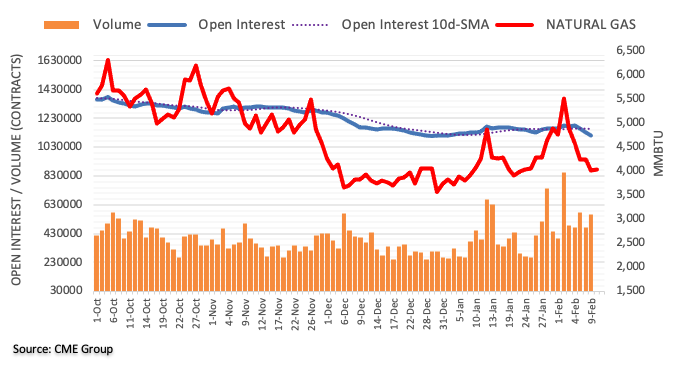
NZD/USD faces a potential move to the 0.6720 in the next weeks, suggested FX Strategists at UOB Group.
Key Quotes
24-hour view: “We expected NZD to strengthen yesterday but we were of the view that ‘any advance is unlikely to break 0.6685’. The subsequent advance exceeded our expectations as NZD soared to 0.6698. The rapid rise appears to be overdone and NZD is unlikely to advance further. For today, NZD is more likely to trade sideways, expected to be between 0.6650 and 0.6700.”
Next 1-3 weeks: “We have held the same view since Monday (07 Feb, spot at 0.6605) where NZD is in a consolidation and is likely to trade between 0.6545 and 0.6685. After trading sideways for a few days, NZD rose above the top of the expected range (high of 0.6698 during NY session). Upward momentum is beginning to build and NZD is likely to trade with an upward bias towards 0.6720. The upward bias is intact as long as NZD does not drop below the ‘strong support’ level, currently at 0.6620.”
CME Group’s flash data for crude oil futures markets noted traders added around 2.5K contracts to their open interest positions on Wednesday, extending the uptrend for the sixth day in a row. Volume followed suit and went up by around 155.2K contracts, keeping the choppy activity unchanged so far.
WTI: Rally takes a breather
Prices of the WTI charted an inconclusive session on Wednesday in tandem with rising open interest and volume, indicative that further consolidation remains in the pipeline at least in the very near term. In the meantime, occasional bullish attempts remain capped by the recent 7-year highs past the $93.00 mark per barrel.
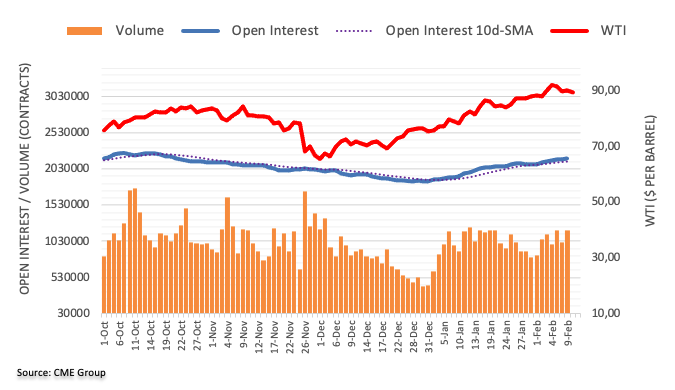
- USD/JPY regained traction on Thursday and shot to a one-month high, around the 115.70 area.
- A generally positive risk tone undermined the safe-haven JPY and acted as a tailwind for the pair.
- Hawkish Fed expectations, elevated US bond yields remained supportive ahead of the US CPI data.
The USD/JPY pair continued scaling higher heading into the European session and touched a one-month high, around the 115.70 region in the last hour.
Following the previous day's modest downtick, the USD/JPY pair caught fresh bids on Thursday and might now be looking to build on its recent bullish momentum witnessed over the past one week or so. A generally positive tone around the equity markets undermined the safe-haven Japanese yen and acted as a tailwind for the major. Bulls further took cues from elevated US Treasury bond yields, bolstered by hawkish Fed expectations, which continued extending some support to the US dollar.
Investors seem convinced that the US central bank would adopt a more aggressive policy response to combat stubbornly high inflation. Moreover, the markets have been pricing in the possibility of a 50 bps Fed rate hike in March. This, in turn, had pushed the US bond yields to multi-year highs earlier this week. Hence, the US CPI report for January, due later during the early North American session, could provide fresh clues about the pace of the Fed's policy tightening cycle.
This, in turn, will play a key role in influencing the near-term USD price dynamics and help traders to determine the next leg of a directional move for the USD/JPY pair. Apart from this, Thursday's US economic docket also features the release of the usual Weekly Initial Jobless Claims. This, along with the US bond yields, will drive the USD demand. Traders will further take cues from the broader market risk sentiment to grab some short-term opportunities around the major.
Technical levels to watch
Gold price has taken a breather after the recent upsurge, preserving most of Wednesday’s gains. XAU/USD’s further upside hinges on all-important US inflation, FXStreet’s Dhwani Mehta reports.
US inflation rate to exceed 7% YoY, boost aggressive Fed’s tightening bets
“The US annualized Consumer Price Index (CPI) is seen higher at 7.3% In January vs. 7.0% booked previously. A 40-year high inflation rate in America will likely compel the Fed to deliver aggressive and faster rate increases.”
“A fresh upswing towards the $1,840 round figure could be in the offing on successful clearance of Wednesday’s high at $1,836. Further up, a test of the $1,850 psychological level remains in play.”
“A big beat on the US CPI reading could trigger a pullback in gold price towards the previous day’s low of $1,825, below which the 21-DMA at $1,820 will be challenged. A sharp drop towards the 50- and 200-DMAs crossover around $1,807 will be witnessed if the selling pressure intensifies.”
See – Gold Price Forecast: XAU/USD to break under $1,745 and start a sustained downtrend in July – TDS
- USD/IDR snaps three-day downtrend, stays pressured around weekly low.
- BI is expected to keep monetary policy, benchmark rate unchanged.
- Convergence of 200-DMA, seven-week-old support line restricts short-term downside.
- MACD teases bears, clear trading above $14,450 becomes necessary for bull’s conviction.
USD/IDR struggles to extend previous three-day downtrend around the weekly bottom as the pair traders await monetary policy decision from the Bank Indonesia (BI) during early Thursday morning in Europe. That said, BI is widely anticipated to keep the benchmark rate unchanged at 3.5%.
In addition to the BI concerns, the market’s anxiety ahead of the US Consumer Price Index (CPI) data for January, expected 7.3% YoY versus 7.0% prior, also challenges the USD/IDR pair’s latest moves.
Read: US Treasury yields dwindle, S&P 500 Futures ignore Wall Street gains amid inflation anxiety
Technically, a convergence of the 200-DMA and an upward sloping trend line from late December restrict the immediate downside of USD/IDR around $14,330.
However, the MACD teases bears and can result in the pair’s further declines towards the initial 2022 lows near $14,270.
It should be observed that the USD/IDR seller’s dominance past $14,270 could highlight the December 2021 bottom of $14,140.
Alternatively, recovery moves may initially aim for the 61.8% Fibonacci retracement (Fibo.) of December 2021 downside, around $14,385.
Though, USD/IDR bulls remain cautious until witnessing a decisive break above the $14,450 hurdle.
To sum up, bears keep reins ahead of the key catalysts, namely Bank Indonesia Rate and US inflation readings.
USD/IDR: Daily chart
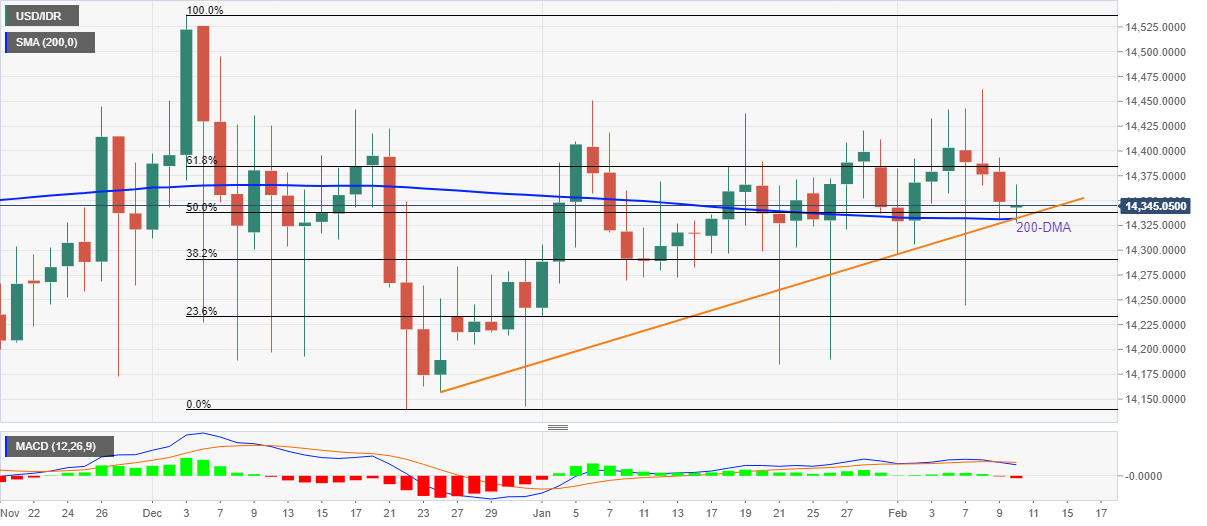
Trend: Further weakness expected
Analysts at Citigroup offer their bullish outlook on the EUR/USD pair, despite ECB's Villeroy's push back on hawkish rhetoric, earlier this week.
Key quotes
"EUR continued fluctuating post the European close and into Asian trading. Our traders noted that post ECB's Villeroy's push back on hawkish rhetoric, the lacking response showed that markets see tightening as essential this year."
"CitiFX Technicals also sees developments in the US-German 10y spread potentially supporting EUR. That upside case puts the 1.1483-1.161 resistance range and potentially 1.17+ are on watch.”
FX Strategists at UOB Group noted a near-term move to 1.3645 in Cable appears to be losing traction.
Key Quotes
24-hour view: “Yesterday, we expected to GBP to ‘trade sideways within a range of 1.3515/1.3575’. However, GBP popped to a high of 1.3590 before dropping back down to end the day little changed at 1.3536 (-0.08%). The underlying has softened somewhat and the bias is on the downside. That said, any weakness is unlikely to break the strong support at 1.3485 (minor support is at 1.3515). Resistance is at 1.3555 followed by 1.3580.”
Next 1-3 weeks: “We have held the same view since Monday (07 Feb, spot at 1.3530). As highlighted, while upward momentum is beginning to wane, there is chance, albeit not a high one for GBP to make one more push higher to 1.3645. There is no change in our view for now even though after trading sideways for a few days, upward momentum has waned further and the chance for GBP to push higher to 1.3645 has diminished considerably. In order to rejuvenate the flagging momentum, GBP has to move and stay above 1.3590 within these 1 to 2 days or a break of 1.3490 (‘strong support’ level was at 1.3470 yesterday) would indicate that GBP is not ready to head higher to 1.3645.”
Open interest in gold futures markets increased for the third session in a row on Wednesday, this time by nearly 8K contracts considering preliminary readings from CME Group. Volume, instead, reversed the previous build and shrank by around 11.5K contracts.
Gold still eyes a move to 2022 high
Gold extended the uptrend for yet another session on Wednesday, surpassing the $1,830 region amidst rising open interest. That said, the door remains open for the continuation of the strong recovery with the immediate target at the YTD peak at $1,853 per ounce troy.

In opinion of FX Strategists at UOB Group, EUR/USD could advance to 1.1520 once it clears 1.1485.
Key Quotes
24-hour view: “We expected EUR to ‘trade sideways between 1.1390 and 1.1445’ yesterday. Our view for consolidation was not wrong even though EUR traded within a narrower range than expected (1.1401/1.1447). The consolidation over the past few days appears to be drawing to a close and the upside risk is greater. A clear break of 1.1455 could lead to a quick rise to the major resistance at 1.1485. That said, if EUR breaks the support at 1.1390, it could trigger a drop to 1.1360.”
Next 1-3 weeks: “On Monday (07 Feb, spot at 1.1450), we highlighted that overbought shorter-term conditions could lead to a couple of days of consolidation first. We added, ‘as long as 1.1360 is not breached, the recent rally could extend further but EUR has to break the major resistance at 1.1485 before a move to 1.1520 can be expected’. In line with our expectations, EUR consolidated over the past few days. The consolidation phase appears to be coming to an end and a break of 1.1455 could lead to a quick rise to 1.1485. At this stage, the chance of a sustained rise above 1.1485 is not that high but it would remain intact as long as the ‘strong support’ level at 1.1360 is not breached.”
- USD/CAD licks its wounds around intraday low amid anxious markets.
- WTI crude oil fades bounce off weekly low amid supply concerns, less noise over Russia.
- BOC’s Macklem cited evidence to confirm easing global supply chain issues, inflation.
- US CPI becomes the key data to watch for near-term direction.
USD/CAD remains pressured around 1.2675 while portraying the market’s indecision heading into Thursday’s European session.
In addition to the anxiety ahead of the US Consumer Price Index (CPI) data for January, downbeat oil prices and recently mixed comments from Bank of Canada (BOC) Governor Tiff Macklem also restrict USD/CAD moves of late.
That said, the inflation fears are high in the US, pushing the Fed towards faster rate hikes. While confirming the same, the White House (WH) conveyed expectations of a higher YoY inflation figure and said, “Its irrelevant month on month number will continue trending lower the rest of the year.” Following that, WH Economic Adviser Brian Deese said that he sees reason to think that factors boosting inflation will moderate over time.
On the other hand, Cleveland Fed President Loretta Mester supported the March rate hike while Atlanta Federal Reserve President Raphael Bostic told CNBC on Wednesday he is hopeful that they will start to see a decline in inflation. Fed’s Bostic also said, "Leaning toward the need for a fourth interest rate increase in 2022."
It’s worth noting BOC’s Macklem said, “The global supply chain problems may have peaked.” The policymaker blames supply chain issues for higher inflation while also saying that Canadians should expect a rising path of interest rates.
Moving on, WTI crude oil prices dropped 0.65% to $88.50 at the latest, fading the previous day’s bounce from weekly low.
Against this backdrop, the US Treasury yields remain sidelined after stepping back from the highest levels since July 2019 whereas stock futures in the US and Europe print losses.
Given the market’s risk-off mood and cautious sentiment ahead of the key US data, USD/CAD traders may witness further grinding until the US CPI for January releases, expected 7.3% YoY versus 7.0% prior. It’s worth noting that the downbeat figures may allow the Loonie pair to pare recent losses.
Read: US Consumer Price Index January Preview: Is this inflation different?
Technical analysis
A daily closing below the 50-day EMA level surrounding 1.2665 becomes necessary for the USD/CAD bears to keep reins, otherwise another run-up towards a five-week-old resistance line near 1.2785 can’t be ruled out.
“Chance of Japan’s consumer inflation accelerating sharply is very small”, Bank of Japan (BOJ) Governor Haruhiko Kuroda said on Thursday.
Additional quotes
Must continue monetary easing bit longer as inflation short of 2%.
Wage growth holds key for Japan to see inflation sustainably accelerate near 2%.
Can't say how widening US-Japan interest rate differentials would affect forex moves.
Monetary policy direction of central banks does not necessarily have to be in same direction.
True that households find it hard tolerate price rises.
Commodity price fluctuations tend to be temporary so inappropriate to address them with monetary policy.
Prolonged monetary easing helped boost corporate profits, put end to Japan’s deflation so not entirely bad for financial institutions.
Premature to debate exit from easy policy during my remaining term as BOJ governor.
Expect wages will gradually rise at a faster pace.
We are not engaging in any specific debate on exit policy, no chance we will do so during my remaining term as BOJ governor.
Market reaction
USD/JPY is currently trading near-daily highs of 115.65, up 0.13% on the day. The spot is gaining ground amidst a minor rebound in the US Treasury yields alongside the dollar.
- Markets in Asia-Pacific region trade mixed amid pre-CPI anxiety.
- India’s BSE Sensex gains on RBI status-quo, Evergrande fails to placate Chinese bears.
- Chatters over RBNZ’s move should rely totally on inflation weigh on NZX 50.
- ASX 200 print mild gains despite upbeat inflation expectations, RBA rate-hike chatters.
Asia-Pacific investors struggle for clear directions with eyes on the US headline inflation data. Also challenging the market sentiment are the mixed signals flashed by domestic catalysts during early Thursday morning in Europe.
While portraying the mood, the MSCI’s index of Asia-Pacific shares ex-Japan rises 0.40%, the same as Japan’s Nikkei 225. However, markets in China, Hong Kong and New Zealand remain on the back foot.
That said, stock futures in the US and Europe also print mild losses whereas the US 10-year Treasury yields seesaw around the highest levels since July 2019, pausing the previous day’s pullback of late.
Japan’s Producer Price Index (PPI) for January hit the highest levels since 1985 but Bank of Japan (BOJ) Governor Haruhiko Kuroda sees the limited possibility of a major inflation surge.
Elsewhere, China’s Evergrande Chairman vows full construction and no fire sales of properties but can’t convince stock bulls amid the Sino-American tussles.
Furthermore, Australia’s Consumer Inflation Expectations increased for February and Deloitte’s latest bi-annual survey of Australia’s headline Chief Financial Officers (CFOs) signaled RBA’s rate hike in 2022, which in turn challenges ASX 200 of late.
It should be noted that New Zealand’s opposition party leader Luxon mentioned that the RBNZ should concentrate entirely on inflation, which in turn dragged NZX 50.
South Korea’s KOSPI and Indonesia’s IDX Composite print mild gains while India’s BSE Sensex rise the most among the region as the Reserve Bank of India (RBI) kept benchmark rates unchanged during today’s monetary policy meeting.
Moving on, market players will keep their eyes on the US Consumer Price Index (CPI) for January, expected 7.3% YoY versus 7.3% prior, for fresh impulse.
Read: US Treasury yields dwindle, S&P 500 Futures ignore Wall Street gains amid inflation anxiety
- NZD/USD dribbles around two-week top, remains pressured of late.
- Failures to cross two-month-old support-turned-resistance join steady RSI to keep sellers hopeful.
- Convergence of 10-DMA, fortnight-old support line limits short-term declines.
NZD/USD struggles to extend three-day top, recently downbeat around 0.6680 ahead of Thursday’s European session.
In doing so, the Kiwi pair portrays the failure to cross lows marked in December 2021 around 0.6700. Adding to the bearish bias is the steady RSI and multiple hurdles on the north.
That said, the pair’s pullback needs validation from a confluence of the 10-DMA and an ascending trend line from January 28, near 0.6630.
Following that, the 0.6600 threshold and yearly bottom surrounding 0.6530 may entertain NZD/USD bears.
On the flip side, a clear break of the 0.6700 will direct NZD/USD prices towards the 50-DMA level near 0.6745.
However, a descending resistance line from October 28 will challenge the pair’s further upside around 0.6770.
Overall, NZD/USD remains on the bear’s radar with eyes on 0.6630.
NZD/USD: Daily chart
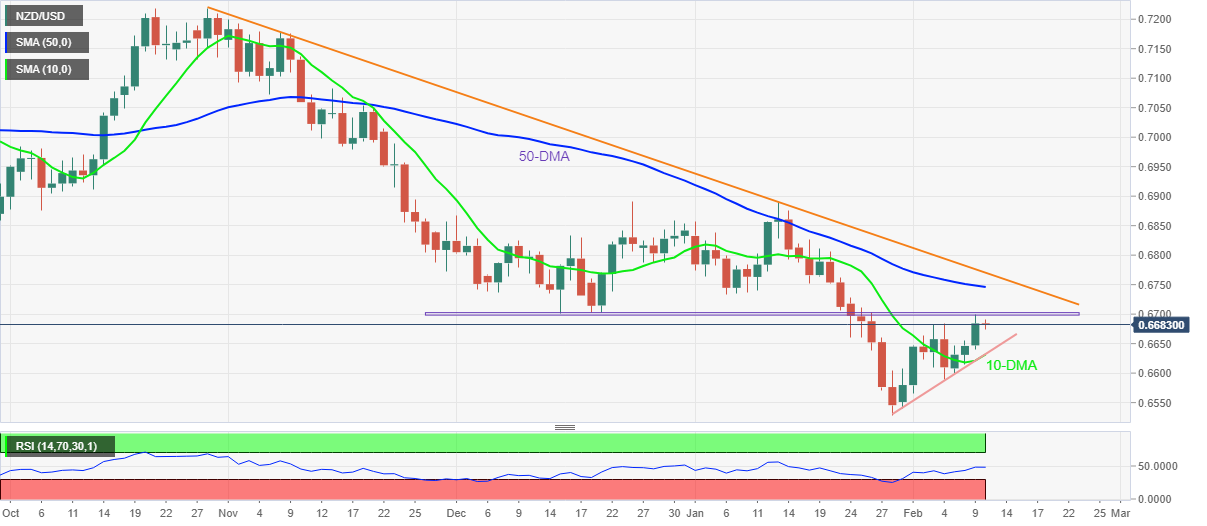
Trend: Pullback expected
- EUR/USD retreats from intraday top, challenges the previous day’s rebound from weekly low.
- Yields dribble, stock futures print mild losses ahead of the key events.
- ECB policymakers contrasted Fed speakers, draft EU forecast suggests softer inflation, GDP growth.
- High hopes from US CPI for January can disappoint pair sellers.
EUR/USD nullifies early Asian session gains while dropping back to 1.1425 heading into Thursday’s European session.
The major currency pair’s prior gains could be linked to the broad US dollar weakness. However, the market’s anxiety ahead of the key US Consumer Price Index (CPI) data and quarterly release of the European Commission Economic Forecasts seem to challenge the buyers of late.
That said, Bloomberg claims to have seen a draft report for the EU economic forecasts suggesting inflation is likely to ease in 2023 while the GDP may improve. That said, the growth figures are cut in 2022 by 0.3% to 4.0% whereas inflation figures are likely to arrive at 3.5% for the current year.
“Euro-area inflation will ease below the European Central Bank’s 2% target next year, according to new draft projections from the European Union that will feed the growing debate about how quickly to raise interest rates,” said Bloomberg.
On the other hand, the White House (WH) conveyed expectations of a higher YoY inflation figure while also saying, “Its irrelevant month on month number will continue trending lower the rest of the year.” Following that, WH Economic Adviser Brian Deese said that he sees reason to think that factors boosting inflation will moderate over time.
It’s worth noting that the European Central Bank (ECB) Executive Board Member Isabel Schnabel said, “Inflation will remain high for longer than anticipated.” However, her comments like, “Raising rates would not lower energy prices,” seem to challenge ECB hawks. On the same line were comments from Bundesbank President and ECB Board Member Joachim Nagel. ECB”s Nagel said, "First step would be to end bond purchases, then rates could already rise in 2022."
Amid these plays, the US Treasury yields remain sidelined after stepping back from the highest levels since July 2019 whereas stock futures in the US and Europe print losses.
Even if the Bloomberg article reduced the importance of the EU Economic Forecasts, the final verdict is still awaited and hence becomes important for the EUR/USD traders. Should the economics keep suggesting blurry pictures ahead, the quote may witness further downside.
Above all, US inflation data for January, expected 7.3% YoY versus 7.3% prior, will be crucial considering the high hopes from the CPI data, also due to chatters over 0.50% Fed rate hike in March.
Read: US Inflation Preview: Core CPI above 6% could spark next dollar rally
Technical analysis
A three-month-old horizontal area surrounding 1.1485 restricts short-term EUR/USD upside ahead of October 2021 low near 1.1530.
Alternatively, highs marked in November and December of 2021, near 1.1385, put a floor under the pair’s immediate declines.
- USD/INR crosses short-term key hurdle during three-day run-up, refresh two-week top.
- RBI keeps policy rates unchanged, cites supply constraints.
- Market sentiment remains sluggish as traders await US CPI for January amid mixed concerns over March rate hikes.
USD/INR takes the bids to refresh fortnight high around 75.01, up 0.33% intraday following the RBI inaction on early Thursday. In doing so, the Indian rupee (INR) pair also justifies the market’s risk-off mood ahead of the key US Consumer Price Index (CPI) data for January.
The Reserve Bank of India (RBI) keeps the benchmark interest rate (Repo) unchanged at 4.0% while also holding the Reverse Repo Rate intact at 3.55% at the end of the latest monetary policy meeting.
While conveying the monetary policy decisions, RBI Governor Shaktikanta Das quotes the International Monetary Fund (IMF) statement suggesting that India is poised to grow at the fastest pace among global economies. The RBI Chief also said, “Supply chain disruptions persist.”
“Headline inflation expected to peak in Q4, real GDP growth projected at 7.8% for 2022/23,” adds RBI’s Das.
Other than the RBI verdict and fears of inflation, the sour sentiment in the market also propels USD/INR prices.
Risk appetite remains weak amid fears over the Fed’s next move in March, considering the hot inflation and supply chain disruptions. On Wednesday, the White House (WH) conveyed expectations of a higher YoY inflation figure while also saying, “Its irrelevant month on month number will continue trending lower the rest of the year.” Following that, WH Economic Adviser Brian Deese said that he sees reason to think that factors boosting inflation will moderate over time.
Additionally, Cleveland Fed President Loretta Mester supported the March rate hike while Atlanta Federal Reserve President Raphael Bostic told CNBC on Wednesday he is hopeful that they will start to see a decline in inflation. Fed’s Bostic also said, "Leaning toward the need for a fourth interest rate increase in 2022."
Looking forward, USD/INR moves are likely to rely on the US inflation data for January, expected 7.3% YoY versus 7.3% prior. Given the higher hopes, any disappointment can easily pull back the pair prices.
Read: US Inflation Preview: Core CPI above 6% could spark next dollar rally
Technical analysis
A daily closing beyond the convergence of the two-month-old descending trend line and 50-DMA, near 74.90, becomes necessary for the USD/INR bulls to keep reins. However, the pair bears need to conquer the 21-DMA level of 74.65 to retake control.
Meanwhile, USD/INR bulls need validation from the 75.00 threshold, even after crossing the 74.90 hurdle, to aim for January’s peak of 75.35.
- GBP/USD remains pressured after stepping back from weekly top, recently sidelined.
- EU files first post-Brexit court case against UK, PM Johnson reacts with “show some common sense”.
- BOE’s Pill cites uncertainty on rate hikes, BOE Governor Bailey was previously criticized for late action.
- US CPI for January, BOE’s Bailey will offer double attack and hence warrant caution.
GBP/USD treads water around 1.3530 during the late Asian session on Thursday. The cable pair refreshed weekly top the previous day before reversing from 1.3589.
The pullback moves, however, struggle amid the market’s anxiety ahead of crucial US Consumer Price Index (CPI) data and speech from the Bank of England (BOE) Governor Andrew Bailey.
Although the US Dollar Index (DXY) remains pressured amid mixed concerns over inflation and the Fed’s future moves, the GBP/USD can’t ignore pessimism surrounding Brexit and UK politics. Also challenging the cable pair are the latest comments from BOE Chief Economic Huw Pill who said that a case can be made for a measured rather than an activist approach to policy decisions.
That said, the White House (WH) conveyed expectations of a higher YoY inflation figure but WH Economic Adviser Brian Deese said that he sees reason to think that factors boosting inflation will moderate over time.
It’s worth noting that the recent Fedspeak, comprising comments from Cleveland Fed President Loretta Mester and Atlanta Fed President Raphael Bostic, does support the March rate-hike but fails to clear uncertainty over the pace of lift.
Elsewhere, the European Union (EU) filed a court case against the UK, the first after Brexit, on ordering the Romanian government to pay compensation to investors who lost out on state subsidies, per the Financial Times (FT). “The referral comes as London and Brussels are locked in talks over possible changes to the Northern Ireland protocol, which governs post-Brexit trade on the island of Ireland,” said the news. Following the news, UK PM Boris Johnson reiterated a warning to trigger Article 16 on conditions "if our friends don't show the require common sense" per UK Express.
It should be observed that UK political jitters over ‘Partygate’ also test GBP/USD bulls.
Amid these plays, the US 10-year Treasury yields pause the previous day’s pullback from the highest levels since July 2019, hovering around 1.930-925% of late. Also portraying the cautious sentiment in the market, as well as challenging gold buyers, is the steady S&P 500 Futures despite Wall Street’s upbeat performance on tech-rally and strong earnings, as well as mixed moves of the Asia-Pacific stocks.
Looking forward, US CPI will be the first to shake GBP/USD prices, expected towards the south if the inflation reading march upbeat forecast. However, BOE’s Bailey needs to defend the rate hike and signal more to ward off the criticism over his late action and for suggesting workers stop pushing for higher wages to defend the GBP/USD buyers. Hence, the pair has more downside risk than the otherwise.
Read: US Consumer Price Index January Preview: Is this inflation different?
Technical analysis
GBP/USD stays within the weekly range between the 21-DMA and 100-DMA. However, the recently downbeat Momentum line favors sellers.
That said, a clear downside break of the 100-DMA level near 1.3500 becomes necessary for the bears before targeting 50% and 61.8% Fibonacci retracement of December-January run-up, respectively around 1.3450 and 1.3385.
On the contrary, the 21-DMA and aforementioned resistance line, close to 1.3545 and 1.3585 in that order, guard the GBP/USD pair’s short-term upside.
- AUD/USD extends pullback from three-week high towards previous resistance.
- Bullish MACD keeps buyers hopeful to aim for 100-DMA, key Fibonacci retracements can test run-up afterward.
- Confluence of 50-DMA, monthly descending trend line restricts immediate declines.
- Fortnight-long ascending trend line adds to the downside filters.
AUD/USD remains pressured around intraday low, down 0.20% near 0.7170 during the first negative daily performance amid Thursday’s Asian session.
In doing so, the Aussie pair battles a convergence of the 50-DMA and previous resistance line from January 13, around 0.7160.
Given the bullish MACD signals, AUD/USD buyers remain hopeful until witnessing a clear downside break of the 0.7160 key resistance-turned-support level.
Even if the quote drops below 0.7160, a two-week-old rising support line near 0.7115 will challenge the pair bears before giving them control.
Meanwhile, 38.2% Fibonacci retracement (Fibo.) of October 2021 to January 2022 downside, close to 0.7195, joins the 0.7200 threshold to restrict the AUD/USD pair’s short-term advances.
However, the 100-DMA level of 0.7250 and 50% Fibo. around 0.7265 act as important resistances to watch during the quote’s further upside.
AUD/USD: Daily chart
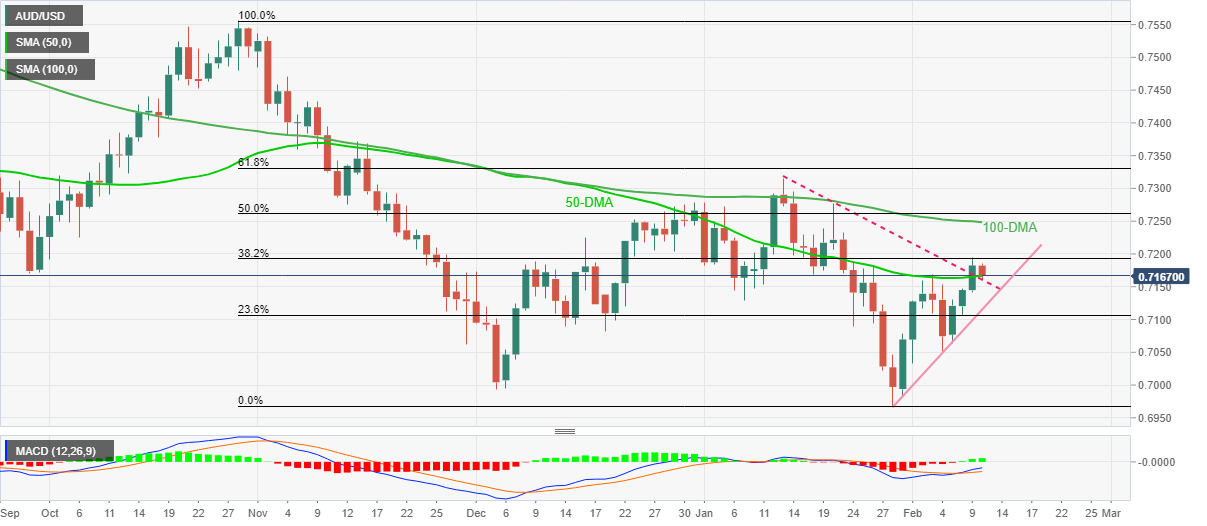
Trend: Further upside expected
In a telephonic conversation with US President Joe Biden on Wednesday, Saudi Arabia’s King Salman said that the role of the OPEC and its allies (OPEC+) agreement is important to maintain.
King Salman “stressed the importance of maintaining balance and stability in the oil markets, highlighting the role of the historic OPEC Plus agreement in this regard, and the importance of maintaining the agreement,” the state news agency (SPA) reported.
- USD/CHF is stable in low volatility ahead of the US inflation data.
- Federal Reserve sentiment could well kick into an otherwise risk-friendly environment.
At 0.9242, USD/CHF is flat on the day as traders get ready for the US Consumer Price Index that will be released in the US morning, expected to seal the deal for March lift-off at the Federal Reserve. USD/CHF has traded between a tight consolidative range of between 0.9240 and 0.9247 so far in Asia.
Improved risk sentiment has enabled global stocks to firm on Wednesday. The Dow Jones Industrial Average (DJI) added 0.86% to end at 35,768.06 points, while the S&P 500 rallied 1.45% to 4,587.18. The Nasdaq Composite (IXIC) climbed 2.08% to 14,490.37. MSCI's broadest index of Asia-Pacific shares outside Japan was 1.8% higher and moved into a more than two-week high. Additionally, positive news headlines over recent days suggesting tensions between the West and Russia over Ukraine have been dialled down has eased flows in the safe-havens, such as the Swiss franc.
US CPI data in focus
At this juncture, the markets will scrutinise the US inflation print, in anticipation of a strong number that would be expected to lift sentiment around Federal Reserve policy tightening. Markets are pricing in more than a 70% chance of a 25 basis point hike and a nearly 30% chance for a 50 basis point hike when U.S. policymakers meet in March, according to CME's FedWatch Tool. this comes a the markets are in anticipation that the US Consumer Price Index will have risen by over 7% year-over-year in January.
- US 10-year T-bond coupons remain sluggish after easing from 2.5-year high the previous day.
- S&P 500 Futures print mild losses despite Wall Street benchmarks rose.
- White House, Fedspeak propel inflation fears, Sino-American tussles escalate as well.
Global markets portray a typical pre-data cautious mood during early Thursday as traders await the US headline inflation figures.
That said, the US 10-year Treasury yields pause the previous day’s pullback from the highest levels since July 2019, hovering around 1.930-925% of late. Also portraying the cautious sentiment in the market, as well as challenging gold buyers, is the steady S&P 500 Futures despite Wall Street’s upbeat performance on tech-rally and strong earnings, as well as mixed moves of the Asia-Pacific stocks.
Read: Mid-afternoon market update: Dow jumps 350 points; US ecology shares Spike higher
Comments from the White House could be cited as the key catalyst to weigh on recent risk appetite while Fedspeak favoring March rate-hike and the US-China trade tensions also exert downside pressure on the market sentiment.
The White House (WH) conveyed expectations of a higher YoY inflation figure while also saying, “Its irrelevant month on month number will continue trending lower the rest of the year.” Following that, WH Economic Adviser Brian Deese said that he sees reason to think that factors boosting inflation will moderate over time.
Moving on, Cleveland Fed President Loretta Mester supported the March rate hike while Atlanta Federal Reserve President Raphael Bostic told CNBC on Wednesday he is hopeful that they will start to see a decline in inflation. Fed’s Bostic also said, "Leaning toward the need for a fourth interest rate increase in 2022."
Elsewhere, China’s inability to match Phase 1 deal targets seems to push US authorities towards discussing sanctions should the tension escalate. Recently, Reuters cited officials from the largest US Chamber of Commerce, the country’s business lobbying group to mention the trade war fears. “The US President Joe Biden’s administration is contemplating a new China tariff investigation if current talks fail to persuade Beijing to follow through on its promised purchases of American goods, energy and services,” said the news.
It should be noted that the fears of Russia’s invasion of Ukraine also test optimist even as the US Consumer Price Index (CPI) for January gains the most attention.
Given the higher hopes from the US CPI for January, expected 7.3% YoY versus 7.0% prior, fears of disappointment and a shaky move portray risk-off mood in the markets. Though, prices of gold seem to cheer softer USD while WTI crude oil remains on the back foot at the latest.
Read: US Consumer Price Index January Preview: Is this inflation different?
| Raw materials | Closed | Change, % |
|---|---|---|
| Brent | 91.72 | 0.8 |
| Silver | 23.308 | 0.57 |
| Gold | 1832.89 | 0.39 |
| Palladium | 2278.75 | 1.55 |
The US President Joe Biden’s administration is contemplating a new China tariff investigation if current talks fail to persuade Beijing to follow through on its promised purchases of American goods, energy and services, Reuters reported, citing officials from the largest US Chamber of Commerce, the country’s business lobbying group.
- EUR/GBP grinds higher around daily top after reversing from 50-DMA on Wednesday.
- Bullish MACD signals hint at further upside towards 100-DMA.
- Convergence of descending trend line from September, 61.8% Fibonacci retracement becomes key hurdle.
EUR/GBP holds onto the previous day’s recovery moves around 0.8445 as markets brace for crucial weekly data/events during Thursday’s Asian session.
In doing so, the cross-currency pair justifies the latest U-turn from the 50-DMA amid bullish MACD signals.
However, the 100-DMA level surrounding 0.8455 challenges the quote’s further upside, a break of which will direct EUR/GBP buyers towards the 50% Fibonacci retracement (Fibo.) of September 2021 to February 2022 downside, around 0.8470.
Following that, a confluence of the 61.8% Fibo. and a descending resistance line from September 29, near 0.8515, becomes a tough nut to crack for the bulls.
Alternatively, pullback moves remain elusive beyond the 50-DMA level of 0.8417, a break of which will direct the quote towards the November 2021 low of 0.8380.
Should EUR/GBP bears keep reins past-0.8380, the 0.8330 and the 0.8300 levels may test the downside momentum targeting to refresh the multi-day low of 0.8284.
EUR/GBP: Daily chart
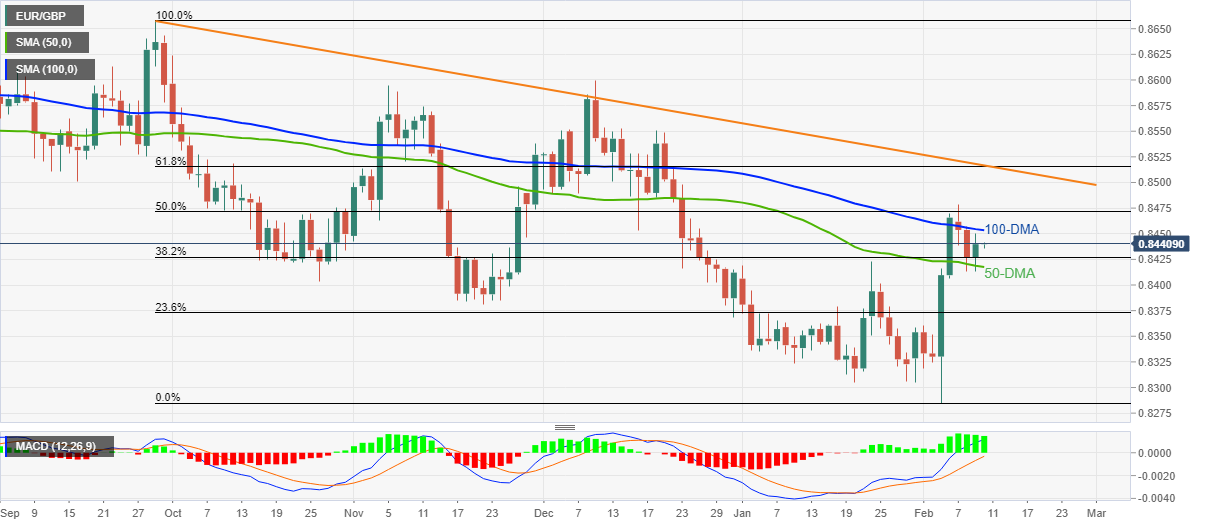
Trend: Further upside expected
- EUR/JPY idles in the consolidation of last weeks rally as traders get set for US CPI data.
- The cross is making a series of higher lows, so there is wind beneath it still.
At 131.92, EUR/JPY is flat on the session and sticking to a 131.86, 132.04 range so far on the day as traders await, in high anticipation, for the US inflation data scheduled for the New York morning session.
the cross is consolidating a parabolic move in the daily from the 3rd Feb business which followed a surprisingly hawkish outcome of the European Central Bank meeting. The governor of the ECB, Christine Lagarde said inflation risks were said to be tilted to the upside and there was no repeat of a comment that a 2022 hike was very unlikely. Instead. some policymakers wanted to take action on Thursday's meeting and the markets reacted in kind. The euro shot higher, extending its recovery vs. the US dollar and the cross followed in tow.
However, as the dust settled and on conflicting comments at the start of the week from Lagarde, the euro turned on a dime. It has continued to retreat from near a three-month high to Japan's currency mid-week. The ECB's Lagarde said on Monday there was no need for extensive tightening, trying to temper rising expectations for aggressive action after she last week opened the door a crack to a potential rate rise this year.
Meanwhile, improved risk sentiment, however, has helped to put a floor under the cross that is making a series of higher daily lows this week. World stocks rallied on Wednesday. European bourses were gaining on strong earnings as investors put aside worries about rising interest rates for now. With that being said, the greenback touched a one-month high versus the yen on Wednesday, boosted by a climb in Treasury yields to multi-year peaks in anticipation of strong inflation data later today. The data could boost sentiment around Federal Reserve policy tightening.
Markets are pricing in more than a 70% chance of a 25 basis point hike and a nearly 30% chance for a 50 basis point hike when U.S. policymakers meet in March, according to CME's FedWatch Tool. this comes a the markets are in anticipation that the US Consumer Price Index will have risen by over 7% year-over-year in January.
EUR/JPY technical analysis
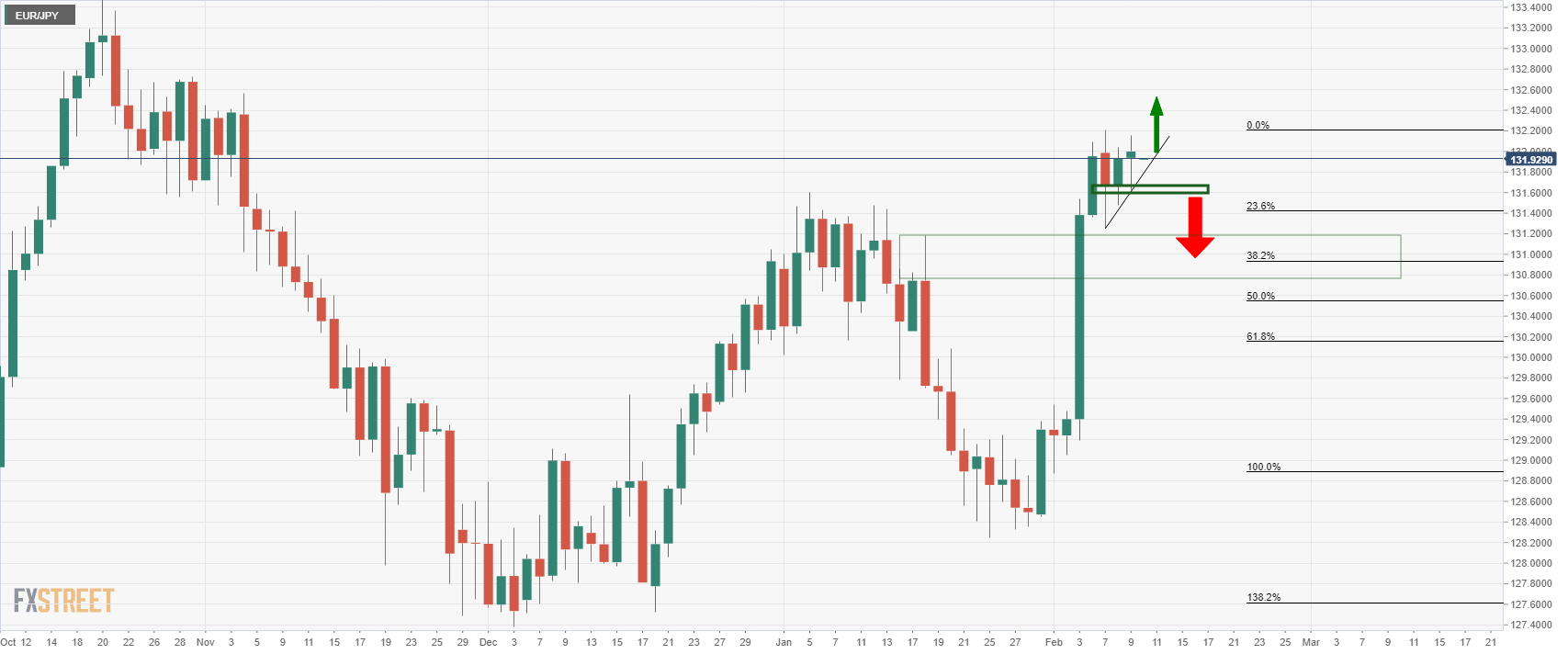
Following the release of Japan’s Wholesale Price Index (WPI), earlier on, a Bank of Japan (BOJ) official said that “companies continue to pass on higher raw material costs to sales prices, although moderately.
“Year-on-year pace of wholesale price rise slowing but more items seeing prices rise,” the official added.
Japan’s wholesale prices marked an annualized rise in January for the 11th straight month. The WPI index rose to 109.5, the highest level since September 1985.
Market reaction
USD/JPY is keeping its range around 115.50, up 0.04% on the day. The pair awaits the US inflation data, as US Treasury yields maintain the corrective downside while the dollar rebound amid a mixed market sentiment.
- Gold takes the bids to refresh intraday high, extends four-day uptrend around fortnight top.
- US T-bond yields regain upside momentum as White House, Fedspeak propels US CPI chatters.
- High hopes from US inflation keep the risk of disappointment on table, suggesting further advances.
- Gold Price Forecast: Broad dollar’s weakness makes gold shine
Gold (XAU/USD) buyers brace for the key day around a two-week high, picking up bids to $1,835 during Thursday’s Asian session.
The yellow metal recently cheered the downbeat US dollar and the market’s rush to traditional risk-safety amid inflation fears. However, the multi-day high Treasury yields challenge gold buyers ahead of crucial US Consumer Price Index (CPI) data for January, expected 7.3% YoY versus 7.0% prior.
Read: US Inflation Preview: Core CPI above 6% could spark next dollar rally
That said, the US Dollar Index (DXY) prints mild weekly gains around 95.55 while the US 10-year Treasury yields pause the previous day’s pullback from the highest levels since July 2019, up one basis point (bp) near 1.93%, by the press time.
Also portraying the cautious sentiment in the market, as well as challenging gold buyers, is the steady S&P 500 Futures despite Wall Street’s upbeat performance on tech-rally and strong earnings, as well as mixed moves of the Asia-Pacific stocks.
Among the key catalysts, the latest comments from the White House and the US Federal Reserve (Fed) official take the front seat.
The White House (WH) conveyed expectations of a higher YoY inflation figure while also saying, “Its irrelevant month on month number will continue trending lower the rest of the year.” Following that, WH Economic Adviser Brian Deese said that he sees reason to think that factors boosting inflation will moderate over time.
On the other hand, Cleveland Fed President Loretta Mester supported the March rate hike while Atlanta Federal Reserve President Raphael Bostic told CNBC on Wednesday he is hopeful that they will start to see a decline in inflation. Fed’s Bostic also said, "Leaning toward the need for a fourth interest rate increase in 2022."
It should be noted, however, that the sluggish prints of the US inflation expectations, as measured by the 10-year breakeven inflation rate per the St. Louis Federal Reserve (FRED) data, challenge the Fed hawks and keep gold buyers hopeful.
Elsewhere, the recent escalation in the US-China trade tussles and fears over Russia’s invasion of Ukraine seems to take a back seat for now as markets await US CPI figures for fresh impulse.
Technical analysis
Gold advances inside a three-month-old symmetrical triangle, piercing a six-week-long horizontal area of late.
Adding to the upside bias is the metal’s successful trading above 200-DMA and a five-week-old horizontal area amid recently firmer MACD signals and RSI.
That said, the 23.6% Fibonacci retracement (Fibo.) of September-November upside, near $1,841, acts as an intermediate halt during the run-up to the stated triangle’s resistance line around $1,850.
In a case where gold buyers manage to cross the $1,850 hurdle, January’s top near $1,853 will test the upside momentum targeting a late 2021 peak of $1,877.
On the flip side, pullback moves remain elusive until staying beyond $1,830, a break of which will direct gold sellers towards the 200-DMA level near $1,806.
Following that, 50% Fibo. level and the triangle’s support, respectively around $1,800 and $1,787, will be crucial for gold bears to retake control.
Gold: Daily chart
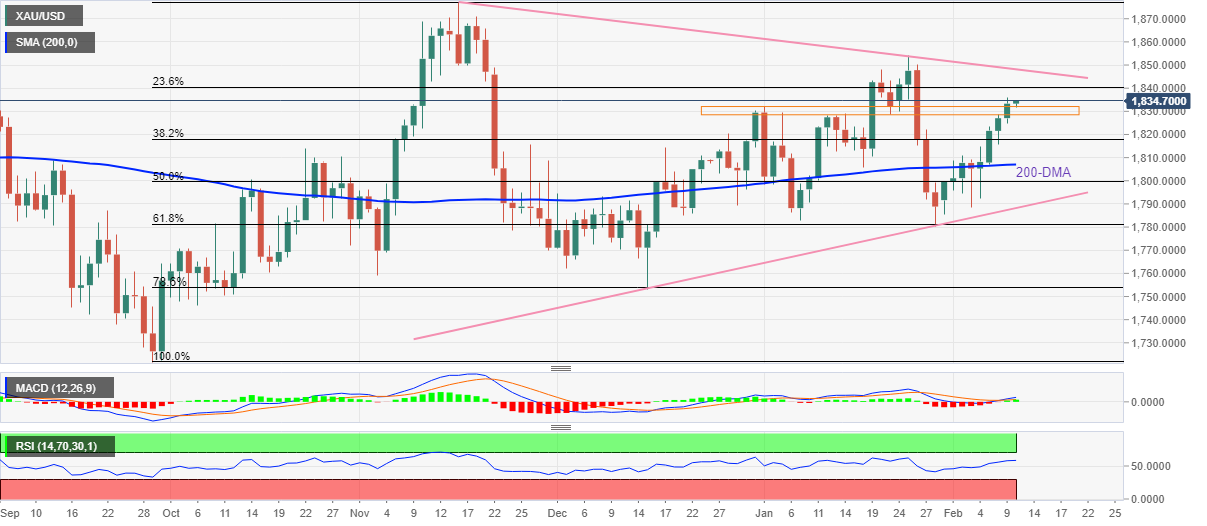
Trend: Further upside expected
Analysts at National Australia Bank (NAB) shed a light on their expectations of the US inflation data due for release later this Thursday.
Key quotes
“The consensus looking for 0.5%/7.3%, another solid monthly and higher annual read after 0.5%/7.0% for December.”
“Core CPI is also expected to have grown 0.5% m/m, annual growth pushing up to 5.9% from 5.5%.”
“Base effects will remain unhelpful until April.”
Read: US Consumer Price Index January Preview: Is this inflation different?
- DXY struggles for clear direction, pares latest losses amid market’s CPI-linked anxiety.
- White House hints at strong inflation figures but Economic Adviser Deese sees receding figures afterward, Fedspeak favors March rate hikes.
- US Jobless Claims, Sino-American tussles and Russian headlines may also entertain traders.
- Markets have high hopes from US CPI, which in turn pushes traders to remain cautious.
US Dollar Index (DXY) kick-starts the key day with a positive footing around 95.60 amid Thursday’s Asian session.
In doing so, the greenback gauge tracks firmer US Treasury yields amid the market’s anxiety ahead of the US Consumer Price Index (CPI) data, as well as cheer risks emanating from the US-China and Russia-Ukraine issues. Also contributing to the inflation fears are the latest comments from the White House and the Fed speakers.
US 10-year Treasury yields pause the previous day’s pullback from the highest levels since July 2019, up one basis point (bp) near 1.93% by the press time. The bond bears have recently dominated markets as inflation fears push the Fed towards a stark rate lift in March.
That said, the White House (WH) conveyed expectations of a higher YoY inflation figure while also saying, “Its irrelevant month on month number will continue trending lower the rest of the year.” Following that, WH Economic Adviser Brian Deese said that he sees reason to think that factors boosting inflation will moderate over time.
Moving on, Cleveland Fed President Loretta Mester supported the March rate hike while Atlanta Federal Reserve President Raphael Bostic told CNBC on Wednesday he is hopeful that they will start to see a decline in inflation. Fed’s Bostic also said, "Leaning toward the need for a fourth interest rate increase in 2022."
Amid these plays, S&P 500 Futures remain indecisive despite Wall Street’s upbeat performance on tech-rally and strong earnings whereas Asia-Pacific stocks also pare day-start gains.
Moving on, higher hopes from the US CPI for January, expected 7.3% YoY versus 7.0% prior, which in turn could give rise to the DXY’s further advances on matching the forecasts, due to the hopes of a 0.50% rate hike by the Fed in March. However, any disappointment won’t be taken lightly.
Read: US Consumer Price Index January Preview: Is this inflation different?
Technical analysis
Although the 100-DMA defends DXY bulls around 95.30, the upside momentum needs validation from the 96.00 threshold.
| Time | Country | Event | Period | Previous value | Forecast |
|---|---|---|---|---|---|
| 09:05 (GMT) | United Kingdom | BOE Gov Bailey Speaks | |||
| 13:30 (GMT) | U.S. | Continuing Jobless Claims | January | 1628 | 1615 |
| 13:30 (GMT) | U.S. | Initial Jobless Claims | February | 238 | 230 |
| 13:30 (GMT) | U.S. | CPI excluding food and energy, m/m | January | 0.6% | 0.5% |
| 13:30 (GMT) | U.S. | CPI, m/m | January | 0.6% | 0.5% |
| 13:30 (GMT) | U.S. | CPI, Y/Y | January | 7% | 7.3% |
| 13:30 (GMT) | U.S. | CPI excluding food and energy, Y/Y | January | 5.5% | 5.9% |
| 19:00 (GMT) | U.S. | Federal budget | January | -21 | 25 |
| 21:30 (GMT) | New Zealand | Business NZ PMI | January | 53.7 | |
| 22:30 (GMT) | Australia | RBA's Governor Philip Lowe Speaks |
- Silver retreats from monthly resistance, snaps four-day uptrend.
- RSI conditions hints at buyer’s exhaustion, three-week-old horizontal line adds to the upside filters.
Silver (XAG/USD) consolidates recent gains around $23.20, down 0.26% intraday during Thursday’s Asian session.
In doing so, the bright metal steps back from a two-week high, flashed the previous day, by justifying the strength of a one-month-old horizontal resistance area surrounding $23.25.
Also challenging the XAG/USD bulls are the RSI conditions that don’t back the recent highs.
Even so, silver sellers need to wait for a clear downside break of the 200-SMA level of $23.00 for fresh entries.
Following that, 61.8% Fibonacci retracement (Fibo.) of December-January upside, close to $22.65, may test the XAG/USD bears before directing them to the five-week-old support area near $22.00.
Meanwhile, recovery moves beyond the immediate hurdle around $23.25 isn’t a green card to the silver buyers as a horizontal line from January 18, near $23.65, will challenge the upside moves to the $24.00 threshold.
Should XAG/USD remains firm past $24.00, its run-up towards January’s high of $24.70 can’t be ruled out.
Silver: Four-hour chart
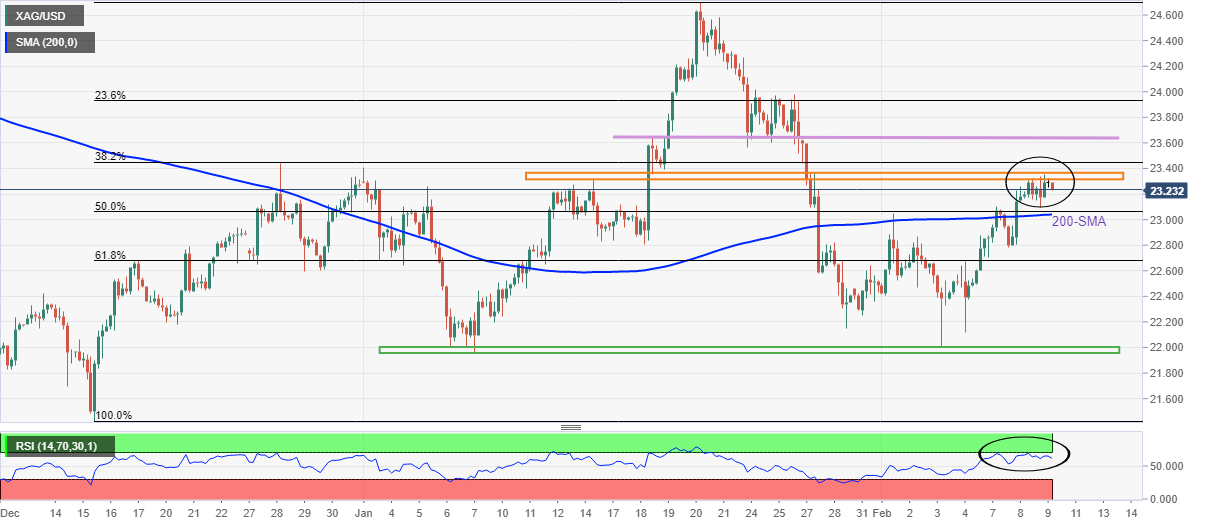
Trend: Pullback expected
- GBP/USD is steady in anticipation of the key US event in US CPI.
- Central bank divergences are the driving force in the majors this week.
GBP/USD is flat on the day and sitting patiently between 1.3526 and 1.3538 ahead of today;'s key event in the US Consumer Price Index.
The pound initially benefitted on the back of a soft dollar at the start of the week and dovish pivots in central bank sentiment at the European Central bank. However, the pound was a touch lower against a firmer single currency amid continued deep uncertainty about the future trajectory of the Bank of England’s monetary policy.
Bank of England Chief Economist Huw Pill was crossing the wires on Wednesday explaining that it was ''reasonable for central banks to withdraw from providing detailed guidance on the policy outlook as prospects for the economy were not clear cut,'' as Reuters reported.
Meanwhile, the money markets have priced up the 25 bps rate increase that is expected of the BoE this March and 125 bps by December 2022. Therefore, the pound could stand up in the face of a correction in the greenback more so than the euro on central bank divergences.
US CPI in focus
The CPI print may offer support to a downtrodden US dollar today if markets move on any new hawkish indications about the pace of the Federal Reserve's monetary tightening in the data. A higher-than-expected number would signal more aggressive interest rate hikes and would be expected to lift the value of the greenback across the board. That readout is expected to show a 0.5% month-over-month increase in January, and 7.3% for the year, according to economists polled by Reuters.
As for Fed speakers, the Cleveland Fed President Loretta Mester spoke on Wednesday and argued that future rate increases after March will depend on the strength of inflation and how much it moderates or persists. Atlanta Fed President Raphael Bostic said that he was still leaning toward a slightly faster pace of interest rate increases this year.
'US CPI data tonight is important and will help settle the debate as to whether the Fed will lift off with a 25bp or 50bp hike. But it’s not clear the latter would actually benefit the USD,'' analysts at ANZ Bank argued while analysts at Brown Brothers Harriman warned 'if those readings come in hot, it could be the trigger for the next leg higher in US yields and likely push the 10-year above 2% for the first time since August 2019.''
''Fed tightening expectations would also pick up and likely push the short end of the US curve higher, which would support the dollar.''
In recent trade today, the People’s Bank of China (PBOC) set the yuan (CNY) at 6.3599 vs the estimated 6.3618 and the prior 6.3653.
About the fix
China maintains strict control of the yuan’s rate on the mainland.
The onshore yuan (CNY) differs from the offshore one (CNH) in trading restrictions, this last one is not as tightly controlled.
Each morning, the People’s Bank of China (PBOC) sets a so-called daily midpoint fix, based on the yuan’s previous day closing level and quotations taken from the inter-bank dealer.
- EUR/USD adds to weekly losses, refreshes intraday low.
- US Treasury yields remain strong, stock futures drop as draft for EU Economic Forecasts reject inflation fears.
- White House comments, Fedspeak add to market’s indecision ahead of the key data.
- Details of EU Quarterly Economic Projections, US CPI will be crucial for fresh impulse.
EUR/USD consolidates the previous day’s gains, adding to the weekly loss around 1.1415 during Thursday’s Asian session. In doing so, the major currency pair reacts to the market’s fears of US inflation and the draft of the European Commission’s (EC) economic forecasts.
Bloomberg conveyed quarterly economic updates from the European Commission draft ahead of the final announcements, scheduled for release today. As per the news, inflation is likely to ease in 2023 while the GDP may improve. That said, the growth figures are cut in 2022 by 0.3% to 4.0% whereas inflation figures are likely to arrive at 3.5% for the current year.
“Euro-area inflation will ease below the European Central Bank’s 2% target next year, according to new draft projections from the European Union that will feed the growing debate about how quickly to raise interest rates,” said Bloomberg.
On the other hand, the White House (WH) conveyed expectations of a higher YoY inflation figure while also saying, “Its irrelevant month on month number will continue trending lower the rest of the year.” Following that, WH Economic Adviser Brian Deese said that he sees reason to think that factors boosting inflation will moderate over time.
Additionally, Cleveland Fed President Loretta Mester supported the March rate hike while Atlanta Federal Reserve President Raphael Bostic told CNBC on Wednesday he is hopeful that they will start to see a decline in inflation. Fed’s Bostic also said, "Leaning toward the need for a fourth interest rate increase in 2022."
It should be observed that recent escalation in the US-China trade tussles and fears over Russia’s invasion of Ukraine seems to take a back seat for now.
Amid these plays, the US 10-year Treasury yields pause the previous day’s pullback from the highest levels since July 2019 while the S&P 500 Futures remain indecisive despite Wall Street’s upbeat performance on tech-rally and strong earnings.
Moving on, final readings of the EC’s quarterly economic forecasts will precede the US Consumer Price Index (CPI) data for January to entertain EUR/USD traders. Given the already leaked signals for EC projections, as well as higher hopes from the US CPI, US inflation figures will be crucial.
Read: US Inflation Preview: Core CPI above 6% could spark next dollar rally
Technical analysis
Unless crossing the three-month top surrounding 1.1485, the EUR/USD prices are likely to remain pressured towards the highs marked in November and December of 2021, near 1.1385.
- USD/CAD bulls on control and testing a critical Fib ratio in its correction of Wednesday's bear trend.
- The US CPI will now be critical for the trajectory of USD/CAD.
USD/CAD is flat at the start of what could be a busy day for the dollar bloc currencies as market participants will roll up their sleeves when it comes to the US inflation data in the morning of the New York session. At the time of writing, USD/CAD is trading between 1.2668 and 1.2678, steady in the anticipation of today's key US event.
On Wednesday, the Bank of Canada reiterated that interest rate hikes are coming. The Bank of Canada's governor, Tiff Macklem, was hawkish when speaking live to the Canadian chamber of commerce. He said the global supply chain problems may have peaked, which he blames for higher inflation and that Canadians should expect a rising path of interest rates. Consequently, the loonie rallied 0.3% to test just below 1.2670 vs the US dollar and then stabilised before starting to correct higher for the rest of the New York day.
The money markets have priced in a rate hike from the BoC next month for the first time since October 2018 and so long as global oil prices remain elevated, the loonie stands to benefit from high-value sales of one of Canada's major exports.
However, analysts at TD Securities warn that the energy supply risk premium is vulnerable to a tactical retreat. ''Considering nascent signs of normalizing production in Libya, Nigeria, Venezuela and in other OPEC+ nations, the operational risks that have sustainably driven energy supply risks higher are now easing. Meanwhile, signs that the Iran file is marching towards a deal are also becoming increasingly apparent, with diplomats suggesting talks to are on the finish line.''
US CPI will be key
The focus now turns to the US calendar. US January CPI could show that the ''price pressures are set to persist in January, holding the CPI at near 40-year highs'', analysts at Westpac mentioned in a note on Thursday.
''US CPI data tonight is important and will help settle the debate as to whether the Fed will lift off with a 25bp or 50bp hike. But it’s not clear the latter would actually benefit the USD,'' the analysts at ANZ Bank explained.
On a more optimistic outlook for the greenback, ''if those readings come in hot, it could be the trigger for the next leg higher in U.S. yields and likely push the 10-year above 2% for the first time since August 2019,'' analysts at Brown Brothers Harriman warned. ''Fed tightening expectations would also pick up and likely push the short end of the US curve higher, which would support the dollar.''
USD/CAD technical analysis
As per the prior analysis from the New York session, USD/CAD Price Analysis: Bulls are moving in at critical H1 support, the price has indeed corrected towards the target area:
From a short-term perspective, the price is printing an overextended M-formation on the hourly chart:
USD/CAD H1 chart
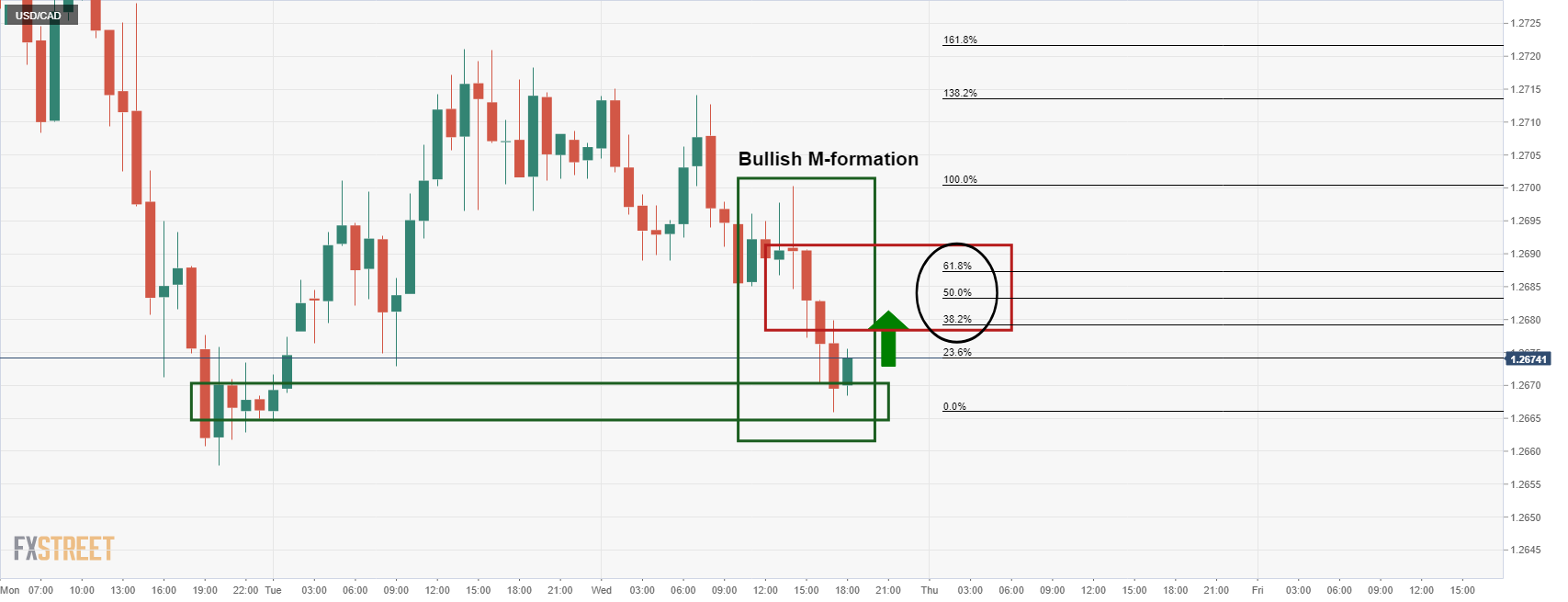
It was stated that ''the bulls are moving in as profits are taken off the table before the close of the North America session as traders will be keen to be square in the run-up to the critical US Consumer Price Index event in Thursday's morning New York trade. This raises prospects of a correction into the neckline of the M-formation where bulls can target the 1.2680's, namely the 38.2%, 50% and 61.8% ratios.''
USD/CAD live market
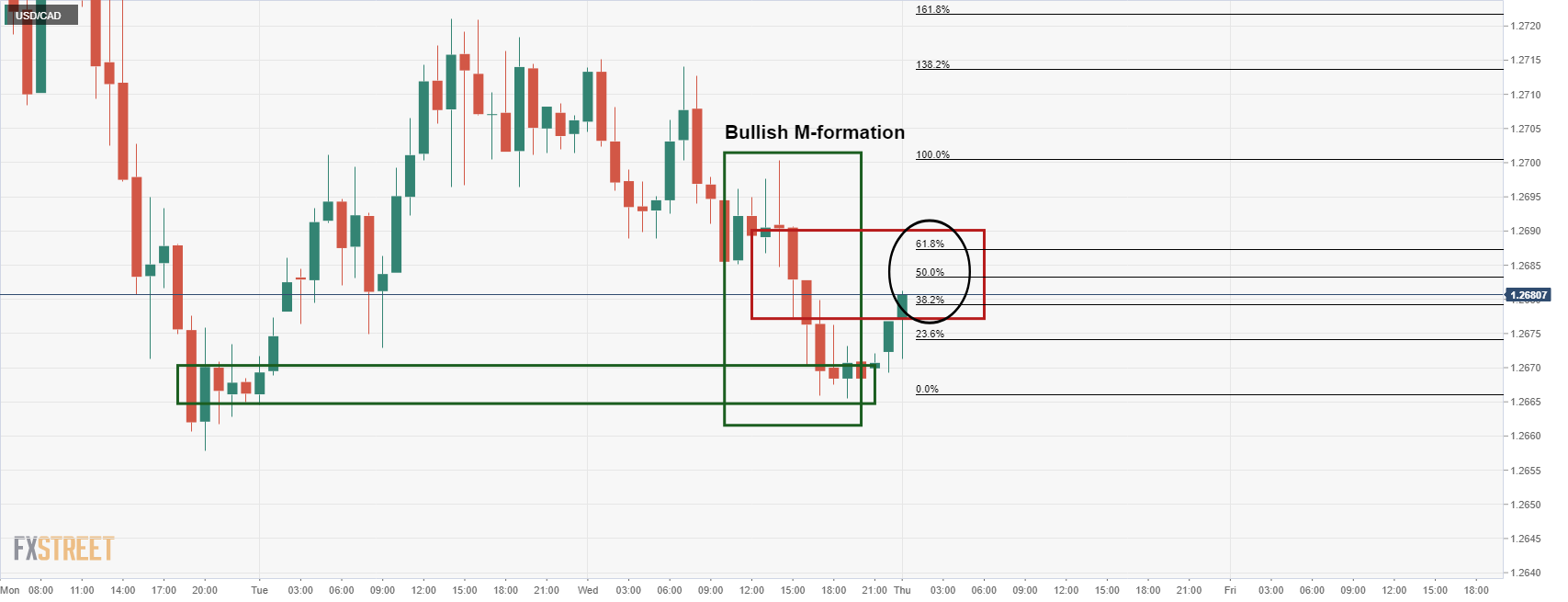
The price is moving in on the 38.2% ratio.
- AUD/USD struggles to extend three-day uptrend, as well as upside break of 50-DMA.
- Cautious sentiment ahead of US CPI challenge risk barometer pair.
- Australia Consumer Inflation Expectations rose for February, Aussie Senior Finance Executives expect RBA rate hike in 2022.
- White House comments, Fedspeak magnify inflation fears ahead of the key US January CPI release.
AUD/USD struggles for a clear direction around the three-week top, taking rounds to 0.7180 during Thursday’s Asian session.
The risk barometer pair refreshed a multi-day peak the previous day during a three-day uptrend as US dollar and Treasury yields eased ahead of crucial Consumer Price Index (CPI) data. However, pre-CPI caution supersedes upbeat Aussie data and expectations of RBA rate hikes to challenge the pair’s recent moves.
Australia’s Consumer Inflation Expectations for February rose past 4.5% forecasts and 4.4% prior readings to 4.6%. Also bullish for the AUD/USD pair is Deloitte’s latest bi-annual survey of Australia’s headline Chief Financial Officers (CFOs). “Around three-quarters of Australia’s senior finance executives expect an interest rate rise this year as the economy bounces back from the pandemic,” said the survey per Australian Associated Press (AAP).
Elsewhere, the White House (WH) conveyed expectations of a higher YoY inflation figure while also saying, “Its irrelevant month on month number will continue trending lower the rest of the year.” Following that, WH Economic Adviser Brian Deese said that he sees reason to think that factors boosting inflation will moderate over time.
Further, Cleveland Fed President Loretta Mester supported the March rate hike while Atlanta Federal Reserve President Raphael Bostic told CNBC on Wednesday he is hopeful that they will start to see a decline in inflation. Fed’s Bostic also said, "Leaning toward the need for a fourth interest rate increase in 2022."
It should be observed that recent escalation in the US-China trade tussles and fears over Russia’s invasion of Ukraine seems to take a back seat for now.
That said, the US 10-year Treasury yields pause the previous day’s pullback from the highest levels since July 2019 while the S&P 500 Futures remain indecisive despite Wall Street’s upbeat performance on tech-rally and strong earnings.
Moving on, AUD/USD prices can witness further headwinds ahead of the US CPI data for January, due to the pair’s risk barometer status. Any disappointment from the key figures, expected 7.3% YoY versus 7.0% prior, will be important to watch.
Technical analysis
Although a successful break of the 50-DMA, near 0.7165 by the press time, keeps AUD/USD buyers hopeful, a descending resistance line from late October 2021, around 0.7210, challenges the quote’s short-term recovery. It’s worth noting that a two-week-old support line near 0.7120 adds to the downside filters.
- USD/JPY prints three-day uptrend around fortnight top, picks up bids to refresh daily top.
- Market sentiment dwindles amid mixed concerns over inflation, geopolitics and covid.
- WH comments, Fedspeak rang alarms over CPI despite expecting easy figures in the long-term.
- Japan's PPI came in stronger but nothing matters more than the US CPI.
USD/JPY picks up bids to renew intraday high near 115.60 during the three-day uptrend. With this, the yen pair prints 0.07% gains on a day as markets brace for the US Consumer Price Index (CPI) data amid the initial hour of Tokyo open on Thursday.
The pair benefited from the sluggish US dollar and firmer Treasury yields to portray the recent upside momentum. However, upbeat factory-gate inflation at home and cautious mood before crucial inflation data keep the USD/JPY buyers worried of late.
That said, the US Producer Price Index (PPI) for January crossed market forecasts in January with 0.6% MoM and 8.6% YoY figures versus 0.4% and 8.2% expected respectively. The factory-gate inflation hits to the highest since September 1985.
Late on Wednesday, the White House (WH) conveyed expectations of a higher YoY inflation figure while also saying, “Its irrelevant month on month number will continue trending lower the rest of the year.” Following that, WH Economic Adviser Brian Deese said that he sees reason to think that factors boosting inflation will moderate over time.
It should be observed that Cleveland Fed President Loretta Mester supported the March rate hike while Atlanta Federal Reserve President Raphael Bostic told CNBC on Wednesday he is hopeful that they will start to see a decline in inflation. Fed’s Bostic also said, "Leaning toward the need for a fourth interest rate increase in 2022."
On a different page, virus conditions in Japan keep worsening and push the government to extend the latest quasi-emergency. “Japan will decide Thursday to extend by three weeks until March 6 a COVID-19 quasi-state of emergency for Tokyo and 12 prefectures as the nation scrambles to rein in infections caused by the highly contagious Omicron variant,” said Kyodo News.
Amid these plays, the US 10-year Treasury yields pause the previous day’s pullback from the highest levels since July 2019 while the S&P 500 Futures remain indecisive despite Wall Street’s upbeat performance on tech-rally and strong earnings.
Looking forward, USD/JPY may remain on the front foot as bond bears are likely to keep reins heading into the US inflation data. However, any disappointment from the key figures, expected 7.3% YoY versus 7.0% prior, won’t hesitate to weigh on the USD/JPY prices.
Read: US Consumer Price Index January Preview: Is this inflation different?
Technical analysis
A clear upside break of the monthly horizontal resistance bear 115.70 becomes necessary for the USD/JPY prices to remain firmer towards January’s top of 116.35. However, the pair sellers remain away until witnessing a break of a 13-day-old support line near 114.75.
| Pare | Closed | Change, % |
|---|---|---|
| AUDUSD | 0.71811 | 0.53 |
| EURJPY | 131.992 | 0.06 |
| EURUSD | 1.14231 | 0.07 |
| GBPJPY | 156.373 | -0.04 |
| GBPUSD | 1.35346 | -0.04 |
| NZDUSD | 0.66815 | 0.55 |
| USDCAD | 1.26698 | -0.26 |
| USDCHF | 0.92416 | -0.05 |
| USDJPY | 115.54 | 0.01 |
© 2000-2024. All rights reserved.
This site is managed by Teletrade D.J. LLC 2351 LLC 2022 (Euro House, Richmond Hill Road, Kingstown, VC0100, St. Vincent and the Grenadines).
The information on this website is for informational purposes only and does not constitute any investment advice.
The company does not serve or provide services to customers who are residents of the US, Canada, Iran, The Democratic People's Republic of Korea, Yemen and FATF blacklisted countries.
Making transactions on financial markets with marginal financial instruments opens up wide possibilities and allows investors who are willing to take risks to earn high profits, carrying a potentially high risk of losses at the same time. Therefore you should responsibly approach the issue of choosing the appropriate investment strategy, taking the available resources into account, before starting trading.
Use of the information: full or partial use of materials from this website must always be referenced to TeleTrade as the source of information. Use of the materials on the Internet must be accompanied by a hyperlink to teletrade.org. Automatic import of materials and information from this website is prohibited.
Please contact our PR department if you have any questions or need assistance at pr@teletrade.global.
